Paul Finch's Blog, page 13
February 11, 2018
Out and about in 2018: the big diary dates
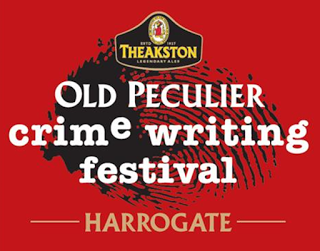 Okay, we’re well into 2018 now, and that semi-surreal period around Christmas and New Year feels as if it’s a long, long way behind us. Time now to get on with this year’s events. So, today I intend to talk about my calendar for the next few months, and the various public appearances I’ll be making, and the circumstances surrounding them. Sorry, if that sounds a little self-indulgent, but quite honestly, it’s in response to questions I get asked a lot – about when I’ll be out and about, when I’ll be able to sign books for people, and the like.
Okay, we’re well into 2018 now, and that semi-surreal period around Christmas and New Year feels as if it’s a long, long way behind us. Time now to get on with this year’s events. So, today I intend to talk about my calendar for the next few months, and the various public appearances I’ll be making, and the circumstances surrounding them. Sorry, if that sounds a little self-indulgent, but quite honestly, it’s in response to questions I get asked a lot – about when I’ll be out and about, when I’ll be able to sign books for people, and the like.Also today, I’ll be reviewing and discussing a very different kind of crime thriller, Andrew Taylor’s compelling historical murder mystery, THE ASHES OF LONDON.
As usual, you’ll find that review towards the lower end of today’s blogpost. Before we get there, as I threatened, here are some dates and venues that might be of interest if you ever feel like saying ‘hello’ face-to-face.
Be aware that this is probably an incomplete list at this stage. There may well be one or two cancellations, and there will certainly be one or two additions. In that regard, the only advice I can give is stay tuned, watch this space, etc etc.
On March 24, I’m honoured to be a guest at The Quad in Derby, where the Horror Writers Association will present PARTNERS IN CRIME .
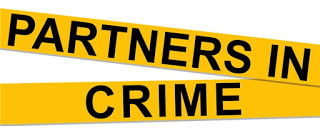 Through exclusive interviews, informative panel discussions and expert talks, attendees will be able to learn more about crime fiction’s edgier side, examining how thrillers have become darker, how serial killer fiction now tends to form a natural bridge between the two genres, and asking the question is there a place for the supernatural in crime fiction?, and if so, how can authors can benefit from this ever more visible overlap?
Through exclusive interviews, informative panel discussions and expert talks, attendees will be able to learn more about crime fiction’s edgier side, examining how thrillers have become darker, how serial killer fiction now tends to form a natural bridge between the two genres, and asking the question is there a place for the supernatural in crime fiction?, and if so, how can authors can benefit from this ever more visible overlap?There will also be the usual opportunities to purchase books and get them signed, and to socialise with authors and publishers.
At this stage, I’ll be involved in the following panel chats: I, Monster: Has the Serial Killer replaced the monster in modern dark literature? And: Taboo! How dark is too dark?
But of course, Partners in Crime isn’t just about me. Other guests include some fairly hefty names in the industry. Check these out: Stuart MacBride, Fiona Cummins, AK Benedict, Steph Broadribb, Barry Forshaw, SJ Holliday, Joe Jakeman, David Mark and Roz Watkins.
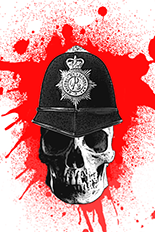 May 17-20, I’ll be at
CRIMEFEST
in Bristol. For the first time in what seems like ages, I’m neither guesting on a panel nor chairing one during this festival, so I guess that means I’ll have more bar-time if anyone wants to chat.
May 17-20, I’ll be at
CRIMEFEST
in Bristol. For the first time in what seems like ages, I’m neither guesting on a panel nor chairing one during this festival, so I guess that means I’ll have more bar-time if anyone wants to chat.For anyone who’s not been to CrimeFest (where the pen is bloodier than the sword), it’s a great event if you’re interested in crime fiction, either as a reader or a prospective writer – and it’s for occasional fans too, not just the die-hard fanatics. It’s certainly now become one of the biggest crime fiction events in Europe, and it’s no surprise that every year it draws top crime novelists, editors, publishers and reviewers from around the world, giving all delegates the opportunity to celebrate the genre in a friendly, informal and inclusive atmosphere.
The two guests-of-honour this year will likely have copies of their books on almost every crime enthusiast’s shelves: Lee Child and Jeffery Deaver.
On June 14, I’ll be at the CROSSING THE TEES Book Festival. This is a large-scale literary event organised by the library services of Stockton, Middlesbrough, Hartlepool, Redcar & Cleveland, and Darlington. It’s early days on this one so far, so I’ve not got any detail about my own role in this grand event yet, or a comprehensive list of the other guests, but can guarantee that it will be worth attending at some point if you enjoy books. It runs from June 9-24, and includes all kinds of author events, workshops, lectures, readings, competitions and the like.
July 19-22, I’ll be making my annual trip to Harrogate for the THEAKSTON OLD PECULIAR CRIME WRITING FESTIVAL .
 In short, this is one of the biggest of them all, and is a massive celebration of the genre, which has deservedly won huge international acclaim. The event is also known for its no barriers approach, as fans, writers – both newcomers and established superstars – agents, publishers and editors mingle in the hotel bar, bookshop and the huge pavilions set up in the grounds of the historic Swan Hotel in the leafy heart of Harrogate (pictured above).
In short, this is one of the biggest of them all, and is a massive celebration of the genre, which has deservedly won huge international acclaim. The event is also known for its no barriers approach, as fans, writers – both newcomers and established superstars – agents, publishers and editors mingle in the hotel bar, bookshop and the huge pavilions set up in the grounds of the historic Swan Hotel in the leafy heart of Harrogate (pictured above). Again, there’ll be panels, discussions, author interviews, interactive events and all kinds of activities in the bar areas. Perhaps the most attractive feature of the Harrogate event is the accessibility it provides to some of the biggest names in the business. For example, the first headliner announced for this year is powerhouse US author, Don Winslow (right).
Again, there’ll be panels, discussions, author interviews, interactive events and all kinds of activities in the bar areas. Perhaps the most attractive feature of the Harrogate event is the accessibility it provides to some of the biggest names in the business. For example, the first headliner announced for this year is powerhouse US author, Don Winslow (right).That alone should be reason for many crime fans to flock there. But the main thing is, you can doorstop these guys and girls and simply chat to them. If they weren’t prepared for that, they wouldn’t be there. And of course, this can be even more useful if you’re a new writer looking for an agent or a publisher – because they are there to, and, whereas in real life, it’s often difficult to get any kind of meeting with these folks, at Harrogate all you need to do is say hello.
And say it to me as well, if you wish – because as I say, I’ll be mingling there with everyone else.
Two crime fiction events coming up in the latter half of the year, which I’m hopeful of attending – but not absolutely certain of this stage – are BLOODY SCOTLAND, the annual Caledonian Crime-Writing Festival, which is held in Stirling from September 21-23, and MORECAMBE & VICE, at the incredibly atmospheric venue of the Morecambe Winter Gardens on September 29-30.
Last on the diary (so far), but not by any means least, we have a slight change of pace, with FANTASYCON at Chester, October 19-21, when I’ll be wearing my horror hat.
For those not aware, Fantasycon is another of the great annual literary events, attended by writers both great and small, agents, editors, publishers and the like, though this one concentrates on fantasy fiction (which also includes horror and sci-fi). Given that this is late October, it’s a little early in the day for me to provide any details – either concerning guests of honour, specific events, book launches and the like, or what I myself will be doing there (most likely I’ll just be an everyday delegate, happy to hold up the bar and chat). Again, for more info, watch this space.
THRILLERS, CHILLERS, SHOCKERS AND KILLERS …
An ongoing series of reviews of dark fiction (crime, thriller and horror novels) – both old and new – that I have recently read and enjoyed. I’ll endeavour to keep the SPOILERS to a minimum; there will certainly be no given-away denouements or exposed twists-in-the-tail, but by the definition of the word ‘review’, I’m going to be talking about these books in more than just thumbnail detail, extolling the aspects that I particularly enjoyed … so I guess if you’d rather not know anything at all about these pieces of work in advance of reading them yourself, then these particular posts will not be your thing.
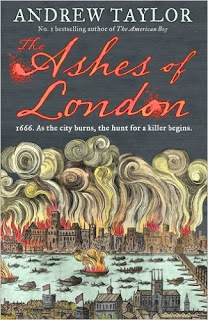 THE ASHES OF LONDON
THE ASHES OF LONDON
by Andrew Taylor (2017)
It is 1666 and London is burning. Apparently, it ignited by accident, but it’s burning nonetheless … from the Tower to the Temple Bar, the wailing populace struggling to escape as their homes and workshops succumb to the flames.
But even without the fire, these are turbulent times in England. After an exhausting civil war and then years of Cromwellian rule, the Stuarts are back on the throne in the form of the affable Charles II, but enemies of the crown are never far away. Puritan forces linger in the shadows, some more dangerous than others, such as the Fifth Monarchists, a fanatical clique who were not just involved in the execution of Charles I – ‘the Man of Blood’, as they called him – but who are also keen to see his son dead, thus clearing the way for the accession of ‘King Jesus’ and ushering in a reign of Heaven on Earth.
Against this difficult and dangerous background, what is one more death? But even in the midst of the fire, attention is captured by the discovery in the ruins of St Paul’s of a man who has been ritually assassinated, his thumbs tied together behind his back before he was stabbed.
The authorities have a bit too much on their plate to be overly interested in this, but it isn’t simply ignored, the investigation put into the hands of one James Marwood, a young man who on the outside doesn’t seem like much of a sleuth. Ostensibly, he’s an ordinary chap who is simply trying to make his way in the world, with zero interest in the affairs of state, but his is a more complicated path than most. The son of a republican activist who was ruined financially by the restoration of the monarchy, not to mention in terms of his reputation and health, James Marwood now works as a clerk for Joseph Williamson, chief propagandist for the Royal Court, in the pamphleteer office at Scotland Yard, where he is trusted but treated brusquely.
The authorities are well aware of James’s past, of course, and perhaps have employed him on the basis that it’s advisable to keep your friends close and your enemies closer still. But he now becomes even more useful for them. Detecting the hand of republican extremism in the recent murder, they assign James to the case because it’s deemed possible that his family may still have contacts in that secretive world.
At the same time, in what is initially a parallel storyline, we meet Catherine Lovett, or ‘Cat’ for short, the daughter to and heiress of Tom Lovett, a one-time Cromwellian soldier and ‘regicide’ – in other words he was directly involved in the execution of Charles I, and therefore can never be pardoned – who is currently in hiding. Almost oblivious to this background chicanery, Cat, who commences the book as an adventurous but on the whole fairly innocent girl, wants only to design buildings and study architecture, though alas, even these simple dreams are far from being realised. In the absence of her father, she is the unhappy ward of her wealthy aunt and uncle, Olivia and Henry Alderley, the latter of whom wants only to marry her off and be done with her. As if that isn’t distressing enough, Cat’s odious cousin Edward is increasingly interested in her, and when he finally rapes her, and she retaliates by half-blinding him, she flees into what remains of the smouldering city and seeks out a new (inevitably much harsher) life for herself.
We know these personal journeys are going to entwine at some point, but The Ashes of London is such a plot-driven novel that to give any more detail at this stage would be the ultimate spoiler. Suffice to say that all kinds of skulduggery follows, James and Cat pursuing their own meandering and perilous paths through a world of intrigue as they are drawn steadily together.
In addition, endless fascinating and outrageous characters take the stage. Cat comes under the paternalistic spell of a kindly but ailing draughtsman, Hakesby, who, alongside the legendary Christopher Wren (who also makes an appearance), is charged with re-designing the burned-out cathedral. James, meanwhile, is introduced to the devious William Chiffinch, another real-life personality and one of Charles II’s most accomplished fixers. When the king himself arrives, it is in dramatic and amusing fashion, which is the way it should be, because though his is little more than a glorified guest-appearance, Charles II, as the embodiment of the Stuart royal line, remains essential to the narrative.
While all this is going on, of course, the murder plot thickens, the bodies piling up, Marwood’s suspicions spreading in all directions, particularly where high-end political machinations may be found (yes, this is a conspiracy thriller as much as a murder mystery). And all the way through there is a growing sense of jeopardy. Neither Cat nor James have such status that they command power, and even though James represents power, it is not always around to assist him when he needs it. So, it isn’t just the villains of the piece – an increasingly dangerous and deranged threat, we sense – who provide the menace. Bad things can befall almost anyone, for near enough any reason, if they poke their noses deep enough into the ashes of London …
The Great Fire of London is a disaster that is branded into the psyche of most Britons, even those who are not overly familiar with the historical period. It was a monumental event for all kinds of reasons, and a milestone in the emergence of the Modern Age, not least because it cleared away what remained of the old medieval city and allowed visionaries like Christopher Wren to build something vastly more advanced. But it’s important to remember that just because the city that burned was centuries old at the time, it was not some miniature wattle-and-thatch market-town, some tangle of narrow streets and muddy courts on the banks of the Thames. It was already colossal in size, a megalopolis that was home to 80,000 people, 70,000 of whom were rendered homeless by the 1666 disaster.
Little wonder this event was viewed at the time as a national catastrophe, especially because it came on the coat-tails of the Black Death, and so was viewed by religious extremists as part of a double-punishment imposed by God for the lax morality of the Restoration era.
Britain in the mid/late 17th century was certainly a cradle of fundamentalism, a land divided between various religious groups, (most of them Protestant, while Catholics were regarded as traitors who deserved to be lynched simply for being Catholic!). Oliver Cromwell’s dictatorial rule was over and the Royalists were back in power, but the Puritans had not gone away. Though most had officially been forgiven for their roles in the Civil War, countless gentleman still held positions of authority even though their loyalty was suspect, while remnants of the brutal Roundhead army lurked among the general populace, in some cases functioning like miniature crime syndicates. In a time and place when it was an offence just to hold an opinion, the king’s spies were everywhere. London was a city of informers, and no-one trusted anyone else.
And then the fire came, a conflagration quite literally – or so it seemed – from Hell.
And it is this epic sprawl of religious and political intrigue, not to mention the incendiary atmosphere of a truly pivotal moment in British history, that Andrew Taylor captures so perfectly in The Ashes of London . But don’t for one minute assume that this means it’s a history lesson. From the very beginning, this is a fast-moving mystery, with living and breathing characters striking sparks off each other as they wend their labyrinthine ways through a capital city (what’s left of it!) filled with danger and deception.
And yet the richness of historical detail is all here, blended seamlessly into plot and dialogue. For example, we come to understand the destructive power of the fire because when it’s over, we trudge the desert of cinders for ourselves. We see what a Machiavellian hive the Palace of Whitehall was because we view it, if not simply through the eyes of hero, James Marwood, who only ever receives information on a ‘need to know’ basis, but via the manners and methods of crafty functionaries like Williamson and Chiffinch. We understand what a focal point of English religious life the original Cathedral of St. Paul’s was because we feel the horror of the awe-stricken crowd as it goes up in flames.
This novel is an out-and-out feast for historical fiction fans, awakening that brief window of time more effectively than any number of textbooks I could name. But for those who are simply here for the thrill of an intense, clue-driven investigation, it won’t disappoint on that level either, telling us a fascinating detective story and setting it against a richly-coloured and yet easily accessible tableau of the past.
As alluded to earlier, it would be erroneous of me to give too much away about the plot as that would spoil the reading experience. It’s complex for sure, but deeply engrossing – you literally never know where the next twist is going to come from. And it helps, of course, that the lead characters are so engaging.
James and Cat, are far from being stock historical heroes, both completely aware of their standing in this unforgiving world, and yet each with their own quirks. The former commences the narrative in a lowly position, but he’s inquisitive by nature and inordinately perceptive, and he grows rapidly into his role of unofficial but opinionated Scotland Yard investigator. The latter is ripped from pillar to post by forces beyond her control, and suffers lasting damage as a result –a realistic appraisal, perhaps, of what it would actually mean to be ‘bodice-ripper’ heroine – and yet she remains feisty and spirited throughout, and at times maybe a little more than that; by the end of this novel, one wouldn’t want to cross Cat Lovett unnecessarily.
The rest of the cast are equally striking, both the real and fictional mingling believably together, all drawn clearly and, perhaps in the way of true life, none of them especially more likeable than the next as they all ultimately look out for themselves. Most interesting of all, maybe, are James and Cat’s two fathers, men who very vividly represent the moral complexities of their age; both are driven by a sincere devotion to an idealised vision of Jesus, but they are heavily politicised too, and so battered by war and oppression that Christian sentiment rarely manifests itself in their actions. Though perhaps the deepest irony where Tom Lovett and old Marwood are concerned is that, given they are both Bible men, neither seems remotely aware of that most prescient warning of the good book: that the sins of the fathers will be visited on their children.
The Ashes of London is an enthralling and informative read. Elegantly written, deeply atmospheric of its period, and yet rapid-fire in terms of its unfolding action and events. I found it utterly compelling, and have no hesitation in giving it my highest recommendation.
As usual, I’m now going to attempt to cast it. This is just for fun, of course (as if any casting director would take note of my views). I have no idea if The Ashes of London is being lined up for film or TV adaptation, but it really ought to be. Here are the actors I would call:
James Marwood – James NortonCat Lovett – Daisy RidleyHakesby – Geoffrey RushWilliamson – Jim CarterChiffinch – Charles DanceHenry Alderley – Jonathon PryceOlivia Alderley – Maria BelloOld Marwood – Patrick StewartTom Lovett – Bernard Hill Charles II – Julian Sands
Published on February 11, 2018 05:30
January 14, 2018
Seeing 2018 through should be a real blast

Okay, I hope everyone had a great Christmas, and happy New Year to you all. I trust you’re all ready to tackle 2018 with the vim and vigour required. Personally, I’m looking for an explosive year, this year – though, by that, I should state that I mean in book terms.
KISS OF DEATH, the seventh DS Heckenburg novel, is published in August this year, and I can promise you now, it’s going to be a big ’un – in every sense of the word. But more about that in a few paras. Also on the subject of explosive thriller fiction, I’m kicking off the New Year by reviewing Terry Hayes’s mesmerising I AM PILGRIM, one of the best international actioners I’ve read in a long, long time.
As usual, you’ll find that review towards the lower end of today’s blog. If that’s all you’re here for, be my guest and skip down there to check it out straight away. But if you’ve got a few minutes to spare first, hang around here, because I’ll also be including a guest-blog I wrote for the FOR WINTER NIGHTS blog back in April last year, in which the question was put to me: What Seven Things Should You Know if You Want to Write Crime Fiction?
But before that …
Though I say it, myself
Even though I say so, myself, KISS OF DEATH is going to be a major event in the Mark Heckenburg story.
Those who’ve followed Heck’s investigations from the beginning (the first one, STALKERS , was published by Avon at HarperCollins way back in February 2013) will be aware that he is now at the end of his thirties, but still, despite some jumping about en route, a detective sergeant with the Serial Crimes Unit, which in its turn is part of Scotland Yard’s National Crime Group.
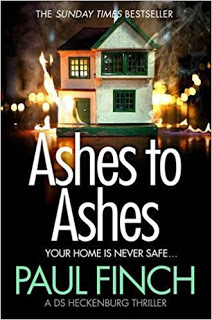 It wouldn’t be true to say that Heck has had a chequered career, thus far; he’s had some great results, but there’ve been fireworks too. This is partly down to his penchant for going it alone, bending the rules and taking chances. However, if you haven’t read Heck yet, don’t go away from that under the impression that he’s a British version of Dirty Harry. Heck is not some humourless bully or cold-blooded killer. He’s affable and easy-going, but only with
ASHES TO ASHES
(the sixth outing), did we fully become aware just how affected and damaged he is by events in his early past.
It wouldn’t be true to say that Heck has had a chequered career, thus far; he’s had some great results, but there’ve been fireworks too. This is partly down to his penchant for going it alone, bending the rules and taking chances. However, if you haven’t read Heck yet, don’t go away from that under the impression that he’s a British version of Dirty Harry. Heck is not some humourless bully or cold-blooded killer. He’s affable and easy-going, but only with
ASHES TO ASHES
(the sixth outing), did we fully become aware just how affected and damaged he is by events in his early past.Fortunately, he’s always had Gemma Piper to lean on. His ex-girlfriend, who once worked with him as a fellow detective constable at Bethnal Green police station, Gemma has since rocketed to police superstardom and is now the detective superintendent in charge of the Serial Crimes Unit (SCU). They still care a lot for each other, but they don’t often show it, this unspoken chemistry leading them to fight like cat and dog over matters of procedure and morality. Gemma, the ultimate straight-player, is adamant that she will keep Heck on the straight and narrow, while Heck is equally adamant that what Gemma doesn’t get to know about his more ‘out there’ investigations will never actually hurt her.
From an authorial point of view, it’s a relationship between my two lead characters which has worked very well, and which I think has given the ongoing story-arc depth and impetus. Whether two people in real life could exist in this constant state of love/war, especially when they are pursuing some of the most vicious and relentless killers in Britain, is another matter, but hey, this is fiction.
When we get to KISS OF DEATH, though, the whole of the Serial Crimes Unit, not just Heck and Gemma, is under a degree of pressure it has never known before.
It’s 2018 of course, and the austerity that has denuded the police service of so many front-line officers and whittled away at specialist departments has finally come to the National Crime Group. NCG Director, Joe Wullerton, argues daily with the National Police Chief’s Council for the continuation of his department, which does not just track serial killers through SCU, but also contains the Kidnap Squad and the Organised Crime Division. When he puts it to the powers-that-be that to close NCG would be to drastically reduce the police forces of England and Wales’ effectiveness in their fight against the most heinous criminals and their gangs, there is sympathy – but sympathy alone doesn’t pay bills.
Feeling that some pro-action is required on her part, Gemma Piper opts to join forces with the Metropolitan Police’s Cold Case Team who are also facing the axe, and proposes the creation of a temporary task-force dedicated to pursuing the twenty worst British offenders still on the loose, with a remit to get rapid and impressive results.
 With the clock ticking, Heck finds himself in partnership with Detective Constable Gail Honeyford, a new recruit to SCU (though he worked with her once before in
HUNTED
, 2015), and someone he likes for her spirit and nous, but whom he also finds bolshy and hot-headed. Their particular target is Ed Creeley, a notorious bank-robber and many-times murderer, who went to ground in 2014 and hasn’t been seen since, though he is still believed to be at large in the UK. Their pursuit of this pitiless hoodlum takes them all over the country, from Humberside to the East End of London, and eventually even to Cornwall, all the way encountering ever more reprehensible villains, ever greater dangers, and increasingly, uncovering clues that something absolutely appalling is happening the United Kingdom – as yet unknown to the British authorities, but which, when they finally discover it, will literally rock SCU (and most other police agencies) to the foundations.
With the clock ticking, Heck finds himself in partnership with Detective Constable Gail Honeyford, a new recruit to SCU (though he worked with her once before in
HUNTED
, 2015), and someone he likes for her spirit and nous, but whom he also finds bolshy and hot-headed. Their particular target is Ed Creeley, a notorious bank-robber and many-times murderer, who went to ground in 2014 and hasn’t been seen since, though he is still believed to be at large in the UK. Their pursuit of this pitiless hoodlum takes them all over the country, from Humberside to the East End of London, and eventually even to Cornwall, all the way encountering ever more reprehensible villains, ever greater dangers, and increasingly, uncovering clues that something absolutely appalling is happening the United Kingdom – as yet unknown to the British authorities, but which, when they finally discover it, will literally rock SCU (and most other police agencies) to the foundations.*
And now for something a little bit different …
As I mentioned earlier, I wrote a guest blog-post for FOR WINTER NIGHTS last April to accompany the publication of ASHES TO ASHES . It seemed to go down very well, so, for those of you who didn’t see it the first time, here is is again:
What seven things should you know if you want to write crime fiction?
Well, it’s an interesting question, and certainly one I haven’t been asked before. Off the top of my head, I can think of seven things it might be useful for you to know. I wouldn’t say that these are the seven most important things, but it probably wouldn’t do you any harm to be forearmed, as they say. So here we go…
1) Guilt goes with the territory
This may seem a curious thing to say, but it reflects reality. By its nature, crime and thriller writing deals with the darker end of the human experience. It won’t just be routine wickedness you are exploring. Whether your lead characters are heroes or villains, they’ll be dicing with danger, skating along the edge of the abyss, doing all kinds of things that law-abiding citizens in normal life never would. Now, if you want your writing to be authentic, you’ve got to go the extra mile to ensure that you get the facts of these matters correct.
 That will entail lots of online research into areas you wouldn’t usually go anywhere near, such as the formation and organisation of criminal empires, the methods and modus operandi of serial killers, the anatomies of the world’s most successful bank robberies and/or assassination plots, the use and availability of illegal firearms, the impact upon human bodies of poison, nerve gas, biological weaponry, the formation of police investigation teams and the emergency procedures they follow, the complexities of drugs-trafficking, the risk and probability of terrorist attacks, and the depth and breadth of those security shields that protect western cities against such catastrophic threats.
That will entail lots of online research into areas you wouldn’t usually go anywhere near, such as the formation and organisation of criminal empires, the methods and modus operandi of serial killers, the anatomies of the world’s most successful bank robberies and/or assassination plots, the use and availability of illegal firearms, the impact upon human bodies of poison, nerve gas, biological weaponry, the formation of police investigation teams and the emergency procedures they follow, the complexities of drugs-trafficking, the risk and probability of terrorist attacks, and the depth and breadth of those security shields that protect western cities against such catastrophic threats.All of this is going to make fascinating reading, of course, for a security expert should he/she ever have call to examine your online activity. You will have the excuse that you’re a crime writer and that it’s all part of the game, but that doesn’t mean you won’t feel a tad nervous when you’re indulging in it.
2) You’ll be challenged on facts
Never has the phrase ‘facts matter’ been more relevant than it is to the average crime/thriller writer. One of the most basic problems you have as an author in this field is that you’re straying into a fascinating, complex world which also, rather inconveniently, happens to be real. So, for example, you may be delving into law enforcement with all the procedures, protocols and legalities inherent to that. If you think that’s tough, you may also find yourself concerned with military matters, or security issues involving international law, the intelligence services and/or spec ops deployment. Medical and forensics questions will almost certainly arise; you may need to discuss weapons, explosives and the like. But the real problem is that you’ll likely encounter real-life people in your everyday world who have expertise in these fields, and if you get things wrong, they may call you to account – sometimes in public.
While it’s not incumbent on you to become a guru in these matters, it would certainly help if you did some basic research. Whatever you do, don’t wing it.
(I will add that it won’t matter quite so much with the likes of MI6 and/or the SAS, as they’ll never comment anyway, and almost certainly will be delighted if you spread misinformation about their techniques).
3) You can chat to those who know
Library and internet research may help you factually, but it’s often a dry process and is unlikely to hit you from left-field with cool new ideas. In contrast, speaking to someone who’s actually done unusual things in his/her life can be much more fruitful. And the good thing is, with the exception of those ultra-secret organisations I mention above, most members of the security services are happy to chat about it, though they only tend to do so if approached … so don’t feel awkward about trying to pick their brains.
Police officers or ex-police officers are particularly good in this regard. I have a slight advantage here as an ex-copper, in that they may feel they can trust me more with the really juicy stuff, but I’d be surprised if the majority weren’t willing to have a chat with any writer. There may be certain areas they won’t go if they don’t already know you, but on the whole I think they’ll be willing to talk widely and informatively about their job. Never make the assumption that they’ll think you’re silly. They won’t. Many coppers I know also read crime fiction, while others would like to write – to immortalise their own exploits – but can’t, and so become very protective of writers they form relationships with, as they see that as the next best thing.
 4) It is not a solitary profession
4) It is not a solitary professionThe semi-mythical image of the writer slugging on alone in his/her attic, virtually penniless and with no one to call a friend, particularly does NOT apply to the crime/thriller writer. I mean, I can’t comment on the ‘penniless’ bit – that all depends on your personal circs, but you DO have friends.
In all the literary fields, I’ve never known anywhere where the networking between practitioners is quite as vibrant as it is in crime and thrillers. There are literally hundreds of authors writing this material at professional level, both at home and overseas, and they’re all doing exactly the same things you are: hammering away at their keyboards, proof-reading, flipping through websites on the research trail, chatting things over with their agents and editors – and not always to their personal satisfaction. More importantly, thanks to the internet, most of these men and women are now connected. There are all kinds of online crime-writer clubs you can join, places where friendships are made, experiences aired and info shared (including info about which publisher has a new slot available, or which editor is looking for what, which can be very useful indeed). This is a great way to relieve pressure, because it shows that you aren’t the only person struggling with writer’s block, or character development, or just with the sheer physical effort of trying to finish a full-length novel inside a tight deadline. Likewise, there are many crime fiction conventions and festivals you can attend, and crime-writing societies you can join. A burden shared is a burden halved and all that, on top of which a lively social life, especially when it’s crammed with folk who all share the same interest as you, can only improve your quality of life.
5) Readers can take as much as you can give them
Don’t be lulled into thinking that, just because certain sub-genres within the overarching genre of crime writing are cosier than others – a good example being the ‘village green murder mystery’ – you have to handle your readers with kid gloves. In short, it’s quite the opposite.
One of the best examples of village green-style crime fiction in the modern day is the TV series, Midsomer Murders, and look at the body-counts in that, not to mention the various methods of dispatch. We’ve seen people killed with farm-tools, sliced, diced, decapitated, churned up by combine harvesters. One poor chap was beaten to death with cricket balls fired at him out of a batting machine. Crime readers, whatever style they prefer, are generally speaking a ghoulish bunch, who are here to enjoy a dalliance with the darkness. So, don’t hold back. As long as you don’t deal with death in juvenile fashion, you can, on the whole, pile on the grimness and violence. I mean, personally I’m a great believer in less being more, but I don’t think you can pussy-foot around the subject of murder, especially in this modern age when ‘true crime’ is so popular – and there ain’t nothing gorier than ‘true crime’.
So, if you feel you need to lay it on, don’t worry about the sensibilities of your readers. Lay it on.
6) Crime writing is a very broad church (no pun intended)
So many people who don’t read crime/thriller fiction have complete misconceptions about it. They immediately think Agatha Christie and the traditional English whodunnit. That is undeniably there and is very popular.
 Sidney Chambers, the crime-fighting village vicar of James Runcie’s Grantchester Mysteries, still embodies something of that atmosphere, and his adventures sell widely. But there are other fields too. Our fictional crime-fighters, like crime-fighters in real life, vary across the spectrum – from sticklers for procedure and crusaders of correctness to embittered louts who are never any better than they need to be and subsequently walk tightropes through a world of crime and sleaze. It doesn’t even stop there; often we use hardboiled PIs as our models, the smart-mouthed heroes created by James Crumley, Mickey Spillane and Raymond Chandler, who are no strangers to the seediest worlds imaginable and will play by any rules to win. Sometimes the villains themselves are our central characters. The violent gangland thrillers of Ted Lewis, Malcolm Mackay and Howard Linskey perfectly exemplify this.
Sidney Chambers, the crime-fighting village vicar of James Runcie’s Grantchester Mysteries, still embodies something of that atmosphere, and his adventures sell widely. But there are other fields too. Our fictional crime-fighters, like crime-fighters in real life, vary across the spectrum – from sticklers for procedure and crusaders of correctness to embittered louts who are never any better than they need to be and subsequently walk tightropes through a world of crime and sleaze. It doesn’t even stop there; often we use hardboiled PIs as our models, the smart-mouthed heroes created by James Crumley, Mickey Spillane and Raymond Chandler, who are no strangers to the seediest worlds imaginable and will play by any rules to win. Sometimes the villains themselves are our central characters. The violent gangland thrillers of Ted Lewis, Malcolm Mackay and Howard Linskey perfectly exemplify this.So, there you have it; we range from those quintessential leafy villages in the heart of Middle England to urban hells populated by addicts, prostitutes, contract killers and corrupt politicians. Oh yes, we’ve got it all. Feel free to explore at random.
 7) There is no requirement to write on the side of good
7) There is no requirement to write on the side of goodAs I intimated in earlier paragraphs, we are not, as authors, bound by real-world morality.
For my money, one of the best crime thrillers ever written is Jack’s Return Home by Ted Lewis, which was published in 1970 but filmed in 1971, perhaps more famously, as Get Carter. It tells the tale of a mobster from the North of England who makes good in London, but when his brother is murdered back home, gets on a train in a quest for gangland justice. What follows is a brutal, gritty noir filled with anger and darkness, and in the character of Jack Carter, it gives us an amoral and uncompromising hero, a cold-blooded hardman who is only different from the evil hoodlums he finds himself gunning for because his personal code of ethics is marginally more admirable than theirs.
But hey, this again reflects reality. You’ve doubtless heard the phrase ‘it takes a wolf to catch a wolf’. Well, we crime authors mustn’t be ashamed of putting that into practice. Morally ambiguous heroes are often far more interesting than those goodie two-shoes of the old school. In any case, as I say… this is fiction, not real life, so it doesn’t matter anyway. If that’s what you want to do with your book, go for it.
*
THRILLERS, CHILLERS, SHOCKERS AND KILLERS …
An ongoing series of reviews of dark fiction (crime, thriller and horror novels) – both old and new – that I have recently read and enjoyed. I’ll endeavour to keep the SPOILERS to a minimum; there will certainly be no given-away denouements or exposed twists-in-the-tail, but by the definition of the word ‘review’, I’m going to be talking about these books in more than just thumbnail detail, extolling the aspects that I particularly enjoyed … so I guess if you’d rather not know anything at all about these pieces of work in advance of reading them yourself, then these particular posts will not be your thing.
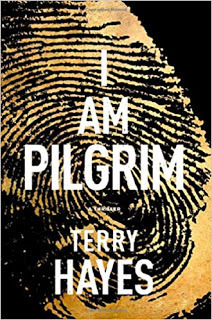 I AM PILGRIM
I AM PILGRIM by Terry Hayes (2014)
‘Pilgrim’, aka ‘Jude Garrett’, ‘Scott Murdoch’, ‘Pete Campbell’ and in inner spy circles, the ‘Rider of the Blue’, is the enigmatic man who wrote the ultimate manual on forensic analysis. He’s also the offspring of a murder victim and the adopted son and heir to a New England multi-billionaire, while, career-wise, he’s a US intelligence agent, who, even though he’s still very young, is so formidably skilled and experienced, and boasts such an exemplary track record (which included his termination of a powerful and highly dangerous double-agent based in Moscow) that it has earned him the ear of US presidents.
Technically speaking, however, it’s all over for Pilgrim. He’s done, retired, looking forward to a life of bohemian anonymity in the garrets and backstreets of Paris.
But then, over in Manhattan, Detective Ben Bradley, locates the body of a murdered woman whose corpse has been completely depersonalised by the very same CIA-inspired methods that Pilgrim specified in his seminal book, her teeth removed, her fingerprints and facial features erased with acid, and all traces of the killer’s DNA obliterated by judicious use of antiseptic.
Pilgrim – though he isn’t going by that moniker at this early stage – is a lonely and tortured individual, whose empathetic nature was at the root of his seeking an alternative career, and who yearns to forget his past, though now he is inevitably forced back onto the job to assist Bradley’s investigation. After that, it isn’t long before he finds himself embroiled in a connected but much larger and potentially massively more devastating case … which takes us neatly onto I Am Pilgrim ’s other main thread, the personal and political development of an ambitious and determined terrorist, who will also go by a conveniently simple nickname: ‘Saracen’.
After a deprived boyhood in the repressed police state that is Saudi Arabia, which culminates in his having to watch the public decapitation of his father for the unforgivable offence of criticising his nation’s rulers, Saracen finds himself growing up with a fierce hatred for the Saudi royal family, and perhaps inevitably (and far more zealously), for their most committed western ally, the United States of America.
A fully trained doctor by adulthood, but increasingly immersed in the more extremist tenets of Islam, Saracen eventually falls out with what remains of his family (his mother needing to get a job is the final straw!), and he leaves home determined to join the jihadi fight, which he does with a vengeance, soon finding kinship with the Taliban and entering the war in Afghanistan as a soldier of God.
However, Saracen, much like Pilgrim (though this is the only similarity between them), is an obsessive intellectual of his craft, and the winning of minor battles and launching of successful but relatively insignificant terrorist outrages feels like small potatoes. Eager to carry his war into the very heart of his enemy’s domain, and if possible, to destroy it completely, the only solution, as Saracen sees it, is to develop and deploy a bio-weapon of such magnitude that the might of the US will simply collapse beneath its onslaught.
He settles on a new, vaccine-proof and horrendously contagious strain of the smallpox virus (which he unleashes on a batch of human test-subjects in what is surely one of the ghastliest scenes that’s ever been committed to paper).
Back in the States, Pilgrim and his various government informers don’t get wind of this fiendish plot straight away, but when they do, a twisting, turning, continent-hopping duel commences, which ranges from the US to Europe to Asia and the Middle East, taking in a variety of amazing locations en route, including Syria, Switzerland, Bahrain, the bleak, savage mountains of the Hindu Kush, and a hypnotically beautiful Roman ruin on the edge of the glimmering blue Aegean. Ironically, Pilgrim and Saracen don’t meet until near the end of the book, but this doesn’t stop either of them engaging in numerous conflicts on the way, via flashback and subplot and through various proxies, though ultimately we finish up in a shattering, race-against-the-clock, one-on-one climax, which, if I was to say more about it here would be the ultimate spoiler …
The Guardian said of I Am Pilgrim that it’s ‘the only thriller you need to read this year’. Speaking as a gobbler-up of thrillers, I wouldn’t go quite that far, but I do know what they mean. Everything about Terry Hayes’s astonishing debut novel is epic: its size, its concept, its cast of characters, its range of locations, its terrifying and exhilarating action sequences, and even its subtext, which is huge if fairly simple: those with greater power and wisdom than most must shoulder greater responsibility than most, and their not wanting to is basically irrelevant (not that they may necessarily have a choice in the matter).
This is big stuff all the way through, a colossal struggle between two born-to-it masters of their trade, neither of whom will ever take a backward step because they know no other way, and all played out against the majestic canvas of Europe and the Middle East in the age of wide-ranging espionage and terrorism.
On this basis alone, it might be understandable if some readers were put-off exploring this novel any further, perhaps suspecting an all-too-familiar mishmash of James Bond and Jason Bourne. But that would be an error, because I Am Pilgrim is an astonishing, multi-layered tale of conflict and belief, which is vivid, realistic and totally gripping for the entire duration of its 600 plus pages.
It’s no surprise at all that Hollywood has already got its hooks into it.
That isn’t to say that it hasn’t come in for criticism in certain quarters. The sheer length of the book has been described as OTT, while its excessive detail and numerous side-stories have been called self-indulgent and time-wasting. But I take strong issue with that. Despite the length of I Am Pilgrim , the pace never flags, the story never sags, and the suspense is overflowing – Hayes’s writing style is not exactly stripped down, but it makes for a fast, easy read, and I got through the whole novel in three days (in which case, a book can surely be as long as it wants to be).
Likewise, I have no truck with the argument that I Am Pilgrim is a lesson in what might happen if the US isn’t much more interventionist and belligerent in its overseas policies, and more willing to play dirty when it comes to espionage. Unfortunately, we do exist in an age of relentless terrorism, so while it could be argued that this book is alarmist in its tone, it’s a thriller – so it’s supposed to be, and it’s hardly telling us that something terrible could happen which we haven’t already imagined for ourselves. But to call that a demand for much more bullying and rule-breaking by the intelligence services is no more applicable than it would be to Bond movies or superhero comics in which the lead characters ignore almost every rule of law in their pursuit of megalomaniac villains.
Which brings us onto the characters, themselves. Pilgrim as an unusually vulnerable hero in the world of secret agents. And by that, I don’t just mean that he’s a guy with a faux conscience, one of these unconvincing characters who even in the midst of hardline law enforcement, is continually moved to remind us that he shares the peace-loving, socio-liberal values of the author. Pilgrim is much more rounded than that. Yes, he is regularly forced to make ruthless decisions, many of which he believes in, but he has genuinely always tried to perform his duty in a way that is least destructive, and much of his day-to-day life is overshadowed by memories of the lives he has taken. When he finds himself working side-by-side with the Saudi secret police, he is fascinated and appalled in equal measure by their casual disregard for human rights. Throughout the book, his desire to take an early retirement, to do something more useful with his life, is all-pervading, even though he strongly doubts that someone of his expertise would ever be allowed to. What this leaves us with is a very believable character, who authentically suffers, both physically and emotionally, and who, even though his ‘trust fund’ background has been knocked by certain picky critics – he’s been disparagingly referred to as ‘Bruce Wayne mark II’ – remains much more complex and intriguing than Batman, Bond or Bourne have ever been.
Meanwhile, as villain-in-chief (though he’s only one of many, in truth), Saracen is also a marvellous piece of writing. Rarely in western thriller fiction have I encountered a Middle Eastern terrorist, who – while it wouldn’t be true to say we sympathise with – we understand as much in terms of his motivations. Saracen’s transformation into a fanatic is a slow, painful process (and we accompany him much of the way), during which the seeds of fundamentalist hatred are not so much sewn into him, as hammered, by countless cruelties and injustices which any rational person would yearn to put right. It’s very easy in our world to dismiss jihadi grievances as an overblown excuse for out-and-out wickedness, but after reading I Am Pilgrim , you’ll think as the hero does: know your enemy – and know him well, or risk paying a deadly price.
I have no hesitation in declaring I Am Pilgrim one of the best espionage thrillers I’ve ever read. It’s got everything: action, suspense, intrigue, mystery, villains you love to hate and heroes you are rooting for every inch of their breathless journey. An amazing novel.
As I mentioned before, Hollywood is already developing I Am Pilgrim, and in fact – or so the rumour-mongers insist – may even be planning to launch it as the pilot for a brand-new franchise. Ordinarily, that would render any fantasy casting by me completely pointless, but I’ve looked around online, and I haven’t seen a cast-list yet, so as usual, I’m going to be bold (stupid?) enough to suggest my own:
Pilgrim – Edward NortonSaracen – Murat YildirimDet. Leyla Cumali – Beren SaatLt. Ben Bradley – Denzel WashingtonMarcie Bradley – Angela BassetDavid ‘Whispering Death’ McKinley – James WoodsIngrid Kohl – Alexandra DaddarioCameron Dodge – Evan PetersBattleboi – Eric StonestreetPresident James Grosvenor – Stephen Tobolowsky Bill Murdoch – Paul GiamattiDr Sydney – Bryan Browne
Published on January 14, 2018 06:35
November 12, 2017
Rogues to gather in dark, dangerous north
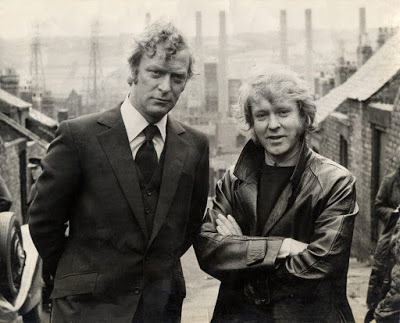
One event of this year which I have been anticipating more than many others is now almost upon us.
It is HULL NOIR, a celebration of northern crime writing, which I’m delighted and flattered to be participating in as chair of one of the panels. There have been Hull Noir events throughout this month, but it really gets going on the weekend of November 17-19. More about that in a few paragraphs, though it sets the tone for this week’s post overall, because today I am going to be discussing crime fiction that is both written and set right here in what used to be considered the Dark Half of England ... for which reason I probably couldn’t pick a better novel to review and discuss this week (in my usual forensic detail, I think you’ll find) than one of the original slices of urban Brit grit, Ted Lewis’s seminal JACK’S RETURN HOME, aka GET CARTER.
Again, more about that shortly – as always, you’ll find that review at the lower end of today’s post.
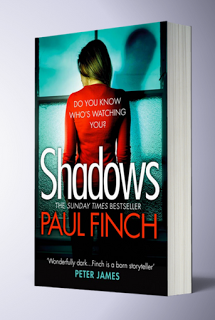 Before we get to any of that, but still on the subject of northern crime, I’m very happy to reveal that
SHADOWS
, the second installment in my series of Lucy Clayburn novels, will only be 99p in ebook form from now until the end of this month.
Before we get to any of that, but still on the subject of northern crime, I’m very happy to reveal that
SHADOWS
, the second installment in my series of Lucy Clayburn novels, will only be 99p in ebook form from now until the end of this month.SHADOWS is every inch a northern crime novel, because, whereas my other main crime-fighting character, Mark Heckenburg, though a northerner by origin (born in the fictional Lancashire town of Bradburn, 17 miles outside Manchester) has a remit as a homicide detective to travel the whole of England and Wales, Lucy Clayburn ( STRANGERS was her first outing) is an inner-Manchester girl, and her home borough and workplace (the again fictional Crowley) is located somewhere between Wigan, Bolton and Salford, which makes it the absolute epitome of the industrial Northwest.
In the last book, as a uniformed officer, Lucy went undercover as a prostitute to try and catch a female sex killer of men, and in this new one, as part of the elite Manchester Robbery Squad, she embarks on the pursuit of a band of gun-toting robbers, who aren’t just causing horror and fear because of their crazy cowboy antics – they will shoot anyone for the slightest reason – but who, as they are mainly targeting the underworld, look likely to cause a major gangland war.
So there we are, if you’ve got an e-reader, and you haven’t yet got on the Lucy Clayburn train, now is your chance … and for the bargain basement price of 99p.
I’ll say no more on that subject, because now onto HULL NOIR .
From Craphouse to Powerhouse
Associated with the Hull 2017 UK City of Culture event, HULL NOIR looks set to be one of the major crime literature festivals of this year, so it was a real honour to be asked to get involved. The stars of the show are undoubtedly Martina Cole, Mark Billingham and John Connolly – and they’ll all be playing significant roles. Martina will be celebrating the 25th anniversary of her first published novel, Dangerous Lady, in the company of top crime critic, author and aficianado, Barry Forshaw, while Mark and John will be contemplating the worst and best of their careers with Daily Telegraph crime critic, Jake Kerridge. But in addition, there some amazing panels lined up for next weekend.
Check these out, just as a sample (because there are many others too):
On Sleeping with the Fishes, Nick Quantrill, David Mark, Lilja Sigurdardottir and Quentin Bates will be discussing the style and influence of Hull and Iceland as locations and inspirations for crime writing.
On Getting Carter, Ted Lewis and the Hard Boiling of British Crime Fiction, Howard Linskey, Russel McLean, Sean O’Brien, Andrew Spicer and Nick Triplow will chat about the influence of American-style hardboiled crime writing on the British school.
In Brawlers & Bastards, Steph Broadribb, Craig Robertson, Mick Herron and Harry Brett will debate the genre’s hardmen, and look at how crime writers have made antiheroes from some of the most reprehensible characters.
But the panel I’m most looking forward (me being biased, this being my own), is From Craphouse to Powerhouse, on which I’ll be joined by northern crime luminaries, Liverpool’s Luca Veste, Newcastle’s Danielle Ramsayand Glasgow’s Jay Stringer, to kick around the subject of crime fiction along the M62, the noisy but straight-as-an-arrow motorway which, running as it does from Merseyside on the west coast, through Manchester, Lancashire, Yorkshire, and finally arriving in Humberside on the east coast, is often seen as drawing a straight line through the very heart of the old smoky, sooty north.
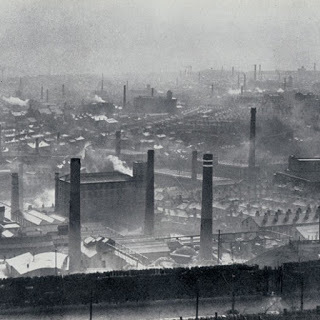 We’ll be talking about all kinds of crime-related northern stuff, I imagine, from industrial might to post-industrial decay, from the numerous terrible murder cases in this part of the world that might have influenced us, to the development of organised crime in our vast inner city areas now rendered dark and desperate by unemployment, and to the emergence from this chaos of hard-bitten northern heroes, like Veste’s Murphy and Rossi, like Ramsay’s Harri Jacobs, like Stringer’s Sam Ireland, and, if I say so myself, like my own Lucy Clayburn and Mark Heckenburg, all of whom, though they’re not gangsters per se, (Hell, some of them are actually cops!), whether intentionally on our part, or subliminally, have taken a leaf out of Jack Carter’s ‘Don’t Argue’ playbook.
We’ll be talking about all kinds of crime-related northern stuff, I imagine, from industrial might to post-industrial decay, from the numerous terrible murder cases in this part of the world that might have influenced us, to the development of organised crime in our vast inner city areas now rendered dark and desperate by unemployment, and to the emergence from this chaos of hard-bitten northern heroes, like Veste’s Murphy and Rossi, like Ramsay’s Harri Jacobs, like Stringer’s Sam Ireland, and, if I say so myself, like my own Lucy Clayburn and Mark Heckenburg, all of whom, though they’re not gangsters per se, (Hell, some of them are actually cops!), whether intentionally on our part, or subliminally, have taken a leaf out of Jack Carter’s ‘Don’t Argue’ playbook.As I say, HULL NOIR officially gets going this weekend, at the Britannia Royal Hotel, Hull. From Powerhouse to Craphouse starts at 11:30am on Saturday, November 18.
THRILLERS, CHILLERS, SHOCKERS AND KILLERS …
An ongoing series of reviews of dark fiction (crime, thriller and horror novels) – both old and new – that I have recently read and enjoyed. I’ll endeavour to keep the SPOILERS to a minimum; there will certainly be no given-away denouements or exposed twists-in-the-tail, but by the definition of the word ‘review’, I’m going to be talking about these books in more than just thumbnail detail, extolling the aspects that I particularly enjoyed … so I guess if you’d rather not know anything at all about these pieces of work in advance of reading them yourself, then these particular posts will not be your thing.
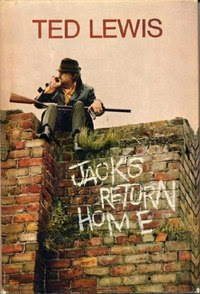 JACK’S RETURN HOME
JACK’S RETURN HOME by Ted Lewis (1970)
It’s the late 1960s in Scunthorpe, and Jack Carter is coming home.
Jack, born and raised in the northern steel town, left home quite some time ago to make his fortune in London, and, being a handy lad and inclined towards pitiless immorality, he eventually found his place as a mob enforcer. Since then, Jack has done all kinds of awful things at the behest of his employers, East End racketeers, Les and Gerald Fletcher, and in so doing, has earned himself a real reputation. Quite often, though, he lets his heart rule his head. For example, the clandestine affair he is conducting with Gerald’s wife, Audrey, is very ill-advised. But even more so is this return to Scunthorpe.
Long estranged from his family, Jack has only two close relatives remaining: his older brother, Frank, and Frank’s daughter, 15-year-old Doreen. But now Frank is dead, killed in an apparent drink-driving accident. The police, or ‘scuffers’, as they are known locally, see nothing suspicious in this. Frank was a barman, after all, and he worked in a particularly rough part of a particularly rough town. However, he was not known to be an unstable character, and in fact, compared to his brother, was a clean-living citizen – and this is the point where Jack becomes curious, refusing to believe that Frank would have climbed into his car having consumed an entire bottle of whiskey.
Though he came north ostensibly for his brother’s funeral, he now begins snooping around, asking questions, and it soon arouses the attention and eventually the ire of a number of local underworld figures.
Chief among these is Scunthorpe’s own godfather, Cyril Kinnear, but there are others who are no less dangerous in their own way: overly ambitious rival gang-boss, Cliff Brumby, for example; not-so-tough-but-well-connected loanshark, ‘Steelworks Thorpey’; ex-teddy boy and pool-room bully, Albert Swift, who became an underworld go’fer; and the ultra sinister Eric Paice, an old enemy of Jack’s, who, though he works superficially as a chauffeur, is mainly valuable to the mob for his ability to seduce and/or snatch young girls from lives of respectability for futures in pornography and prostitution – and Jack soon suspects that this latter is the key to the mystery.
It is only 1968, and blue movies are still taboo, but there is a voracious demand for them on the underground circuit, particularly among those interested in the sex adventures of very, very young females.
Increasingly firm attempts are made to dissuade Jack from continuing his investigation, gentle persuasion gradually giving way to violence, initially directed against those around him, such as Frank’s old mate and fellow barman, Keith Lacey, and Jack’s attractive if earthy landlady, Edna Garfoot, but finally against Jack himself – by which time it is verging on the lethal.
Jack continues to resist, even when he receives direct orders from Gerald and Les, as delivered by a pair of London hitmen, the brutal Con McCarty and camp-as-hell Peter the Dutchman ... and this latter makes him even more suspicious. How is his own firm involved in Frank’s death? And what role does Doreen play? – she may only be 15 and an orphan to boot, but her name crops up increasingly and in ever more lurid circumstances.
The more Jack evades attempts on his life, the more unedifying truths he uncovers, and the more personal this becomes. Soon, it is one man against the combined forces of both the London and the Scunthorpe syndicates, from which point there is no going back …
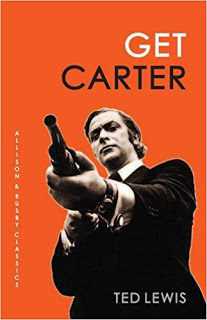 It’s very difficult to disassociate the novel,
Jack’s Return Home
, from the seminal Michael Caine and Mike Hodges movie adaptation of 1971,
Get Carter
. In fact, later editions of the novel were republished under that very title. In truth, there are a lot of similarities, even down to certain lines of dialogue, but there are some differences too.
It’s very difficult to disassociate the novel,
Jack’s Return Home
, from the seminal Michael Caine and Mike Hodges movie adaptation of 1971,
Get Carter
. In fact, later editions of the novel were republished under that very title. In truth, there are a lot of similarities, even down to certain lines of dialogue, but there are some differences too.To start with, Caine, though a mesmerising screen presence in his heyday, was ‘ethnically wrong’ to play Jack Carter, who in the book is a displaced northerner rather than a Cockney. In addition to that, perhaps the most famous liberty the movie took was in its transposition of the story from Scunthorpe to the even more grimily picturesque Newcastle. That said, none of these are really major issues. Where both the novel and the movie are united is in their warts-and-all portrayal of an unforgiving British gangland, setting their narratives against dingy working-class backdrops, and underscoring them with a level of sleaze that has shocking power even today.
In regard to all that, Jack’s Return Home is the original slice of Brit grit, the novel that opened the door to countless generations of Brit-Noir fiction to follow, while Get Carter , the movie, in taking the X certificate as far as it could go, presented us with a serious, grown-up thriller that would usher in a new age of UK-set hard-as-nails crime movies, much the way The French Connection did in the States (without Get Carter , it is doubtful we’d have had Villain , The Squeeze , Sitting Target , The Sweeney or The Long Good Friday ).
But back to the novel.
In terms of negatives (and there aren’t many of these), Jack’s Return Home may have lost a bit of its authority in the 21st century simply because time and society have moved on. It’s probably true to say that Ted Lewis was never a wizard with words. He could create atmosphere for sure, but he was no poet. Most of the impact his book originally made stemmed from it’s in-yer-face style. And even today, everything I’ve just said notwithstanding, it’s a bit of an eye-opener to see such a stark, matter-of-fact depiction of a rough, tough town, with its depressing rows of terraced houses, its fiery backcloth of factories and steel mills, its backstreet pubs full of drunks and strippers, and its smoke-filled billiards halls where a single wrong word can get you into serious trouble.
I can only imagine the strength of this narrative back in 1968.
That said, Ted Lewis wasn’t ploughing a completely lone furrow even then. Alan Sillitoe’s Saturday Night and Sunday Morning (1958) had already blazed a trail for blue-collar fiction, with its energised tale of a resentful tough-nut and the lives he either ruins or enriches (but mainly the former!) as he crashes selfishly through post-war Nottingham, while Barry Hines’s wonderful A Kestrel for a Knave (1968) focusses on an unwanted boy from a Barnsley council estate, and his doomed friendship with a hunting bird he rescued as an orphanned chick. In this regard, Ted Lewis’s great innovation was to take the ‘kitchen sink’ template, and pile on the villainy, creating a very difficult reality where near enough everyone is corrupt, including the police and local dignitaries, where eff-words are the norm, where heavy drinking and the use of casual violence are the mark of manliness, and women in particular are treated like dirt.
This latter is perhaps the part where Jack’s Return Home is really at odds with modern thinking. Because at the heart of this tale lies the underworld’s all new money-spinner: hardcore porn. And it’s porn of the sordid, seedy, homegrown variety, in which desperate, cash-strapped actors participate for peanuts, especially the women, and in which almost no age restriction is put on them – in fact, the younger the better.
An accurate depiction of a squalid world, perhaps, but the novel has dated generally in the context of its female cast, almost all of whom are tarts of a sort: Frank’s ex-wife, Murial (who had sex with Jack after getting drunk); Frank’s former girlfriend, Margaret; good-time girl, Glenda; and even middle-aged landlady, Edna, who happily sits across the room from her lodger, with legs apart so that he can see her stocking-tops (and later on gets brutally beaten, to which Jack is stingingly unsympathetic).
It’s no surprise that not everyone these days sings the novel’s praises.
Jack Carter’s character is itself ambiguous. Caine’s appearance in the movie caused a stir at the time, everyone’s favourite cheeky chappie turning hard and vicious in his quest for revenge, but in the novel there is barely a hint of a pleasant side to his personality. On occasion, he reminisces about his early youth – the last happy time he knew, we suspect – when he and Frank got on their bikes and explored the woods and wastelands on the outskirts of town. These are moving sequences and poignant reminders that even monsters once were children. However, later on things changed for Jack, possibly in response to Frank’s gentler nature: Jack idolised his older brother, but as they grew older, Jack came to revile Frank’s habit of turning the other cheek, feeling increasingy betrayed by it. As such, for the bulk of this novel, Jack is a coldly merciless figure. He doesn’t go at it shouting and swearing, because he’s got nothing to prove – all the hoods in Scunthorpe know who he is, and most of them fear him. Even in casual conversation, you suspect it’s only the calm before the storm.
A staple of ‘tough guy’ fiction these days, I suppose Jack was one of the very first who you could say ‘didn’t start fights, but certainly finished them’.
So successful was Jack’s Return Home , that Ted Lewis wrote two additional Carter novels afterwards. But with his sad and premature death at the age of 42, the series ended there. Even so, he created an iconic character in the annals of British crime fiction, one who’s been copied many times since but has rarely been equalled, and set him in a world long lost but utterly unforgettable (even if mostly for the wrong reasons).
I’m in the habit of ending these book reviews with some fantasy casting, putting forward a ensemble of actors who I feel would be perfect in the roles. But given the two major movie adaptations that Jack’s Return Home already has in the bank – the totally awesome Get Carter (1971), and the significantly less awesome, Vegas-set Sly Stallone vehicle, Get Carter(2000), I don’t think there’s much point.
The cracking image topping today ’ s blog was taken in Newcastle during the filming of Get Carter (1971), and depicts Michael Caine and Ted Lewis. It currently graces the cover of GETTING CARTER, Nick Triplow’s new and amazing account of Lewis’s short-lived career. If anyone knows the name of the photographer, please tell me and I ’ ll be delighted to credit him.
The image at the top of today ’ s book review is the original cover art, as used by Michael Joseph on the first edition of the novel.
Published on November 12, 2017 13:22
October 22, 2017
It's here again: darkness, devilry and dread
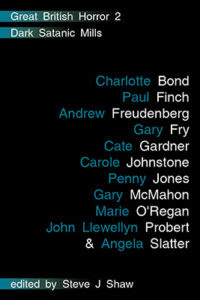 The horror … the horror …
The horror … the horror …
Yes, we’re in the final run-up to Halloween, and so this week I’m going to take a brief break from talking about my new crime novel, SHADOWS, in order to celebrate the season of ultimate darkness.
I’m going to do this on three fronts: firstly, as a horror story writer myself (in my spare time, these days), by focussing on several scary story collections and anthologies which you need to be getting your teeth into at this time of year; secondly, by presenting a gallery of what I consider to be the 25 BEST HORROR NOVEL COVERS EVER; and thirdly, by reviewing and discussing in my usual forensic detail S.L.Grey’s spine-chilling THE APARTMENT – as always, you’ll find that review at the lower end of today’s post.
Books to read
One thing I always love about the waning of the year is the inevitable association it brings with eerie stories. I’m not going to prattle too much about how the oncoming cold and darkness and the dying of the land each autumn brought fear and concern to our ancient ancestors, who imagined that this was due to the presence of witches, goblins and other evil entities, and so in turn sought to commune with their own spirits to guarantee the timely return of the sun – but it’s a common belief among anthropologists that we still live with at least one result of this today: an increased awareness of and interest in spooky stories in the period between (and including) Halloween and Christmas.
Anyway, without more ado, if you share that interest and awareness, and you’re so inclined, why not check out some of these books?
Initially, I’m going to do a bit of self-pimpery. As I said, I’m no stranger to writing horror stories, myself. There isn’t enough space here to go back through my entire short story bibliography (and I doubt anyone reading this would have the patience for that anyway, and rightly so), but here are a couple of titles that might be of interest.
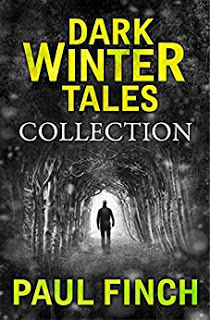 DON'T READ ALONE
was published in 2013, and features, among other things, an embittered writer who accidentally invokes the spirit of the Green Man, a cop whose determination to locate a missing child takes him into a nightmarish underground complex, and a bunch of marooned holiday-makers who are menaced by an ancient, oceanic beast ...
DON'T READ ALONE
was published in 2013, and features, among other things, an embittered writer who accidentally invokes the spirit of the Green Man, a cop whose determination to locate a missing child takes him into a nightmarish underground complex, and a bunch of marooned holiday-makers who are menaced by an ancient, oceanic beast ...DARK WINTER TALES is a more recent title, dating to 2016. In this one, again among other stuff, a housing estate is terrorised by a strangler with seeming inhuman powers, students visit a haunted house where, whatever happens, you are never supposed to look behind you, and the mother of the last man hanged in England becomes obsessed with an executioner’s dummy.
I also have a personal interest in GREAT BRITISH HORROR 2: DARK SATANIC MILLS, featured at the top of this column, which is a relatively recent title – September, 2017 – published by the excellent Black Shuck Books and edited by the indefatigable Steve Shaw. You don’t need to look too far beyond the list of contributors on the cover (again, check the top of this blogpost) to know you’ll be getting quality, but with authors like Carole Johnstone, Gary McMahon, John Llewellyn Probert and Angela Slatter, can you really afford to miss it?
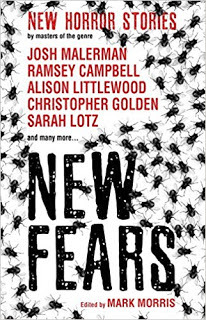 On the subject of anthologies, I also want to mention
NEW FEARS
, also a recent publication, as edited by a good friend of mine and a top writer in his own right, the legendary Mark Morris. This title is a particularly important publication for horror fans, as it could well mark the commencement of a new, annual, high quality horror antho series, something we’ve been sorely lacking in recent years. Again, check out some of the stars on the contents list, and just listen to the titles of the stories they’ve written: The Boggle Hole by Alison Littlewood … The Embarrassment of Dead Grandmothers by Sarah Lotz … The House of the Head by Josh Malerman ...
On the subject of anthologies, I also want to mention
NEW FEARS
, also a recent publication, as edited by a good friend of mine and a top writer in his own right, the legendary Mark Morris. This title is a particularly important publication for horror fans, as it could well mark the commencement of a new, annual, high quality horror antho series, something we’ve been sorely lacking in recent years. Again, check out some of the stars on the contents list, and just listen to the titles of the stories they’ve written: The Boggle Hole by Alison Littlewood … The Embarrassment of Dead Grandmothers by Sarah Lotz … The House of the Head by Josh Malerman ...Lastly, here’s a particularly relevant title. Adam Nevill is a another close friend of mine, and another incredible writer – yes, I’m in real name-dropping mode today! – but he’s probably best known at this moment for the current cinema adaptation of his bone-numbing novel, THE RITUAL .
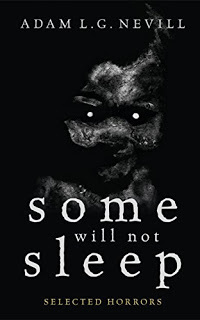 However, of equal interest to dark fiction fans should be his first collection of short stories,
SOME WILL NOT SLEEP
, which, trust me, contains some true fictional nightmares. I defy anyone to read stories like Where Angels Come In, The Original Occupant, Yellow Teeth and Pig Thing, and to sleep easily for the next few nights.
However, of equal interest to dark fiction fans should be his first collection of short stories,
SOME WILL NOT SLEEP
, which, trust me, contains some true fictional nightmares. I defy anyone to read stories like Where Angels Come In, The Original Occupant, Yellow Teeth and Pig Thing, and to sleep easily for the next few nights.But don’t take my word for it … investigate these titles out for yourself.
*
One of the joys (or agonies) of being an author is that first moment when you get to see the cover allocated to your latest book. You don’t always like them; appreciation of art is a subjective thing, of course. But just because you don’t like your latest jacket, that doesn’t mean others won’t, or that it isn’t actually fantastic. However, throughout the history of published fiction there have occasionally been book-covers so jaw-dropping that no serious person could ever do anything other than take a big, awe-stricken step backwards on first seeing them.
And the horror genre is no exception.
So here, in no particular order, are THE BEST 25 HORROR NOVEL COVERS EVER (including one or two short story collections, because this is horror, and in horror, the short form really counts):
1. THE LURKER AT THE THRESHOLDH.P. Lovecraft and August Derleth (Panther, 1970)
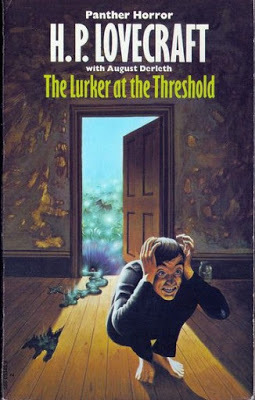
Familiar Lovecraft territory from the start as Ambrose Dewart returns to his ancient ancestral pile in the heart of rural Massachusetts, only to uncover horrific revelations about his family’s past and their connections to ancient evil. Mostly written by August Derleth from scraps of original HP text (first published in 1945), this reprint cover still conveys the intense cosmic horror better than all others ...
2. KRONOS Jeremy Robinson (Variance, 2009)
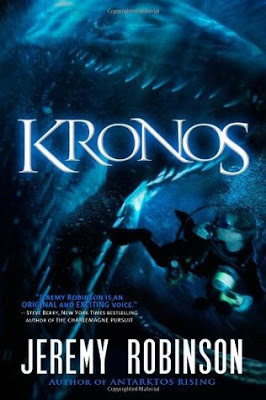
Can’t really comment on the book as I haven’t read it yet, but anyone who’s even vaguely uncomfortable swimming with deep water beneath them, or who gets nervy thinking about the ocean abyss, how does this one look to you? It concerns a former Navy Seal who is determined to avenge the loss of his daughter by destroying a mysterious, colossal sea-creature ...
3. THE RITUALAdam Nevill (Pan, 2012)
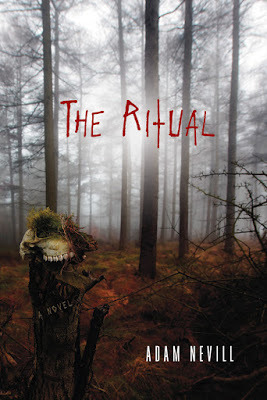
Originally published in 2011, the reprint cover of this modern folk-horror classic still captures the atmosphere of the book better than any other. When four middle-aged English guys hit the wild backwoods of northern Sweden, they find themselves lost in a depthless primeval forest, filled with ancient mysteries and hideous relics, and with something ghastly in pursuit. Totally terrifying ...
4. THE OCTOBER COUNTRYRay Bradbury (Ballantine, 1955)
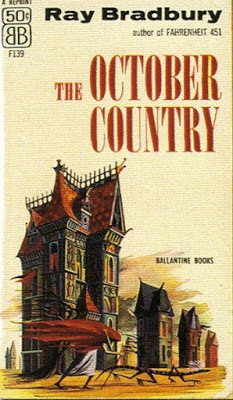
A superb jacket to one of the ultimate horror collections, its otherworldly elements perfectly complementing the 1950s Avant-garde style to indicate that what you’re going to get here won’t just consist of the chilling and macabre, but will be liberally laced with weirdness and typical Ray Bradbury fantastica ...
5. MR. HANDS Gary A. Braunbeck (Leisure, 2007)
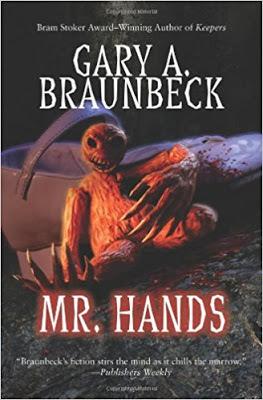
This paperback edition put an unforgettable but very to-the-point cover on Gary Braunbeck’s third novel in the Cedar Hill series. For the uninitiated, Cedar Hill is a fictional blue-collar town in Ohio, where mysterious secrets are kept and unexplained forces wreak havoc. In this installment, Braunbeck gives his own unique take on the legend of the golem, as the jacket clearly shows ...
6. JAWSPeter Benchley (Doubleday, 1974)
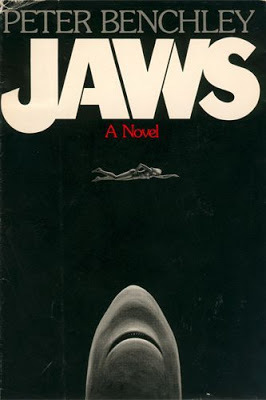
The original simple-and-yet-so-effective Doubleday cover to the book that emptied seaside bathing areas across the Northern Hemisphere during one of the hottest summers on record. There’s not much more you can say, except that this perfectly judged image - along with all those others derived from it - has become one of the most distinctive and iconic in horror novel history ...
7. DRACULABram Stoker (Penguin Classics, 2004)
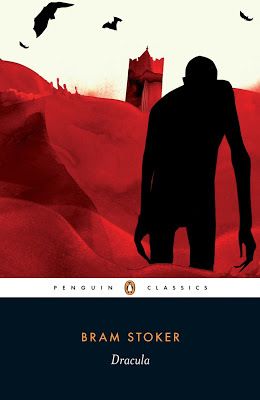
Since its first publication by Archibald Constable in 1897, Dracula has had every kind of cover conceivable, from the garish to the subtle, from the saucy to the romantic. For me, this is the best of them all, because it perfectly addresses the problem of how to re-jacket a story that so many artists have already tackled in so many different styles, and pulls it off with modernist aplomb ...
8. KINKealn Patrick Burke (Cemetery Dance, 2011)
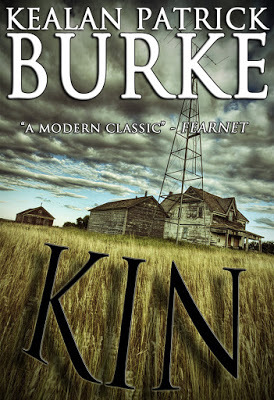
A deceptively simple and seemingly non-horrific cover, and yet when it’s combined with the strangely menacing title, you won’t need anyone to tell you that here is a tale of rural cannibalism and depravity, which draws heavily on the backwoods mythology that fuelled such onscreen horrors as The Texas Chainsaw Massacre and The Hills Have Eyes. Strong stomachs required ...
9. THE HOUSE ON THE BORDERLANDWilliam Hope Hodsgon (Sphere, 1980)
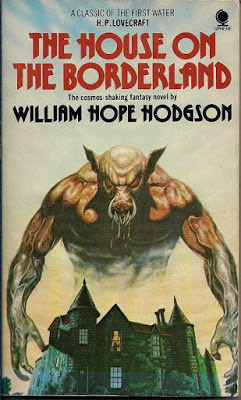
First published in 1908, this superior supernatural chiller went on to influence such later luminaries of the horror and fantasy genres as H.P. Lovecraft and Terry Pratchett. It tells the tale of a distressed recluse who seeks refuge in an isolated house in the Irish hinterland, only to find that he has attracted the attention of an evil subterranean race; like this incredible jacket doesn’'t tell you that already ...
10. I AM LEGENDRichard Matheson (Orb, 1997)

First published in 1954, what initially seemed like a pulp horror dime-novel soon emerged as one of the seminal horror stories of all time in that it kick-started the zombie-plague genre and was one of the first to moot the possibility of a worldwide Apocalypse caused by germ warfare. The Orb cover completely embodies the nightmare scenario of mankind reduced to living-dead monsterdom ...
11. ITStephen King (New English Library, 1987)
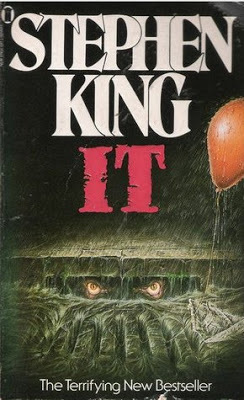
How do you illustrate a horror novel in which the main monster presents different terrifying facets of itself to different characters? This original classic does the job perfectly, because though the balloon is there and even though we know it was the clown lurking in the sewer on the day young Georgie died, it wasn’t one of these new-fangled killer clowns. It was something much, much worse ...
12. SECRET OF VENTRILOQUISMJon Padgett (Dunhams Manor, 2016)
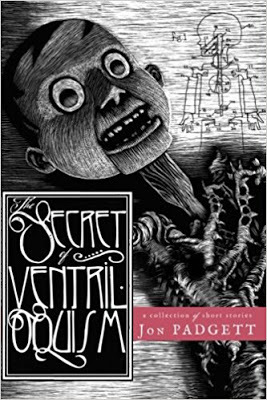
Another book on this list which I haven’t yet finished, but which simply screams to be read thanks to its unique and unsettling cover. Jon Padgett’s much-lauded debut collection presents us with a series of interlinked stories which most reviewers have praised for invoking fear through a consistent atmosphere of the weird and uncanny rather than gross-out horror. The cover strongly hints at this ...
13. DARK HARVESTNorman Partridge (Tor, 2006)
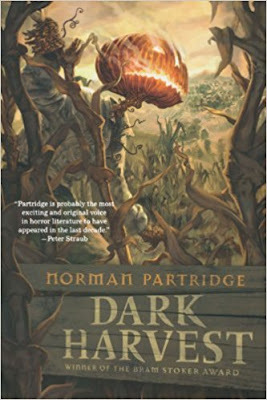
American authors, as a whole, tend to utilise Halloween in their writing more than their British counterparts, and this has led to some startlingly atmospheric, autumnal US covers over the years, but this one, and this book, encapsulate the aura more than most. Master of the folklore chiller, Norman Partridge hits us hard with his tale of an isolated country town and its annual Halloween nightmare ...
14. THE PILO FAMILY CIRCUS Will Elliott (Underland, 2009)
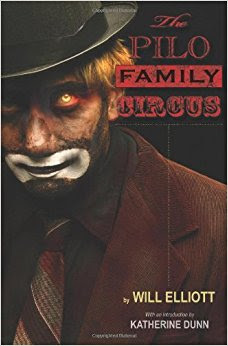
You won’t need a fear of clowns to be disturbed by this one, but that generations-old phobia is clearly plucked at by this excellent cover. Wildly funny and darkly macabre, it tells of a guy who is recruited to join the circus by a trio of psychopathic clowns, and finds himself in an hellish netherworld of weird fortune-tellers, maniac freaks, crazy dwarfs, and of course clowns, lots of mad, bad clowns ...
15. SEEDAnia Ahlborn (47North, 2012)
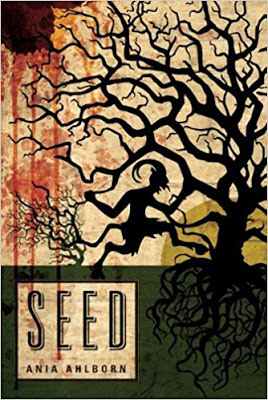
The Southern Gothic genre goes full-on mythic horror in this pacy tale of a country boy on the run from his own personal demon. The scary cartoon-style cover only gives you one part of the story but it’s more than enough for me. You’ve got the rural folklore element, the demonic element, you’ve got the idea that this is one pursuit that isn’t going to end easily. A hell-ride of a horror novel ...
16. AMERICAN PSYCHOBret Easton Ellis (Picador, 1991)
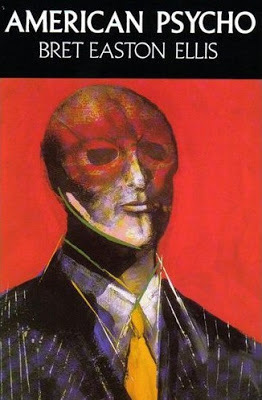
This seminal indictment of yuppie culture and high-end capitalism as seen through the prism of a Wall Street madman so obsessed with superficial gain that he views people as mere commodities which he can brutalise for fun, has divided opinions all its life. Amazingly perceptive, but sexually ultra-violent, it could only ever see the light of day in a cool, ambiguous jacket like this ...
17. BRITISH INVASIONChris Golden, Tim Lebbon, James A Moore (Cemetery Dance, 2008)
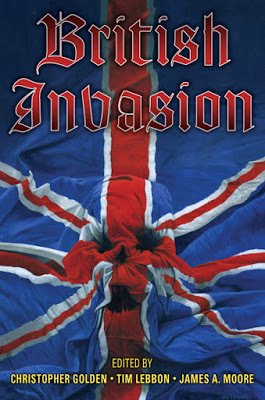
A cover that completely speaks for itself. Cemetery Dance are a specialist and powerhouse publisher of horror novels, collections, anthologies (and, of course, a very successful monthly magazine of the same name) based in the US, and understandably focussing for the most part on American talent. That isn’t a house rule, however, and this specially commissioned antho took CD to the UK ...
18. HEXThomas Olde Heuvelt (Hodder, 2016)
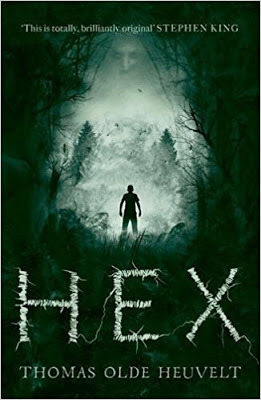
The rather marvellous, movie-style jacket to Dutch author Thomas Olde Heuvelt’s first English-language novel, which nicely underscores the notion of a rural town entrapped by a 17th century curse. Of course, it’s not so simple. Much of the tension stems from the hi-tech app the townsfolk use to track their nemesis, the hideous Black Rock Witch, though this soon brings its own horrors ...
19. FRANKENSTEINMary Shelley (Lackington, Hughes, Harding, Mavor & Jones, 1818)
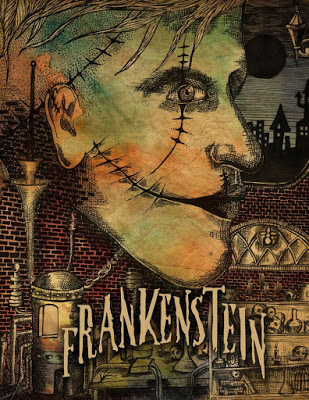
If anyone knows who is responsible for this fascinating cover to the age-old horror classic, and/or when it was put it out, I’d be interested to know. I found it floating around online with no notice of provenance attached. If it isn’t actually the cover to an edition of Mary Shelley’s seminal monster saga of 1818 (which had no illustration on its very first cover), then it really should be ...
20. SHUTTERCourtney Alameda (Square Fish, 2016)
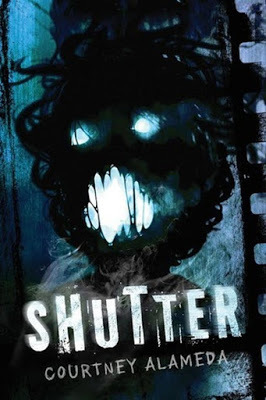
Another book on the list which I haven’t read, but which strongly begs you to take it down from the bookshop shelf. It’s a YA work, so it may not be to every horror reader’s taste, but this is one hell of a great jacket, which more than sells the story inside. In a nutshell, a trainee monster-hunter identifies her potential targets by tracking the auras of the undead through the prismatic spectrum ...
21. THE EXORCISTWilliam Peter Blatty (Harper & Row, 1971)
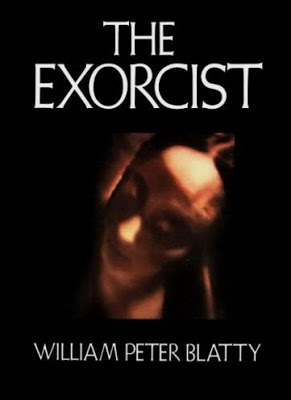
The book cover that struck terror into the world in the early 1970s, and certainly one that you had to ensure your parents or teachers never caught you with if you were a kid (like me). Everyone knows the story thanks to the movie version, which was very faithful to the novel. Suggestive of evil for sure, but mainly powerful because of the novel’s fearsome reputation, a spell that hasn’t yet broken ...
22. HARVEST HOMEThomas Tryon (Alfred A. Knopf, 1973)
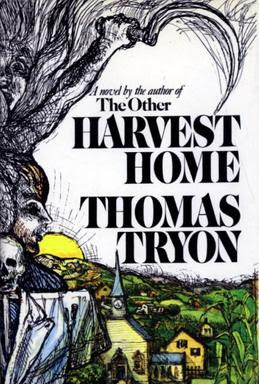
Published in the early days of the small town/village horror cycle that would become so popular, this harrowing tale of a urban couple’s relocation to a seemingly idyllic world of country life and time-honoured tradition will seem very familiar now, though it’s still one of the best of its kind. The simple yet clearly explicit illustration on this, its original cover, tells us exactly what to expect ...
23. TOYBOXAl Sarrantonio (Leisure, 2003)
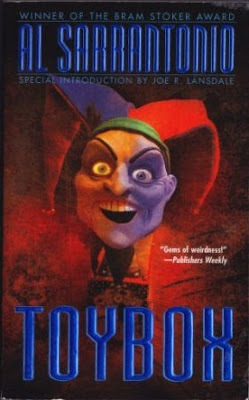
An absolutely perfect cover for the US horror master’s first collection of short stories, because childhood toys and childhood fears are a subtle but ongoing theme here, though the tales themselves, even if linked by a central framing device, are all stand-alones. If you haven’t encountered Al previously, you’re in for a treat. Contains 18 short but beautifully-written chillers ...
24. THE HOUSE OF DEAD MAIDSClare B. Dunkle (Square Fish, 2011)
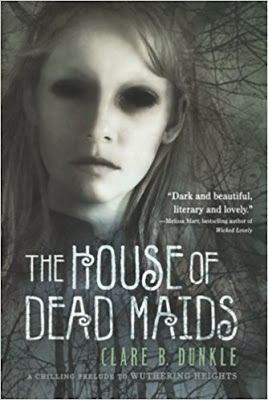
Another YA inclusion in the list, but another novel excellently illustrated by its jacket, because in this case, supernatural creepiness is to the fore rather than extreme horror or grue. It tells the tale of a young woman who takes a job in a dismal mansion, only to find that most of the time she’s expected to entertain a vicious, sociopathic child. And that isn’t even close to being the worst of it ...
25. WE HAVE ALWAYS LIVED IN THE CASTLEShirley Jackson (Penguin, 2006)
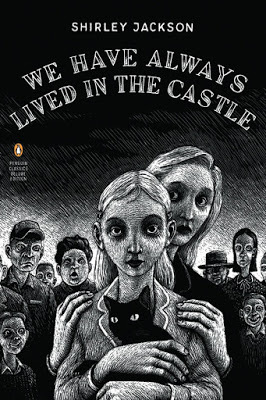
Saving one of the most literary entries for last, we have Shirley Jackson’s last novel (first pub in 1962), which is more a Gothic mystery than a full-on horror tale, but which nevertheless evokes deep psychological fear as it focusses on a wealthy but oddball family whose presence in a traditionalist small town invites hostility, jealousy and greed, as this wonderful reprint cover amply indicates ...
THRILLERS, CHILLERS, SHOCKERS AND KILLERS …
An ongoing series of reviews of dark fiction (crime, thriller and horror novels) – both old and new – that I have recently read and enjoyed. I’ll endeavour to keep the SPOILERS to a minimum; there will certainly be no given-away denouements or exposed twists-in-the-tail, but by the definition of the word ‘review’, I’m going to be talking about these books in more than just thumbnail detail, extolling the aspects that I particularly enjoyed … so I guess if you’d rather not know anything at all about these pieces of work in advance of reading them yourself, then these particular posts will not be your thing.
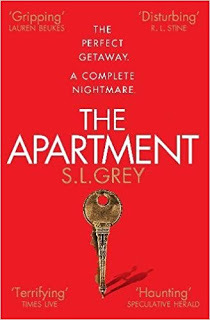 THE APARTMENT
by S.L. Grey (2017)
THE APARTMENT
by S.L. Grey (2017)
Cape Town residents, Mark and Steph Sebastian, are not the most happily married couple.
To start with, there is an age gap between them, Mark considerably older than his pretty young wife, and though this doesn’t trouble them superficially, deep down we suspect it’s been an issue of sorts from early in their relationship. Add to that the trauma Mark suffered in a previous marriage when his first daughter, Zoe, died a terrible death, and the poor wage he earns as an uninspiring lecturer in one of South Africa’s lesser universities, and you can understand why he is so troubled.
Steph is not the perfect spouse, either. A stay-at-home mum with their new baby-daughter, Hayden (when the family so clearly needs a second wage), and attractive enough to catch the eye of, and even flirt with hunky young guys in the neighbourhood, she inevitably wonders if she chose the wrong man to spend the rest of her life with – her parents certainly think she did! – and yet she remains pathologically suspicious of Carla, a sophisticated woman from Mark’s past, whom he never took to bed but is still friendly with.
If all this isn’t bad enough, the couple’s suburban home is then violently burgled while they are present, the trio tied up and terrorised by a gang of knife-wielding bandits. They are not physically injured, but Mark feels unmanned by the incident because he did nothing to defend his wife and child (even though there was patently nothing he could do), while, Steph, we suspect, though she won’t say it in as many words, now thinks even less of him than she did before.
The visceral horror of the episode lingers long afterwards, the couple no longer feeling safe in their home and spending what little cash they have on an updated security system.
When the suggestion is made that they need a holiday to try and rediscover the affection they once held for each other, the Sebastians dismiss it as unaffordable nonsense. But then, a house-swap website is drawn to their attention, and they learn about a French couple, the Petits, who are looking for a place in Cape Town, for which they will temporarily exchange their own luxury apartment in Paris.
It all looks fantastic online, and of course Mark and Steph have always wanted to visit the City of Light. The deal is signed, and things finally seem to be looking up. With Hayden left in the capable hands of Steph’s parents, the duo fly to Europe, eagerly anticipating a much-needed vacation in the cradle of culture and romance.
What they actually find, however, is the exact opposite.
The apartment, when they manage to locate it in the backstreets of the Pigalle, is a seedy dump in what feels like a semi-derelict building. It is gloomy, damp and filled with all kinds of unsavoury mementoes, including items which seem to have relevance to Mark’s own unhappy past (though he won’t admit this to Steph), and there is only one other resident, an eccentric artist called Mireille, who lives in a garret on the top floor. This might at least hint at the old Bohemian Paris we all know and love, except that Mireille appears to be deranged, and lives in such squalor that they soon come to suspect she’s squatting in the building rather than paying rent.
Add to this the terrible weather – it’s a bitterly cold February – the Sebastians being financially unequipped for a holiday in France, and an increasing mystery about the Petits themselves, who never showed up to claim the house in Cape Town and now appear to be out of contact, and we have a rapidly unfolding nightmare.
But this is only the start of it.
Weird and unexplained incidents in the apartment hint at a supernatural, even malevolent presence, and when Mark finds himself grappling with some ghastly hallucinations, at times losing track of where he is and what he’s doing here, they decide it’s time to head home. But leaving this apartment is not as easy as it sounds, and even if the Sebastians manage it, Steph, for one, fears that they haven’t seen the last of the subliminal evil they’ve encountered here …
The first thing to say is that I’m a bit staggered by the number of negative reviews that this book has received online. Some readers appear to have come at it expecting full-blown horror, as in demons and gore on every page, while others sound resentful that the publicity material accompanying its release – describing it as “a terrifying tour de force,” for example – has misrepresented a book that they clearly expected to leave them quaking under the bedclothes.
Well, the advice I would give to these folks comes in two parts.
1) Never read too much into publicity material – its job is to entice you, not inform you.
2) Instead, read what it says on the tin – that’s a more tested method for finding out what’s inside.
If you did the latter, you’d have no problem at all with The Apartment , because, as it says in the blurb, this is a disturbing little psychological thriller, which, no, may not have you screaming in fear by bombarding you with ghost-train effects, but yes, will unsettle you no end by immersing you in an intensely creepy predicament, which gets steadily worse for the main protagonists the deeper into the novel you penetrate.
I safely predict that any readers who are even vaguely sensitive to unpleasant situations will be bemused and unnerved in equal measure, as lead-characters, Mark and Steph Sebastian, first try to fathom out how it is they come to be stuck in this awful place, and then try to establish an escape route, both of which missions are fraught with difficulty.
There are some odious elements in the book too; some real hair-curlers, in fact.
The seaminess of the just-about habitable apartment is wonderfully evoked by joint-authors Sarah Lotz and Louis Greenberg (who share the pseudonym, SL Grey), even if it remains largely intangible, deriving mostly from its air of inexplicable abandonment, from its unspoken aura of dread, from the decayed left-overs of nameless former occupants still to be found there even years later. All of this is so well realised by the authors, who at no stage hit you in the face with it, that you couldn’t imagine wanting to spend even a single day and night there, let alone a week-long vacation. The term ‘shudder-inducing’ is often over-used, but it would be perfectly fitting in this circumstance.
In this regard, any resemblance to Roman Polanski’s Parisian-set horror flick of 1976, The Tenant , (itself an adaptation of Roland Topor’s psychological chiller of 1964, Le Locataire Chimérique ), owes mainly to the Grand Guignol setting, but The Apartment shares a similarly haunting and claustrophobic atmosphere, and that is no bad thing.
The city itself is used to great effect. Lotz and Greenberg take us all over the place, showing us the sights and immersing us in the magic of this great European capital, and yet it’s a two-edged sword, Mark and Steph remaining distanced from it all because they are so short of money, looking at the glitz through panes of rain-streaked glass, shivering in a wintry wind from which they can’t find shelter.
The impoverishment of the two heroes has drawn criticism from certain reviewers, who’ve expressed annoyance with the Sebastians and have doubted that this could happen, pointing out that they’re an educated couple, who surely have sufficient experience between them to avoid being marooned in a foreign city so short of cash that they can barely sustain themselves let alone buy a ticket home. But I’d argue that they are damaged goods, neither Mark nor Steph functioning at a full-on adult level.
This is given full effect by a clever device wherein the narrative is relayed to us in alternate chapters, one from Mark’s perspective, the next from Steph’s, the next from Mark’s, and so on. Not only does it ram home the message that these guys may be married but are certainly not allies, it also illustrates how unreliable they both are as narrators. Mark is still traumatised by terrible events in his early life; they occupy much of his day-to-day thinking, allowing him no enthusiasm for his job and only a little bit for his new wife and child. Little wonder, the apartment comes to embody all this, leaving him to suspect (or should that be ‘imagine’?) that there’s a malign presence in the desolate building. At the same time, Steph simply thinks the place is horrible and unsafe, for which she mainly blames Mark – somewhat unfairly, I feel, because it ought to be plain to a perceptive wife that her husband is struggling with his mental health – and obsesses constantly about her child, who she didn’t want to leave at home.
On top of that, they are both tortured by memories of the burglary, Mark riddled with regret that he didn’t do more to defend his family (as if that would have been remotely possible for a middle-aged man, though that, of course, exacerbates the main bone of contention between the couple), while Steph, feeling that she came very close to being raped and murdered, now finds the night-time an ordeal, feeling safe nowhere and seeing no protection in her husband.
In fact, so much of the narrative occurs inside the characters’ heads that this is definitely NOT your run-of-the-mill horror story. The gainsayers have got that much right, but I still found it hugely effective. It’s also been written in a readable, paired-down style – never fear, it’s still wonderfully descriptive and richly flavoursome of Paris ‘behind the scenes’ – but it rattles along at pace to an especially chilling climax (which, contrary to some of the more nonsensical reviews I’ve read, wraps the whole thing up both coherently and satisfyingly).
It can’t say that I had nightmares after reading The Apartment , but my skin crept, and I brooded on it long after I’d finished, which has got to be proof of a very worthwhile horror story.
I’ve no clue whether or not The Apartment is destined for any kind of film or TV development, but if not, it ought to be. As such, I’m going to display my usual conceit and nominate the cast I personally would opt for were it ever to get the adaptation treatment. Just for laughs of course – no-one would listen to me anyway – but here we go:
Steph – Tanya van GraanMark – Sharlto CopleyCarla – Antoinette LouwMireille – Nathalie Baye
Published on October 22, 2017 12:53
October 18, 2017
'Tough guy' girls - who are our favourites?

I’m going to be talking about heroines in thrillers this week, particularly the hotshot types, those who are young enough, tough enough and crazy enough to embrace the action full-on.
This is partly because tomorrow - after a month-long countdown during which I’ve been putting out various whistle-wetters on social media (as you can see a few paras down), the second novel in my Lucy Clayburn series, SHADOWS, will be published … Lucy being an action girl in every sense of the word.
But it’s also because I thought it would be a fun thing to lay out some thoughts regarding MY 10 FAVOURITE FICTIONAL ‘TOUGH GUY’ GIRLS, and also, even though it is something of a divergence from the main theme, because I’ll be reviewing number three in Phil Rickman’s excellent Merrily Watkins series, A CROWN OF LIGHTS. Merrily is no action hero in the traditional sense, but there’s no question that her criminal investigations are among the most intense and frightening ever put on paper (she also works well for me this month, because the small supernatural element prepares the ground nicely for a more ghostly blog around Halloween).
Anyway, as usual, that review and discussion can be found towards the lower end of today’s post. First, a couple of words about SHADOWS .
Lucy
When Lucy Clayburn first hit the bookshelves in 2016, in the novel, STRANGERS , it was quite a change of pace for me. I’d been writing the Heck series up until then, in which there was plenty of unadulterated action. When I was asked by my publishers, Avon Books at HarperCollins, to consider a parallel series involving a policewoman, I thought it was an opportunity to come back down to Earth a little, and to give my readers a more procedural-style atmosphere and a lead character, who, while tough as nails – because she’s a blue-collar Manchester lass through and through, and in her spare time wears leathers and rides a Ducati motorbike – deals with day-to-day street crime as a divisional police detective, rather than confronting megalomaniac villains whose evil schemes are mind-boggling in their insanity.
Of course, Lucy quite often gets drawn into much more serious cases, so no one needs to think that we’re content to merely do the mundane in the Clayburn books. For example, in STRANGERS , a good pinch following a random attack on a young woman late at night sees Lucy recruited to work plain clothes in the hunt for a serial killer known as Jill the Ripper (a deranged prostitute, who slices and dices her male clients rather than giving them pleasure). Likewise, in SHADOWS , more good work by Lucy, in this case her pursuit of a cash-machine bandit, sees her seconded to the Manchester Robbery Squad, an elite but rough-and-ready outfit who are hot on the heels of the ruthless Red Headed League.
And then there is the other factor, the thing I like to believe really makes Lucy Clayburn distinctive. The child of a single mum, she never knew her estranged father - until she was 30 years old and well into her police career. It was quite a shock, I guess, for her to learn that he is now a major player in the region’s overarching crime syndicate.
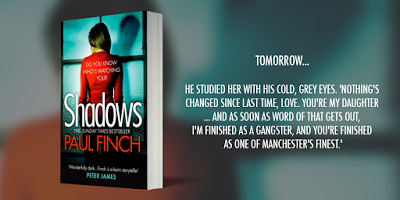
SHADOWS hits the shops on October 19.
Okay, and now onto our second business of the day: my love for action girls extended into a gallery of names and faces hailing from all across the fictional world. Here, in no particular order, are my thoughts and fancies on …
THE TEN BEST ‘TOUGH GUY’ GIRLS IN THRILLER FICTION
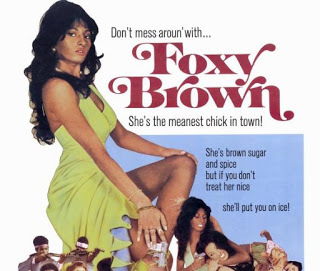 Foxy Brown
Foxy BrownPossibly not the way female heroes would prefer to be depicted today, Foxy Brown, as played by the ultra-sexy Pam Grier in the 1974 movie of the same name, nevertheless presented the world with a central female character who didn’t just trade on her looks, but was tough, brave, and had no hesitation in standing up to male violence. The vengeful girlfriend of a murdered government agent, she literally went to war with a major crime syndicate, in the process destroying the heroin scourge that had been devastating her city.
Blaxploitation cinema was always controversial – but with Foxy Brown, it wasn’t just the race question, it was the gender question too. Critics at the time panned it for mistaking extreme violence, nudity and brash sexuality for some kind of feminist message, but it was still massively popular at the box office. On a personal note, I’ve never found Pam Grier anything less than totally watchable – and Foxy Brown is her raunchiest but toughest ever role.
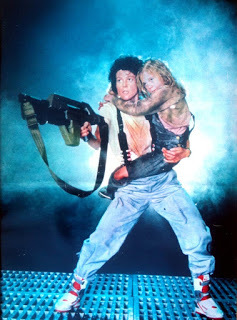 Ellen Ripley
Ellen RipleyOne of only two sci-fi characters to make my final list, Ellen Ripley – as immortalised by Sigourney Weaver – is probably the most immediately recognisable action heroine of all time.
The main protagonist in the first four movies of the Alien franchise (though I personally prefer the first two, as the rest were derivative and repetitive), Ripley first comes to our attention as a flight-officer working deep space cargo missions, which requires her to be a hardass every inch of the way, putting in long hours, subjecting herself to constant discomfort and dealing day-to-day with roughneck crewmen. We also learn that she’s a single mother, who endures all this to provide for her daughter. On top of that, she must battle the horrifying Xenomorph, mostly alone, and yet, often by using brain over brawn, tending to come out on top. A tired but fearless and endlessly resourceful figure, Ripley probably did more than anyone to revolutionise the way women were portrayed in hardcore science fiction.
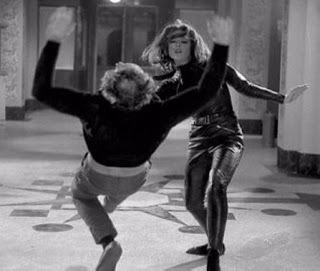 Emma Peel
Emma PeelFew female action heroes can seriously have provided hot male fantasy figures on one hand, and on the other won universal applause from women’s groups. But Emma Peel, star of the popular spy series, The Avengers, did just that.
Perhaps superficially, her character didn’t promise much. Named Emma Peel because the show was looking for ‘Man Appeal’, she initially appeared as the kittenish daughter of a prominent industrialist, who spied for a hobby, wore a black catsuit, flirted provocatively with her male counterpart, the older John Steed, and often performed the role of 1960s clothes horse, modelling all the latest fashions. And yet, the character was written so well and played with such bravura by Diana Rigg, who performed her own stunts and fought the bad guys furiously (turning the Bond thing on its head, because it was often she who rescued or defended Steed), that her character is still the main thing most people remember about that legendary show.
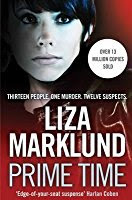 Annika Bengtzon
Annika BengtzonThe first Scandi-Noir character to make the list, and a genuine one-off, as, rather than a detective or secret agent or soldier, Annika is a journalist and a responsible wife and mother.
Created by Swedish crime author, Liza Marklund, Annika’s is a hectic world; a nine-till-five crime reporter for Stockholm’s Kvällspressen (‘Evening News’), her career often interweaves with major issues of the day – Marklund has lots to say about current events – but she also pursues particularly heinous cases, such as in The Bomber, when she investigates what appears to be a terrorist attack on Stockholm’s New Olympic Arena, only to find herself on the trail of a maniac with a more personal grudge, in what turns out to be one of the most intense thrillers you’re ever likely to read. A rarity on this list, in that she rarely resolves problems with her fists or a gun, Annika deals with these horrors daily, and then goes home to make tea for her husband and kids – how tough a challenge is that?
 VI ‘Vic’ Warshawksi
VI ‘Vic’ WarshawksiVictoria Iphigenia Warshawski is one of the toughest fictional female characters in the crime-fighting pantheon. The creation of US novelist, Sara Paretsky, Vic is a Chicago PI of the 1980s, who, while she specialises in investigating white-collar crime, often finds herself in fist fights and shootouts with gangsters. A throwback to the Hard-Boiled era, she’s a tough-talker too, and very streetwise. But she couldn’t be anything less, having grown up in a bad neighbourhood, run with gangs after her parents died while she was still at school, got involved with ‘60s radicals during her student years, and later trained to be a lawyer, which honed off her rougher edges.
Kathleen Turner’s portrayal in the 1991 movie presented her as a hardcase, but also as stylish and breathlessly feminine, whereas in Paretsky’s original, Vic liked to dress down and was more of a fitness freak than a sex symbol. A fascinating, complex character, if you haven’t checked out VI Warshawki yet, you need to put that right.
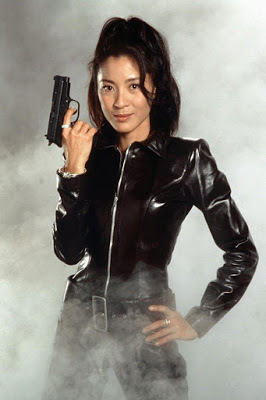 Wai Lin
Wai LinThe first (and only) Bond girl to make the cut, Colonel Wai Lin of the Chinese People’s External Security Force appeared in the 1997 movie,Tomorrow Never Dies, played unforgettably by Malaysian-born Hong Kong action star, Michelle Yeoh.
Her long-standing status as a fully-trained movie martial artist had well equipped Yeoh to play a female character who had to authentically hold her own as an undercover agent and all-out warrior in the macho world of 007. But rather than simply going through the balletic, high-kicking motions, Wai Lin tempered all this with a great sense of humour and playfulness, and at the same time mostly employed skill and subterfuge to get the better of her enemies rather than simply karate-chopping her way to victory. She also stood out among the legions of Bond girls because she firmly and even amusedly resisted 007’s increasingly clumsy attempts to seduce her. One of the stand-out heroines of the Bond mythos, as voted for by most fans.
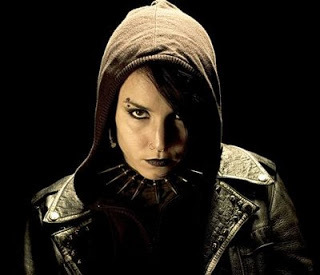 Lisbeth Salander
Lisbeth SalanderOur second Scandi-Noir heroine, and the only Goth girl on the list, Lisbeth Salander played a significant role in the late Stieg Larsson’s highly influential ‘Millennium’ series (kicking off with The Girl with the Dragon Tattoo). After horrendous early life experiences, during which she was sexually abused, neglected and abandoned, Salander became a permanent outsider. Strange in appearance – androgynous, introverted, and possibly suffering from Asperger syndrome – she swiftly matured into one of the world’s most lethally efficient computer hackers, working as an investigator for a private security firm, but developed other skills as well, constantly able to second guess and outwit her enemies, and becoming a virtual chameleon when it came to changing her look.
Not exactly a hardcase, these abilities nevertheless enabled her to take on and defeat a range of deadly enemies, including serial killers, crooked security agents, and international crime syndicates.
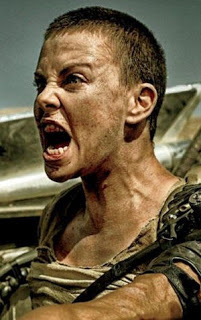 Furiosa
FuriosaThe main female protagonist in 2015’s post-apocalyptic epic, Mad Max: Fury Road, Imperator Furiosa is the second and final sci-fi heroine to make our list, but without doubt one of the most startling. Too often, sci-fi girls have been comic-book-type superhot babes in the Barbarella mode, but there’s nothing of that sort here, despite the role being taken by the beautiful Charlize Theron. Shaven-headed, battle-scarred and fitted with an ugly mechanical arm, Furiosa appears as a military driver for desert warlord, Immortan Joe, who goes rogue when she gets the chance to save five of his unwilling concubines from a fate worse than death, and plays a leading role in all the high-speed battles that follow.
So much of an impact did Furiosa make in this astonishing, breakneck action thriller that even the titular hero dwindled to secondary status. Her unexpected presence in the movie won huge approval worldwide for what was considered a bold feminist statement.
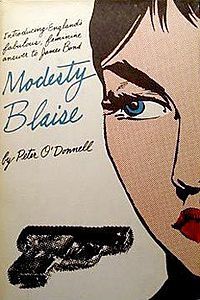 Modesty Blaise
Modesty BlaiseThe only entrant on our list with an out-and-out criminal past, and to have commenced her life in a comic strip rather than a novel or a screenplay. Better known today as a mistress of many talents, an international adventurer, a mercenary, a spy, an investigator, an all-round hero for hire who is as deadly as she is desirable, Modesty Blaise, the glamorous but steely creation of Pete O’Donnell and Jim Holdaway back in 1963, nevertheless has a backstory so harrowing that it’s a miracle she emerged from it sane, let alone as a made-to-measure heroine.
The child survivor of a displaced persons camp at the end of World War II, she wandered the devastated world at first as a nameless refugee, getting involved in more and more scrapes, and learning to survive the hard way, during which process she acquired her name and many rare skills (a lot of which were initially used in crime). Too big a character to live forever in comics, it was no surprise that in due course she made her way into novels, short stories and finally the movies (three to date).
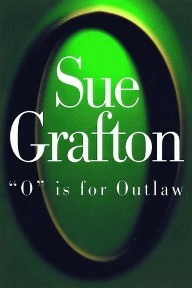 Kinsey Millhone
Kinsey MillhoneAnother fictional heroine – the creation of top US writer, Sue Grafton – who somehow muddled her way into law-enforcement, following what might in real life have seemed an unlikely path.
Though born of wealthy Californian parents, Kinsey learned about life and death the hard way, when, as a child, she was trapped for hours in the same car wreck that killed her mother and father. Raised from that point on by an eccentric older aunt, she became a dopehead delinquent at university, but in due course found her way onto the Santa Teresa police department, where she learned basic detective-work, before finally branching out as a PI and taking on a succession of tougher-than-tough cases, capturing murderers, protecting the innocent and only evading the vengeance of local gangsters by the skin of her teeth. A smart cookie and street-tough rather than a slinky glamour-puss, she went on to star in Grafton’s much-celebrated Alphabet Mysteries.
THRILLERS, CHILLERS, SHOCKERS AND KILLERS …
An ongoing series of reviews of dark fiction (crime, thriller and horror novels) – both old and new – that I have recently read and enjoyed. I’ll endeavour to keep the SPOILERS to a minimum; there will certainly be no given-away denouements or exposed twists-in-the-tail, but by the definition of the word ‘review’, I’m going to be talking about these books in more than just thumbnail detail, extolling the aspects that I particularly enjoyed … so I guess if you’d rather not know anything at all about these pieces of work in advance of reading them yourself, then these particular posts will not be your thing.
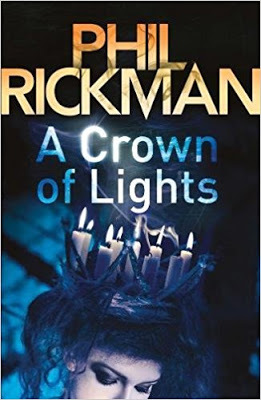 A CROWN OF LIGHTS
A CROWN OF LIGHTS
by Phil Rickman (2011)
When a young pagan couple, Robin and Betty Thorogood, acquire an old farmhouse in rural New Hindwell, they are delighted to discover the relic of an abandoned Christian chapel in the grounds. Immediately, they launch plans to perform rituals there and to reclaim the ancient site for the ‘old religion’ by celebrating the traditional Celtic feast of Imbolc.
But of course, it isn’t going to be that simple.
To start with, Betty Thorogood – the more tuned-in of the two – senses a dark presence in the ruin and an air of foreboding in the encircling Radnor Valley. If this doesn’t worry her enough, the couple’s plans arouse the wrath of Reverend Nick Ellis, the local evangelical minister, who has brought a hellfire message to the UK from his former parish in the American South. Despite Betty’s charm and beauty, Ellis, a man with great charisma but an increasingly sinister fundamentalist agenda, manages to stir up intense local feeling against the duo – to the point where mob violence soon threatens.
Merrily Watkins, local vicar and Diocesan Deliverance Officer, a woman very experienced in tackling the occult, is sent to keep a watch on the volatile situation. But it soon becomes apparent that this is a vastly more complex and frightening problem than even she anticipated. To start with, there are several other bizarre, possibly interconnected issues in New Hindwell: eccentric lawyer JW Weal can’t seem to let go of his recently deceased wife and may well have used nefarious, if not downright evil, methods to hang onto her soul, while at the same time Merrily is disturbed by the rumour that a circle of medieval churches dedicated to St. Michael, originally built to contain a dragon lurking in Radnor Forest, may actually have been located there to entrap a demonic entity.
Above all though, the main threat to peace in this small community stems from the Rev. Ellis, who is much more than just a zealous preacher. Merrily soon comes to doubt his motives and even his beliefs, and finds his followers – who include several local people of note, including the fearsome councillor’s wife, Judith Prosser – a particularly menacing bunch, whose strict loyalty to each other may be concealing a wealth of sins, including murder. In fact, so worried is she by this gathering storm, that she finds herself siding with the pagan newcomers, though they themselves don’t make this easy for her when a whole bunch of them turns up, determined to desecrate the ancient Christian site with their Imbolc rites …
A Crown of Lights is the third outing in the hugely popular Merrily Watkins series, and for my money one of the best. Not that I don’t have a couple of reservations about it.
One key issue I have with the Watkins stories overall is the central heroine’s apparent lack of conviction. It can’t be easy for her; the loss of her husband while she was still young and the hostility she seems to face at almost every turn from her know-all teenage daughter, Jane, must leave her feeling pretty friendless at times. But even so, Merrily, while not exactly beset with doubts about her faith, is hardly the sort of muscular Christian you’d normally expect to occupy the role of exorcist. She doesn’t seem to like anything about her own Church, and nor is she easily convinced that supernatural forces exist (despite much evidence to the contrary in this series).
That said, these apparent weaknesses work in her favour in this particular outing, as the powers soon ranged against her – from all sides, both pagan and Christian – leave her more embattled than we’ve ever seen before, which quickly wins her over to the readers. You always tend to root for the underdog, especially if she gets bullied as often as Merrily does – one scene in particular, when she is unwillingly drawn into a live TV debate with a bunch of militant witches under the control of arch manipulator Ned Bain, has you on her side in no uncertain terms.
Less easy to reconcile is the other issue, which is Phil Rickman’s general reluctance to plunge fully into the world of the weird. There are several ghostly and demonic elements in A Crown of Lights , though it is essentially a clever and absorbing murder mystery, so they remain on the periphery. This is a personal viewpoint of course, but while this subtle combo of thriller and chiller has worked for some, I found the many signposts to the arcane – the ancient churches, the legends, the folklore, the prehistoric monuments with which the wild landscape is littered, the hints of a devilish presence, etc – disappointing, as there is no real fulfilment of that particular promise.
However, this is still an excellent read.
To start with, the incendiary atmosphere in the village is hugely well handled. You wouldn’t normally expect the wintry Welsh Marches to play host to a furious war of words between fanatical religious groups, but it happens here in completely convincing fashion, the hostility simmering throughout the book until the threat of violence feels so real that you can’t help but shudder – there is surely nothing more frightening in both fiction and non-fiction than lynch-law.
It also helps to drive the narrative along that it’s such a multi-stranded mystery, which you simply have to get to the bottom of. A Crown of Lights is an intricate tale, at times almost overwhelmingly so, but it’s massively intriguing – and the reader can rest assured that it all gets tied up neatly at the end.
As always with Phil Rickman’s books, the writing is of the highest order. The gorgeous rural region is beautifully realised, its ancientness and mystery (my earlier comments notwithstanding) evoked in loving fashion. By the same token, the book is a mastery of research. The complex mythology of the Marches is brought vividly to life, while the pagan belief system is richly detailed and made to feel like so much more than silly superstition.
Most interesting of all, though, is the clash of cultures.
Paganism is portrayed as a free-spirited faith, only loosely based on genuine pre-Christian beliefs but unfettered by modernism, unlike Merrily’s ‘rational’ brand of 21st century Christianity in which the exorcist is expected to know as much about psychiatry as doctrine. And this is another key aspect of the book: the war between the old and the new – some of which rages inside Merrily, and between her vision of a kinder Christianity and Nick Ellis’s fire and brimstone, but also out in the wider village community of New Hindwell, which, though it’s hardly the back of beyond, is beset with tradition and was never likely to welcome changes enforced on it by outsiders.
A compelling, thought-provoking novel, very, very readable and highly recommended for lovers of both mystery and mysticism.
As usual – purely for fun, you understand – here are my personal selections for who should play the leads if A Crown of Lights ever makes it to the movies or TV. Thanks to that fine writer, Stephen Volk, Merrily Watkins has already bestridden our television screens in Midwinter of the Spirit, but that was then and this is now, and only a couple of those characters play a role in Crown, so, with the exception of Sally Messham, this is a different cast:
Merrily Watkins – Rachel Weisz Nick Ellis – Billy Bob Thornton Judith Prosser – Catherine Zeta-JonesNed Bain – Hugo WeavingJane Watkins – Sally MesshamBetty Thorogood – Sophie CooksonRobin Thorogood – Nikolaj Coster-WaldauJW Weal – Robert Pugh
(I know, I know … this would be an expensive line-up, but in my imagination I have limitless funds, so yah!)
Published on October 18, 2017 02:18
September 29, 2017
Devious, dangerous men doing dark stuff
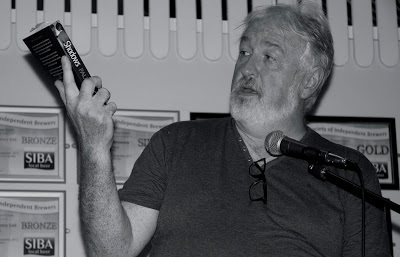
We’re talking street-crime of the heavier variety this week: hoods, hoodlums, muggers, blaggers, gun-toting desperadoes of every sort. That’s partly because we’ve today reached the final countdown to publication of my latest crime thriller, SHADOWS – here I am, unsubtly waving the book around at the recent very successful Noir at the Wigan Bar! – but also because I’ll be reviewing Don Winslow’s epic study of a cop not just at war with the underworld, but with himself, THE FORCE.
As always, that review can be found towards the lower end of today’s column. Before we get there, in reflection of today’s chosen subject-matter, I thought I’d delve into the realms of true crime again, focussing not so much on murderers this week, as on bank robbers. Who were the worst at it, who were the most successful, who were the deadliest? Read on ...
Robbery with violence
SHADOWS is the second outing for my female cop character, Lucy Clayburn, who readers may recall completed a difficult undercover assignment in the first novel, STRANGERS , and in the process brought down a major crime syndicate and ended a serial killer’s reign of terror.
 Not a bad start to her career, you may think, except that Lucy had already been in the job ten years when
STRANGERS
was set, and was something of a veteran, having worked the tough Manchester streets with all the nerve and determination her blue-collar background could muster. So, it should be no surprise that in
SHADOWS
, Lucy, though she’s only a detective constable, is now regarded as a prized asset by Crowley CID, who are not best pleased when she is co-opted onto the Manchester Robbery Squad to tackle a particularly deadly bunch of well-armed bandits, the Red-Headed League, a nickname given to them by their police pursuers mainly because of the blood-red ski masks they wear.
Not a bad start to her career, you may think, except that Lucy had already been in the job ten years when
STRANGERS
was set, and was something of a veteran, having worked the tough Manchester streets with all the nerve and determination her blue-collar background could muster. So, it should be no surprise that in
SHADOWS
, Lucy, though she’s only a detective constable, is now regarded as a prized asset by Crowley CID, who are not best pleased when she is co-opted onto the Manchester Robbery Squad to tackle a particularly deadly bunch of well-armed bandits, the Red-Headed League, a nickname given to them by their police pursuers mainly because of the blood-red ski masks they wear. They are a fearsome bunch indeed. Always equipped with automatic weapons, and always leaving bullet-riddled bodies in their wake.
It’s a great gig for Lucy, who’s nothing if not a toughie, herself, and something of a biker chick in her spare time. But there is one small problem: when it becomes apparent that the targets of these robberies are exclusively criminals themselves – and not just that, but affiliates of the terrifying Manchester crime syndicate, the Crew – the stakes are raised dramatically.
The cops now know they must act fast, because it looks as if a full-blown gangster war is about to erupt …
So, as stated earlier, in honour of this new novel, which I must admit to liking very much (and which hits the shops on October 19), I thought I might focus today on some notorious real-life robbers.
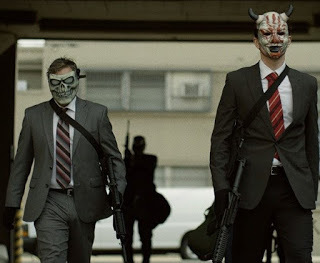 They certainly occupy a strange place in the echelons of crime, these guys. In the eyes of certain members of the public, they dwell in a kind of twilight zone between villain and hero. Though undoubtedly ruthless and violent, this is counterbalanced for some by their audacity and daring. Even certain police officers of my acquaintance have expressed quiet admiration at the skill and planning that has gone into some major jobs.
They certainly occupy a strange place in the echelons of crime, these guys. In the eyes of certain members of the public, they dwell in a kind of twilight zone between villain and hero. Though undoubtedly ruthless and violent, this is counterbalanced for some by their audacity and daring. Even certain police officers of my acquaintance have expressed quiet admiration at the skill and planning that has gone into some major jobs.The brutality, though, is something that really can’t be discounted. In English law, the definition of robbery is theft with violence, or with a threat of violence. There is no getting away from it: when someone commits a robbery, that means someone else, usually someone entirely innocent, is put in terror of injury or death, and may even suffer one or both of those outcomes.
So, I’m not going to lionise these guys, but by the same token, I’m not going to pretend that I’m not fascinated by their exploits. Here are …
FIVE OF THE WORLD’S MOST NOTORIOUS ARMED ROBBERS, AND THE ULTRA-VIOLENT JOBS THAT MADE THEIR NAMES:
 Dillinger Gang
Dillinger GangIn 1933, with the repeal of Prohibition, and the end of easy money provided by bootlegging beer and spirits, America’s criminal underworld had to diversify. And so, the following decade saw a widespread return to that oldest and most traditional form of violent crime, robbing banks.
The rural US was still in many ways reminiscent of the Old West, inasmuch as it comprised numerous small towns isolated from each other by great distances and only connected by miles of empty, often unmarked back-roads. Whereas organised law-enforcement, while relatively light on the ground in the great open spaces of the Midwest, at least had the advantage of now being motorised, the bank robbers were motorised too, and often were equipped with automatic weapons. As such, an entire host of hayseed nobodies, folk who otherwise would have left no ripple on history, became infamous overnight.
Names like Baby Face Nelson, Machine Gun Kelly, Pretty Boy Floyd, Ma Barker and her boys, Wilbur Underhill and, of course, Bonnie and Clyde, were soon synonymous with heavily-armed villainy, the objective of which was usually robbery (though sometimes kidnapping), but the regular consequence of which was blazing gunfire as the participants shot their way out of tight corners, often wounding and killing police officers, bank guards and members of the public. Despite this, most likely because of the Depression and the Dust Bowl disaster – a truly desperate time during which countless unproductive farms and other businesses were unfairly foreclosed, turning bankers themselves into a reviled enemy – these highly mobile bandits attained folk-hero status.
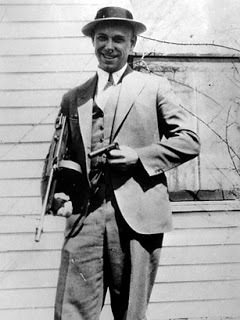 But none more so than John Dillinger.
But none more so than John Dillinger.A rebel since youth (a mutinous seaman in his late teens), Indiana-born Dillinger was convicted of his first serious crime in 1924, when he stole $50 from a grocery, and after being persuaded to confess by his church-deacon father, was sentenced to 10 to 20 years in prison. Stunned by this harsh sentence, he turned his back on his father’s path, and by his own admission, determined to become a ‘mean son of a bitch’. While inside, he befriended seasoned criminal, Harry Pierpont, and studied the bank robbery techniques of a former professional criminal, German-born Herman Lamm, who had utilised military methods – casing the bank beforehand, using stop-watches to time the operation, planning getaway routes, etc – to launch a series of successful raids.
On his release in 1933, Dillinger put together his own gang of hardened outlaws and commenced a robbery spree that would pass into legend, hitting multiple banks and even police arsenals (to steal guns, ammunition and bullet-proof vests) across Ohio, Indiana, Wisconsin and South Dakota. Captured several times, he always managed to escape and continue his activities, chopping and changing his confederates en route (for example, he considered Baby Face Nelson a risk and so cut him loose, but admired Pierpont and worked with him whenever he could).
He successfully stole around $340,000 in total, and engaged in a number of epic gun-battles, leaving ten law officers dead and at least seven critically wounded. Dillinger himself was only believed to have killed one police officer, patrolman Pat O’Malley, during a robbery shootout in East Chicago, though this would undoubtedly, in due course, have sent him to the electric chair.
In some ways this cruel murder belies the myth, because of all the ‘public enemies’ in this era, Dilllinger – either rightly or wrongly – was regarded by the public as the most dashing. This was partly down to his good looks and affable manner with both captives and captors alike, though he is also credited with having spared bank customers during robberies, telling them that he wasn’t after their money, which won him popular support.
Success was ultimately his undoing, when relentless FBI boss, Melvin Purvis, took up the chase with his well-armed, well-trained G-Men. Prioritising Dillinger above all others, they finally tracked him to the Biograph Theatre, Chicago, in July 1934. Ambushed on the way out, Dillinger drew his weapon, and was shot multiple times.
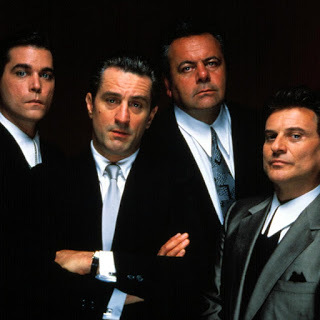 Lufthansa Heist
Lufthansa HeistNot the biggest armed robbery in criminal history, though it was pretty big by almost any standards, the Lufthansa Heist is probably most infamous for its incredible bloody aftermath and for being one of the few of its kind arranged by the American Mafia.
Much cosier in the world of racketeering, gambling and loan-sharking, the 20th century mob rarely indulged in armed robbery simply because they regarded it as a high-risk activity. And if there were any who were unsure about this, after Lufthansa they’d be in no doubt whatosoever.
However, initially it looked like a great opportunity.
The mastermind behind it was Jimmy ‘the Gent’ Burke, an Irish/American associate of New York’s Lucchese crime family and a successful thief who was always considered a safe bet (he was portrayed unforgetably by Robert De Niro in Martin Scorcese’s movie account of the crime, Goodfellas). When, in 1978, Burke was informed that millions of dollars of US currency, the result of money exchanges for servicemen in West Germany and therefore untraceable, was stored in an easy-to-break vault at Kennedy Airport, he took it to his bosses and commenced preparing what at the time looked like a hugely daring but potentially very lucrative robbery.
In the end, three major syndicates would be connected to the Lufthansa Heist, not just the Luccheses, but the Gambino and Bonanno crime families, as Burke would be contravening their respective territories and therefore owed them each a substantial cut. But the robbery itself was carried out by a team of relative unknowns, Mafia shooters and hardmen all – like the fearsome Tommy DeSimone (another searing performance in Goodfellas, this time from Joe Pesci) – but no one who might be considered indispensible.
Burke, himself, didn’t participate, but planned the raid in fine detail, and rehearsed his team mercilessly. On a frosty December 11, in the early hours of the morning, the crew, with the assistance of key insiders, infiltrated the airport holding area, abducting various employees at gunpoint and advising each one that they knew who they were and where they and their families could be found later, should anyone blab – a classic and dependable Burke tactic. Even then there were risks: had the terrorised captives disobeyed orders, and not waited until 15 minutes after the gang had left with their loot before sounding the alarm, the Port Authority Police might have been able to seal the airport in time. But the hostages had been left in no doubt that they and their families would pay dearly if the escape was impeded.
Ironically though, in the long run it was the team themselves who’d pay.
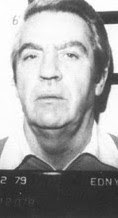 Burke (right) was stunned when the haul amounted to $6 million in cash and jewellery. It was the biggest robbery on US soil at the time, and this worried him. Knowing it would result in a high-level police investigation, which might invite disaster for the New York crime families, he promptly began eliminating those members of the team and their back-up crew, and even those who simply knew about it who might conceivably talk. Before the following summer, nine people had been executed on Burke’s orders, while several more who’d been involved would die violently over the next few years, ‘whacked’ for various indiscretions. One of these was Tommy DeSimone, who was allegedly tortured and chain-sawed in half.
Burke (right) was stunned when the haul amounted to $6 million in cash and jewellery. It was the biggest robbery on US soil at the time, and this worried him. Knowing it would result in a high-level police investigation, which might invite disaster for the New York crime families, he promptly began eliminating those members of the team and their back-up crew, and even those who simply knew about it who might conceivably talk. Before the following summer, nine people had been executed on Burke’s orders, while several more who’d been involved would die violently over the next few years, ‘whacked’ for various indiscretions. One of these was Tommy DeSimone, who was allegedly tortured and chain-sawed in half.Such ruthless ‘house-keeping’ didn’t save Burke. Though never convicted of participating in the heist, he was eventually fingered by notorious mobster-turned-informer, Henry Hill, in the murder of one Richard Eaton, a launderer who had skimmed some of the loot (and was hanged in a freezer truck for his trouble), and was sentenced to life imprisonment
Ultimately, the Lufthansa Heist’s fantastic pay-off was a disaster even for its senior supervisors, because it put the New York mob more squarely in police sights than they’d been for decades. Paul Vario, the Lucchese underboss who had authorised the crime, and who Hill also testified against (though for other offences) died in jail in 1988. Jimmy Burke followed him to the grave in 1996.
Great Train Robbery
Without doubt the most legendary armed robbery in British history, and probably one of the most famous in the world – but in truth, for all the wrong reasons.
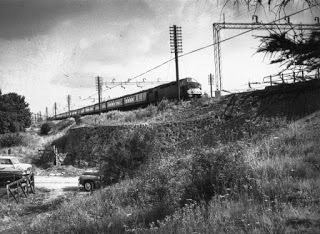 In the early hours of the morning on August 8, 1963, a team of 15 London heist-men bushwhacked a Royal Mail train en route to London from Glasgow via the West Coast Line. The intention was to steal cash-bags from the HVP (high value packages) compartment, which, as the previous weekend had been a Bank Holiday in England, were expected to contain a total of several millions in cash – a staggering sum in the early 1960s.
In the early hours of the morning on August 8, 1963, a team of 15 London heist-men bushwhacked a Royal Mail train en route to London from Glasgow via the West Coast Line. The intention was to steal cash-bags from the HVP (high value packages) compartment, which, as the previous weekend had been a Bank Holiday in England, were expected to contain a total of several millions in cash – a staggering sum in the early 1960s.The crime went ahead as planned, and initially seemed like a complete success, the robbers, who hadn’t even taken guns with them, getting away with £2.6 million in used and untraceable bank-notes (the mere feat of moving so much cash in such a short time was seemingly admirable, and involved the clever device of stopping the train on Bridego bridge in Buckinghamshire, where the gang formed a human chain to a waiting truck).
When the news broke, it captured the imagination of the whole country. There hadn’t been a major train robbery in the UK since Victorian times, and immediately it was portrayed in the popular press as an astonishing feat of daring. Mental images were conjured of intricate planning beforehand, of Jesse James-type bandits leaping onto the train while it was still in motion, running along the roof, and performing all kinds of heroics and derring-do. Surely, these could only be experts in the field, criminal geniuses and gentleman thieves of the old school, so sure they didn’t want to hurt anyone that they didn’t even take firearms, and yet still getting clean away afterwards, having been rewarded for their sterling efforts with a monumental haul?

 But such thinking was fanciful and wildly inaccurate.
But such thinking was fanciful and wildly inaccurate. Firstly, the team, while comprising experienced thieves and undoubted London characters like Buster Edwards (right) and Bruce Reynolds (left, who led the raid), was not considered to be one of the city’s major firms, and previously had specialised in hitting soft targets. Ronald Biggs, who achieved lasting fame through his decades-long evasion of justice, was a petty-villain whose only real job was to recruit a train driver who could handle the train (in which cause, he palpably failed).
The essential inside information provided to the team, and enabling the crime to happen, came from a self-interested Northern Irish contact known as ‘the Ulsterman’ (later named as postal worker, Patrick McKenna), who took a big chunk of the poceeds and was never caught.
The raid itself, while well executed, included no real feats of daring. The train was stopped by a fake signal light, and the driver, Jack Mills, beaten with an iron bar – which was hardly heroic (and which, though no firearms were used, indicates that the gang were armed with coshes and more than willing to use them).
 In addition, they were lucky. The security fixtures on the HVP carriage, which included locks and alarms, were not effective because a reserve carriage was being used, and rather ridiculously, there were no security guards on board. The retired train driver called ‘Old Stan’, who’d been brought along by Biggs (right) to move the captured train to the designated robbery site, was unable to perform his job, and so the injured driver, Jack Mills, was forced to do it, despite being semi-conscious.
In addition, they were lucky. The security fixtures on the HVP carriage, which included locks and alarms, were not effective because a reserve carriage was being used, and rather ridiculously, there were no security guards on board. The retired train driver called ‘Old Stan’, who’d been brought along by Biggs (right) to move the captured train to the designated robbery site, was unable to perform his job, and so the injured driver, Jack Mills, was forced to do it, despite being semi-conscious.The gang’s planning also fell short when it came to the getaway. Lying low at an abandoned farmhouse close to the scene, and only realising when it was almost too late that they’d be snared by the resulting police dragnet, a panicked departure meant they left several of their vehicles behind, and failed to properly clean the hideout of prints, while the ultimate final precaution, burning the place to the ground, was left to an unreliable accomplice, who never performed the task.
Errors like these, along with the tenacity shown by London’s elite Flying Squad, was the doom of the Great Train Robbers, most of whom were eventually arrested and sentenced to exemplary prison sentences – 25-30 years in most cases. Even those like Edwards and Reynolds, who fled abroad, were eventually captured and convicted.
Injured train driver, Jack Mills, suffered brain damage and never fully recovered, dying in 1970. The £250 he received in criminal injury compensation was seen as an outrage compared to the £65,000 paid to Ronnie Biggs’ wife, Chamian, when she sold her story to the papers.
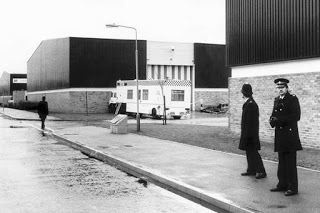 Brink’s-Mat
Brink’s-Mat Committed at the Heathrow Airport Trading Estate, London, in 1983, the Brink’s-Mat robbery, which saw the loss of £26 million in gold bullion, diamonds and cash, was initially regarded as ‘the crime of the century’, and in many ways, ‘a British Lufthansa’. That latter comparison would, in due course, be much more appropriate than anyone could have imagined at the time. Because not only was the crime conceived of and executed by some of London’s most senior criminal elements, it eventually resulted in a range of arrests, convictions and lengthy prison sentences, but also a string of gangland slayings.
The raid occurred late at night in the November of that year, the crew, led by underworld tough guys Brian Robinson and Micky McAvoy, gaining entry to a warehouse containing properties belonging to Johnson Matthey Ltd. Assistance in this was provided by corrupt security guard, Anthony Black, who also happened to be Robinson’s brother-in-law, but who would later prove to be a weak link in the chain. The rest of the security team were bound hand and foot, and after being drenched in petrol and threatened with lit matches, they gave up the codes to the vault. But the robbers, who were looking for around £3 million in cash, hadn’t expected to discover the bullion, and now found themselves in possession of an absolute fortune.
Though they’d removed it from the premises in under two hours, any triumphalism the gang might have felt at the success of the operation was due to be shortlived.
Black was pressurised by the police, and in his turn implicated Robinson and McAvoy, though neither had exactly kept a low profile, both splashing money around, and McAvoy acquiring two guard-dogs for his new house in Kent, and naming them Brinks and Mat. In the end, it was a no-brainer, both men receiving 25-year sentences.
 Police pursuit of the bullion was less rewarding.
Police pursuit of the bullion was less rewarding. To avoid attracting attention by trying to sell pure gold, infamous gangster Kenny Noye was recruited to melt it down and mix it with copper and brass. £13 million’s worth of precious metal was disposed of this way, though Noye was arrested after stabbing to death an undercover detective who was onto his scheme. He evaded conviction for this on the grounds of self-defence, the killing having happened in his own back garden, but was later charged with handling the Brink’s Mat gold and jailed for 14 years. (It was all downhill for Noye after this, when, two years after release, in 1996, he committed murder during a road rage incident, and was sent to prison for life).
Though at least £10 million of the gold remains unaccounted for, much of it still thought to be hidden and awaiting collection, it still went badly wrong for many of those connected to the crime, because the London underworld – as in the case of the Lufthansa Heist – quickly started feeding on its own. Maybe as many as 20 of those connected to the robbery paid the ultimate price, so many in fact that it became known as the ‘Brink’s Mat Curse’. This included John Palmer, a jeweller and bullion-dealer known as ‘Goldfinger’, who was gunned down in the garden of his Essex cottage, and former Great Train Robber, Charlie Wilson who’d by this time diversified into money-laundering, shot dead on the doorstep of his Spanish home, along with his pet dog.
There were other consequences from Brink’s Mat, the enormous haul said to have financed the flooding of Britain with ecstasy, which, more than any other illegal substance, is thought to have persuaded the UK’s most dominant firms that more money is now to be made from narcotics than armed robbery.
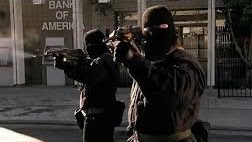 North Hollywood Shootout
North Hollywood Shootout In 1995, Michael Mann successfully remade his armed robbery-themed TV movie of 1989, LA Takedown, renaming it Heat, and packing it with star power (the second Robert De Niro movie to be referenced in today’s blog, showing how on the money the great man was when it came to intense crime dramas), and pumping up the action quota massively with a much larger budget.
One of the most impressive sequences involves a bank robbery going wrong, and an immense, spectacular and protracted shootout resulting between the movie’s main hoodlums and the LAPD, which results in the police being overwhelmed by the astonishing level of firepower the villains direct at them, and seemingly half the city suffering demolition in the process.
It’s an amazing scene of excessive violent and rampant lawlessness, which one could thankfully never envisage occurring in real life. Right?
Wrong.
Only two years later, the Bank of America in North Hollywood was robbed by two heavily armed and armoured bandits, whose attempted escape was intercepted by the LAPD, and the ensuing shootout shocked the world, especially as it was screened live and from multiple different angles by numerous TV crews and news stations.
All of the heists in today’s blog ultimately failed, though in most cases the robberies themselves were completed successfully. This entry is the exception to that rule, but the North Hollywood Shootout was so memorable an event that it still figures highly in all lists of the most astonishing violent crimes.

 The perpetrators were Larry Phillips, Jr (right). and Emil Mătăsăreanu (left), two hardened armed robbers and gun buffs, who had already killed one guard in a different job, and had become notable to law enforcement for the massive firepower they utilised, which included automatic rifles and improvised explosive devices. Known as the High Incident Bandits, by 1997 the proceeds of their crimes already topped $1 million, but the North Hollywood attack was to be the big one.
The perpetrators were Larry Phillips, Jr (right). and Emil Mătăsăreanu (left), two hardened armed robbers and gun buffs, who had already killed one guard in a different job, and had become notable to law enforcement for the massive firepower they utilised, which included automatic rifles and improvised explosive devices. Known as the High Incident Bandits, by 1997 the proceeds of their crimes already topped $1 million, but the North Hollywood attack was to be the big one.On the morning of February 28, they entered the bank, which was located on Laurel Canyon Boulevard, wearing the latest high-tech body-armour, bandoleer belts and pouches containing spare magazines and thousands of rounds of extra ammunition. Their weapons included HK-91 battle-rifles, automatic assault rifles and carbines. But such conspicuous attire was to backfire on the duo badly, when they were spotted by local patrolmen, who immediately summoned reinforcements.
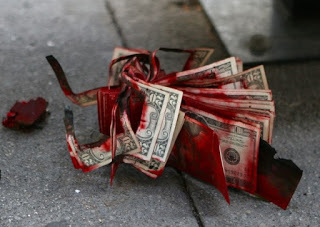 Even inside the bank, Phillips and Mătăsăreanu didn’t have it all their own way. They successfully cowed the staff and customers, and gained access to the vaults, but there’d been a change in recent delivery schedules, and so only a third of the money they’d expected was to be had: approximately $300,000, though even this was rendered unusable when its dye packs detonated (above). Driven to fury, a state of mind in no way assuaged by the phenobarbital they had both taken beforehand, they responded by opening fire at the bank’s fixtures and fittings, doing wholesale damage.
Even inside the bank, Phillips and Mătăsăreanu didn’t have it all their own way. They successfully cowed the staff and customers, and gained access to the vaults, but there’d been a change in recent delivery schedules, and so only a third of the money they’d expected was to be had: approximately $300,000, though even this was rendered unusable when its dye packs detonated (above). Driven to fury, a state of mind in no way assuaged by the phenobarbital they had both taken beforehand, they responded by opening fire at the bank’s fixtures and fittings, doing wholesale damage.Immediately on leaving, they were challenged by cops now surrounding the bank, but responded with a storm of gunfire. Officers responded in kind, but their pistols and shotguns were no match for the felons’ body-armour. To the disbelief of the everyday citizens passing by, a full-scale gun battle erupted, the robbers advancing steadily, hit repeatedly but driving the cops backwards, leaving them wounded all over the roads and pavements, and blowing their patrol cars to pieces. When a SWAT team finally arrived, 18 minutes of near nonstop gunfire had passed and yet the shootout was still raging, having caused so much carnage that the specialists’ first task was to drive in with an armoured vehicle in order to evacuate the many wounded.
However, despite appearances, the robbers were not immune. Though they fought their way into a nearby parking lot, where they were able to retrieve more weapons and ammunition from their getaway car, they had both by now been severely injured. In the incredulous gaze of the news teams hovering overhead, Philips, shot several times, attempted to escape on foot, making it onto Archwood Street, blazing in all directions before finally taking his own life. Mătăsăreanu, bleeding profusely, drove a short distance in the getaway car, before hijacking another vehicle. Unable to operate a stick-shift, he continued to put up stiff resistance, holding the encroaching SWAT men off for almost another five minutes, before, too badly wounded to shoot anymore, he surrendered – only to die from blood-loss in the ambulance.
Some 2,000 rounds of ammunition were fired by the robbers, and 12 police officers and eight civilians were seriously injured. The Medal of Valour was later awarded to 19 of the cops involved, but questions were asked about what on Earth kind of society might find itself in need of police officers who are armed and armoured like combat troops.
THRILLERS, CHILLERS, SHOCKERS AND KILLERS …
An ongoing series of reviews of dark fiction (crime, thriller and horror novels) – both old and new – that I have recently read and enjoyed. I’ll endeavour to keep the SPOILERS to a minimum; there will certainly be no given-away denouements or exposed twists-in-the-tail, but by the definition of the word ‘review’, I’m going to be talking about these books in more than just thumbnail detail, extolling the aspects that I particularly enjoyed … so I guess if you’d rather not know anything at all about these pieces of work in advance of reading them yourself, then these particular posts will not be your thing.
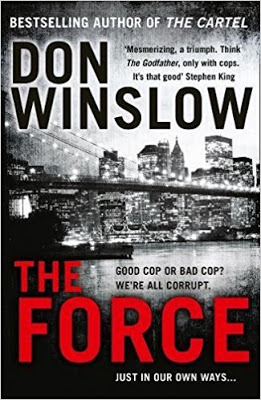 THE FORCE
THE FORCE by Don Winslow (2017)
It’s a strange thing, but given that this epic-in-concept and epic-in-execution police thriller fills its 400+ pages with furious action, intense character clashes, crackling dialogue, emotional tangles and moral complexities that basically leave you breathless, not to mention some mind-bending ‘revelations’ about life and death deep in the NYPD, it all kicks off with an event that occurs five months before the book’s main narrative even starts, when the elite Manhattan North Special Taskforce, known simply as ‘Da Force’, pulls off a major drugs bust.
It’s the prize of prizes for streetwise Detective Sergeant Denny Malone, and his cadre of ultra-loyal sidekicks, Phil Russo, Bill ‘Big Monty’ Montague and young Billy O’Neil. Such a prize should have made their names as New York detectives forever. Except that this isn’t the way things work in this neck of the woods. The team, who naturally are corrupt to a man, stand by while Malone calmly executes Dominican cartel boss, Diego Peña, who otherwise would get in the way of their proposed theft of his product – but before they can make off with a very sizable portion of the haul, young Billy himself dies when he accidentally absorbs pure heroin through a series of fresh cuts.
These are the highs and lows of life in Da Force. They’ve lost yet another of their own, but at least the rest of the guys, who are near enough all family men, will have no problem meeting medical bills and putting their kids through college. Unfortunately, the wheels put in motion by this act of criminality don’t stop turning here; in fact, they spin faster and faster and ever more out of control.
We roll forward now to the following Christmas, and find the Manhattan North Special Taskforce freewheeling as always along the high-risk path of keeping the mean streets of Harlem clean and at the same time enriching themselves at the expense of the underworld, always cleverly – admirably so, in fact – but often violently too.
Malone is the heart and unofficial leader of this small, but very efficient crew. An Irish cop descended from a line of Irish cops, heroism and defiance are in his blood – his brother, Liam, a fireman, died on 9/11. Meanwhile, Malone’s estranged wife and kids live in a kind of safe ‘Copland’ enclave on Staten Island and are well supplied with everything they need, because though he’s a badass of colossal proportions, Malone also knows what matters to him.
Little wonder he sees himself as the King of Manhattan North, a kind of backstreet lawgiver, underappreciated for sure, but nevertheless handing down a real brand of justice as opposed to the vanilla stuff you get from the courts.
In truth, Denny Malone is a character we’ve seen before, though in my experience never quite as multi-dimensionally as he is portrayed here. He is an antihero, yes; he is brutal, yes; he is a casual user of profane and racist language, yes. But he is also brave, smart, tough and possesses bags of flawless instinct and low-key political acumen. He is also unswervingly loyal to his brother cops, and though it may seem like a huge contradiction, he genuinely believes that he is doing the right thing.
To Malone, small-scale police corruption is standard behaviour. Its proceeds are only what these men and women are owed in return for the danger and horror they face daily, and represent a small fraction of the reward they know they will never get from the uncaring power-structure above them, the one side of which is too busy acquiring privilege for itself to view them as anything other than expendable pawns in a deadly game of chess, the other side of which, politically motivated in a different way (as embodied by the likes of Black Lives Matter – yes, The Force , though a timeless tale, is a very current novel), views them as scapegoats for an unequal society, who should be made accountable for the establishment’s many sins.
Even so, street-smart and righteous though they may consider themselves to be, the Force’s cowboy lifestyle is never going to be a particularly safe option. They take a big chance with young Billy’s replacement, greenhorn Dave Levin, but the real dangers are posed by the likes of seriously dirty and very stupid cops like Rafael Torres, who are many in number (at least, they are in this novel) and who never cover their backs sufficiently, a folly for which everyone – and that means everyone! – is soon going to pay.
There is one other factor, though, which helps to blind Malone’s otherwise all-seeing eye to this very real weakness in the system: everyone else is as corrupt as he and his buddies are, if not worse.
In The Force , Don Winslow presents us with a world of law enforcement where it’s almost the norm for police officers to put things in their pockets when they attend crime scenes, to only ever hand over half of the drugs they seize, to steal stolen money again rather than return it, to tax the criminal lower orders and take bribes from those who are higher up. And it isn’t just the police. The judiciary and the political administration of the city are up to their necks in dodgy dealing as well. Everyone, it seems, resents those who have power over them, everyone thinks they are undervalued and underpaid, everyone considers that they only purloin what they are fully entitled to, and almost everyone is content to turn a blind eye to the next office along’s countless indiscretions on the understanding that this favour will be returned and the process perpetuated.
Almost everyone.
And this is the beginning of Denny Malone’s undoing. Because though he’s constantly able to outfox the squeaky-clean but largely uninformed Captain Sykes, a crusading internal investigations unit then turns up, comprising the untouchable feds, O’Dell and Weintraub, and the superhot, supercool attoney, Isobel Paz. When this new, energised and higly powered outfit is able to implicate the ne’er-do-well cop in corrupt practises through his attempts to negotiate a crooked legal deal, there is a dramatic shift of power.
Suddenly, Malone finds himself in big trouble. He can get himself off the hook if he will serve up all his corrupt pals, but he obviously doesn’t want to do that – these are fellow cops, his blood-brothers, much closer than the kind of run-of-the-mill buddies that civies have. Through various Machievellian intrigues, he finally brokers a maybe-acceptable deal, in which he will turn over the city’s corrupt lawyers. But even more Machievellian intrigues further up the food-chain contrive to confound this.
Meanwhile, the everyday problems of cop life are also becoming an issue. There is huge racial tension in the city after a white officer shot a black kid. Major disturbances threaten while the Grand Jury deliberates, and even Claudette, Malone’s beautiful black girlfriend, wants to put distance between them both. At the same time, routine turf wars are in the offing between gangs who formerly were at peace. And then there is the uber-ruthless Peña cartel, from whom Malone stole at the very beginning of this dramatic tale. They don’t forgive, or forget …
There is no doubt that Don Winslow is the modern master of the broad-canvas crime story. And yet, his material is never less than completely shocking.
While he apparently worked for months with the NYPD to gain the special insights needed to create this enormous and enormously powerful saga of right and wrong and the multiple grey areas in between, it ultimately casts the New York police in a very bad light. At times, I was gobsmacked by the open assertion that so much of the city’s towering law-enforcement, legal and political structure is bent. The innocent soul within me even came to doubt the accuracy of this, though in the long run, whether it’s a true depiction or not doesn’t really matter, because it gives us a tumultuous backdrop to this most enthralling study of a man (and his world) on the edge of an abyss.
Okay, we may have been here before. Joseph Wambaugh’s The Choirboys is one obvious source of inspiration (Da Force do booze-ups, or rather ‘Bowling Nights’ as they call them, in the most extreme and joyous way imaginable), but I caught more than a few glimpses of The Shield as well (Denny Malone even shares Vic Mackey’s penchant for jeans and black T-shirts!), while in the character of the lovely, heroin-addicted nurse, Claudette, there was a glimpse of the doomed Isabella in Daniel Petrie’s Fort Apache, the Bronx . But really none of that matters, because The Force goes much further along the line than any of those other great pieces of work, with a unique and muscular identity all of its own. In fact, the experience of reading it is so intoxicating, so real, that you’re basically out there on the streets with the guys themselves, kicking tenement doors down, busting the ‘mopes’ and the ‘skels’.
Each page is stacked with completely convincing NYPD detail; the procedures and protocols are all there, the attitudes and language – the language has drawn some criticism for projecting a clichéd New York cop tone, and one brickbat I sympathised with took issue with the cops’ apparent belief that they could do terrible things to and say awful stuff about ethnic communities because they had earned the right – but I still found it completely compelling.
The rooting for the bag guys thing is always something of a challenge. But not here. Not because they are softened by being tough guys with hearts of gold. They haven’t got hearts of gold; but they’ve been sucked into a negative way of life almost from the word-go, which offers no ways out, and yet because it allows them to beat, cripple, blackmail and kill the city’s very worst elements – yes, the vigilante element is strong with this one! – they are persuaded that it’s all okay. And that has a similar effect on us, albeit briefly.
These guys really are the strong arm of the law, we think, the thin blue line, civilisation’s only real defence against a horde of beasts. To deal with violence, you must show … well, violence.
Hardly an ideal scenario, of course. Few of us would actually approve of it. But in The Force you at least see how it happened. In Denny Malone’s own words:
‘How do you cross the line? Step by step.’
After his emotionally-wrenching The Cartel , in which we watched a beautiful society be systematically torn apart by criminals who were more like wild dogs, The Force is a huge change of pace and direction for Don Winslow. Yes, it’s savage, hardbitten and deals with edgy characters at the sharpest end of human experience, displaying both the best of them and the worst, but whereas The Cartel was a very serious statement about the plight of a country competely at the mercy of corrupt officials and organised crime, The Force is more of a personal experience – the progress of a damaged but likeable soul forging his way through a world of darkness, and yet, though constantly seeming to do the wrong thing, gradually edging closer and closer to that redemptive moment when he finally does the right thing (oh, and with plenty of frenzied and explosive action along the way).
Read The Force . That’s all I’m going to say. You don’t have to be a fan of crime, thriller, mystery or cop fiction. As long as you don’t mind being smacked in the face repeatedly by prose as tough as Brooklyn brickwork, you should find this novel a major, major experience.
And now, as usual, though it’s utterly pointless, I’m going to try and cast it. I say it’s pointless, because the book apparently sold to Hollywood before it was even published, and for no small fee (not jealous at all). But I’ve not heard much about it as yet, so I’m going to try and get my suggestions in first. If Don decides that my ideas are better than whoever gets the casting director gig, he knows where to send the cheque. Here we go:
Det. Denny Malone – Chris HemsworthDet. Phil Russo – John BernthalDet. Bill ‘Big Monty’ Montague – Forest WhitakerSheila Malone – Jessica ChastainClaudette – Gabrielle UnionO’Dell – Ben McKenzieLou Savino – Joe MantegnaBenjamin ‘Nasty Ass’ Coombes – Tyler James WilliamsStan Weintraub – John C. McGinleyIsobel Paz – Eva LongoriaGerard Berger – William Fichtner Det. Dave Levin – Justin LongDet. Rafael Torres – Javier BardemCaptain Sykes – Don CheadleDeVon Carter – Lance ReddickJanice Tenelli – Michelle RodriguezInsp. Bill McGivern – Jon VoightMary Hinman – Ann DowdCarlos Castillo – Steven BauerBryce Anderson – James CromwellStevie Bruno – Michael BadaluccoDiego Pena – Luis Guzman
(I know … what a cast that would be. But then … what a novel).
Just for your interest, the two images used today that don’t actually speak for themselves, the armed robbers with the horror masks, and the gunmen emerging from the Bank of America, are lifted from two crime movies. Respectively: The Last Heist (2016), and 44 Minutes: The North Hollywood Shootout (2003).
Published on September 29, 2017 02:26
September 10, 2017
Just how cool are those great book covers?
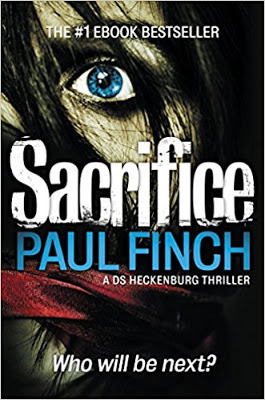 The focus is squarely on crime fiction today.
The focus is squarely on crime fiction today.
A timely thing, I suppose, with the publication of my next crime novel, SHADOWS, just around the corner. But we’re also going to have a bit of a chat this week about book covers – and what makes a good one. To illustrate things, but also for a bit of fun, I’ve put together a gallery of my 25 best ever crime novel covers. You can find that a bit further down.
Also on the subject of crime fiction – but at the really hard end of the spectrum – I’m offering a detailed review of Sam Hawken’s amazingly bleak and chilling debut novel, THE DEAD WOMEN OF JUAREZ . As usual, you can find that at the lower end of today’s column.
Cover story
The first thing to say is that it’s amazing how divisive book covers can be. They don’t just divide fans and readers, they can divide writers from agents and agents from publishers.
Essentially, a book cover is a work of visual art, so there is always going to be a degree of dispute. It’s in the eye of the beholder; it’s a purely subjective exercise. Of course, this doesn’t stop writers being upset when their books are allocated artwork they don’t like, though by this stage of the operation, the publishers are generally more interested in what the readers think, and they’ll have attempted to anticipate this by taking detailed reports from their market-research people beforehand, will have studied the sales figures for recent similar products, and so forth (something the writer will almost never have done).
Of course, it it all goes wrong then, and the public don’t buy, the publishers can still fall back on that timeless and excellent adage: You can’t judge a book by its cover … which will likely do nothing to placate the disgruntled writer who hated the cover in the first place, though the irony is that this famous old saying so often reflects reality.
You really CAN’T judge a book by its cover, even though we’re all regularly guilty of doing exactly that. It’s astounding how often a poor book is ‘bigged up’ by an extraordinary cover, though maybe it’s more frequently the case that a incredible book is lost behind a rather ordinary cover.
To get to the root of this knotty problem, the real question that perhaps needs addressing here is what purpose does a book’s cover actually serve?
Well, to start with – and this is purely my own opinion, of course (though I always welcome others) – the cover’s job is not to paraphrase what’s in the book. Nor is it to tease you about what’s in the book. It’s not even to try and sell the book.
 The book’s cover has one purpose only: to attract your attention while you’re wandering the endless aisles of books-for-sale; to literally make you stop in your tracks, take the book from the shop shelf and examine it more closely. At that point, the cover’s job is done. From here on, the back-cover blurb takes over. Yes, it’s the blurb, not the cover, whose job it is to make you buy.
The book’s cover has one purpose only: to attract your attention while you’re wandering the endless aisles of books-for-sale; to literally make you stop in your tracks, take the book from the shop shelf and examine it more closely. At that point, the cover’s job is done. From here on, the back-cover blurb takes over. Yes, it’s the blurb, not the cover, whose job it is to make you buy.But the upshot of all this is that the best book covers must, at the very least, be eye-catching. An effective cover has got to depict something that will hook you in an instant. And that doesn’t have to be something totally relevant to the book, though I think most publishers would consider it a bit naughty if the cover was completely irrelevant. In my view – and again it’s only my personal view – that would be mis-selling the book.
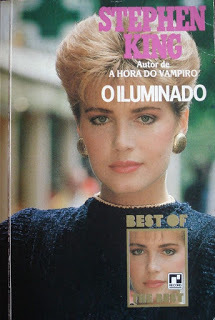 For example, check out this famously outrageous Brazilian edition of Stephen King’s The Shining. Now, there is a strong and attractive woman in the The Shining – Wendy Torrance, but I don’t remember full-on glam and glitzy jewellery having much part to play.
For example, check out this famously outrageous Brazilian edition of Stephen King’s The Shining. Now, there is a strong and attractive woman in the The Shining – Wendy Torrance, but I don’t remember full-on glam and glitzy jewellery having much part to play.Only the good stuff
But I digress. We’re less interested today in trashy covers, and more interested in really good ones. I’ve been fortunate throughout my career to date to have had what I consider to be some pretty effective artwork gracing the covers of my novels. I think my favourite is still SACRIFICE (2013), the second Mark Heckenburg novel, which concerns a series of kidnappings followed by sacrificial murders occurring in concert with certain dates in the calendar. The original Avon cover can be viewed at the top of this column, and strongly hints at the crime/horror combo which made this book the fastest selling pre-order in HarperCollins history at the time.
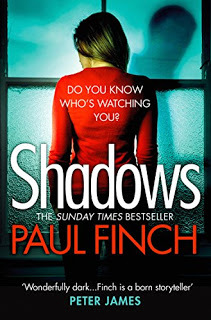 But I’m also a big fan of the jacket to my new title,
SHADOWS
, which can be seen here. This is number two in the Lucy Clayburn series, and has perhaps a more down-to-Earth emphasis, throwing a young female cop into the tough male world of the Manchester Robbery Squad and pitting her against a gang of relentless and ultra-violent blaggers.
But I’m also a big fan of the jacket to my new title,
SHADOWS
, which can be seen here. This is number two in the Lucy Clayburn series, and has perhaps a more down-to-Earth emphasis, throwing a young female cop into the tough male world of the Manchester Robbery Squad and pitting her against a gang of relentless and ultra-violent blaggers.But I don’t want to use this blog just to talk about me all the time, and, as I mentioned at the top, I thought today might be an opportunity to throw the net more widely and focus on some of the other truly excellent book covers that I’ve encountered over the years. This blog normally concerns itself with what I call ‘dark fiction’ – which is a general term for a very big field. So today, for the sake of brevity, we’re going to concentrate on crime fiction covers. My intent, in a couple of weeks or so, is to look at the best thriller covers, perhaps after that the best horror covers, and then maybe the best fantasy, the best science fiction and so forth.
But, as I said, for today, we’re sticking solely with what in my opinion, in no particular order, are …
The best 25 crime fiction covers ever …
(One quick point: I’ve only selected this gallery from English language editions – if I was to scour the whole world of published works, I couldn’t even get close to assembling a realistic list within an acceptable time-frame).
1. POPPET - Mo Hayder
(Bantam, 2013)
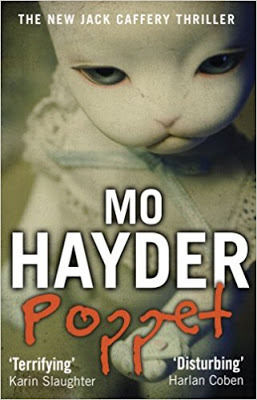
One of the creepiest crime covers ever jackets this seventh outing for DI Jack Caffery, in which he investigates a series of ghastly incidents occurring inside a secure hospital for the criminally insane. It’s every bit as disturbing as its cover suggest, but what can I say?, Hayder doesn’t do vanilla crime ...
2. NIGHT DOGS - Kent Anderson
(Bantam, 1998)
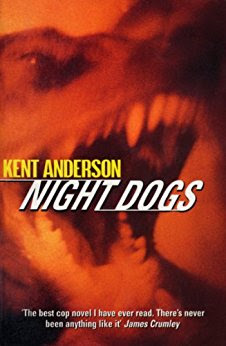
Sheer savagery promises from this jacket, and that’s exactly what you get when a battle-scarred Vietnam vet trades his combat fatigues for a badge with Portland PD, only to find the gunfire-riddled North Precinct one of the most dangerous beats in the city, especially when not every other cop you’re working with has got your back ...
3. THE HOODS - Harry Grey
(Crown, 1952)
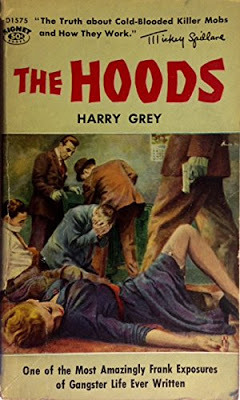
A very to-the-point illustration makes no bones about what you’re going to find in this largely fact-based study of a crime syndicate’s rise to power in New York City of the bootlegger era. Controversial on its release, and very hard to find now, though most crime fans will know it from the epic movie adaptation: Once Upon a Time in America ...
4. HALLOWE’EN PARTY - Agatha Christie
(Fontana, 1980)

Originally published in 1969 by the Collins Crime Club, this later but famously horrific cover from Fontana nicely encapsulates an equally horrific premise, one of the most chilling ever in fact, with ex-Brussels police detective-turned-PI, Hercule Poirot, called on to investigate the deliberate drowning of a child in an apple-bobbing tub during a tempestuous Halloween party ...
5. THE AXEMAN’S JAZZ - Ray Celestin
(Pan, 2015)
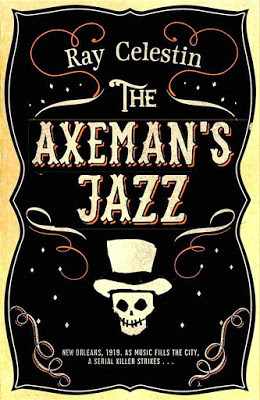
As you’d probably expect from this amazing artwork, the New Orleans of 1919 - the sights, the sounds and even the smells - come vibrantly to life in this amazing debut novel. It also pits a trio of disparate individuals against the true life maniac who terrorised the city during that long hot summer, the notorious Mad Axeman ...
6. ENTER THE DARK - Chris Thomas
(Bloodhound, 2017)
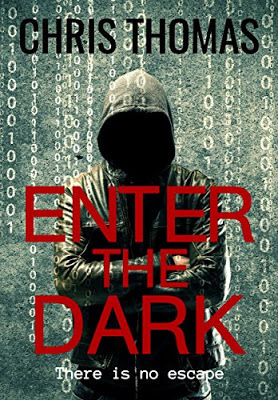
Just in case you needed reminding about those faceless enemies of civilisation who always seem to lurk in the dark places of the internet, up steps Chris Thomas with a cover that more than does his new book justice. Mix advanced proficiency online, high-level cybercrime and a frightened world’s unspoken desire for vigilante justice, and you have a real terror tale. Here is is ...
7. GET CARTER - Ted Lewis (Soho Syndicate, 2014)
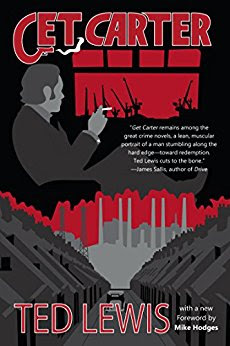
Originally published as the seminal Jack’s Return Home in 1970 by Michael Joseph (and that was a pretty spiffing cover too), this is the latest re-issue of the crime classic, and my favourite to date. Grimy northern England of the late ’60s is the setting as London enforcer Jack Carter returns home to investigate the mysterious death of his brother ...
8. PICK YOUR VICTIM - Pat McGerr (Doubleday, 1947)
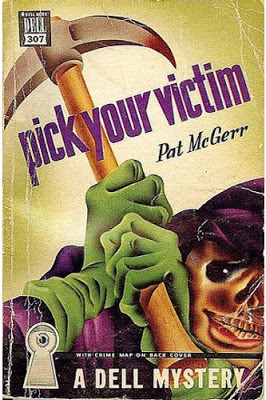
An odd cover given the premise of the story, but undeniably eerie and eye-catching. The novel, now recognised as a classic of crime fiction’s ‘golden age’, features a bunch of military men on a remote base, and sees them passing the time by piecing together a murder mystery, and its solution, from fragments of newspaper packaging. Ingeniously clever ...
9. DIRTBAGS - Eryk Pruitt (Immortal Ink, 2014)
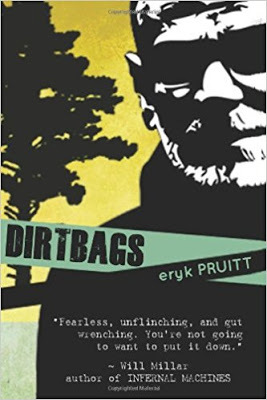
More than a hint on offer here of the Southern Noir nightmare that erupts when two trailer trash losers, each one a violent psychopath in his own right, dream of being serial killers, and one day get the chance to make fantasy reality when they are hired to carry out a brutal assassination. Yes, it’s absolutely as hard and gritty as this jacket will lead you to expect ...
10. THE DOLL MAKER - Richard Montanari (Sphere, 2015)
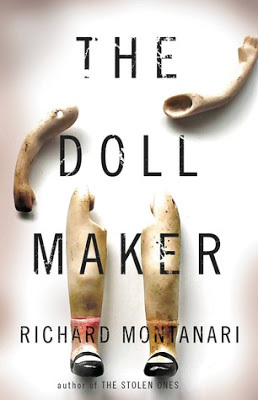
If this one implies that you’re in for a tale of ‘crime meets body-horror’, then you aren’t far wrong, as Montanari’s regular detectives, Byrne and Balzano, scour Philadelphia in pursuit of the charming, erudite and completely crazy Mr Marseille, who will do anything for his beloved Anabelle, no matter how horrifying ...
11. HOW THE DEAD LIVE - Derek Raymond (Melville International, 2011)
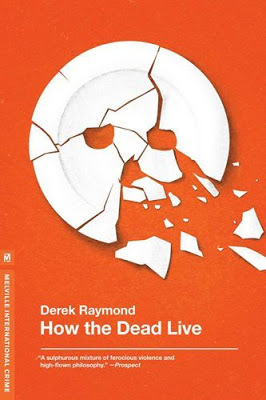
First published by Secker and Warburg in 1986 as Book 3 in the Factory series, but repackaged here, this is a suitably oblique cover for a rather oblique novel. Philosophy and violence entwine as an unnamed but very hard-boiled detective sergeant investigates a disappearance from a scenic English village which, in truth, is rotten to the core ...
12. THE TALENTED MR. RIPLEY - Patricia Highsmith (WW Norton, 2008)
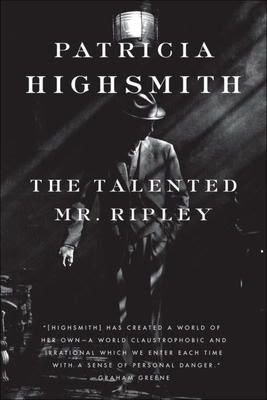
Known by many for the 1999 movie version starring Matt Damon, this classic 1955 psychological thriller still stands the test of time, hence the above re-issue and its rather marvellous new cover. Originally published by Coward-McCann, it tells the tale of a young conman who murders a rich playboy, assumes his identity and settles back to enjoy the good life. Except it can’t be that easy ...
13. THE FRIENDS OF EDDIE COYLE - George V Higgins (Picador, 2010)
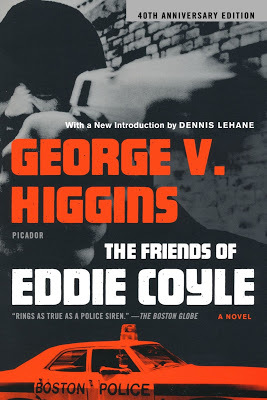
A ‘says it all’ jacket for the 40th Anniversary edition of this underworld masterpiece. Originally published in 1972, it tells the distinctly non-glamorous tale of a small-time gunrunner working for the Irish mob, who, to save his own skin, turns informer for Boston law-enforcement, making himself plenty of deadly enemies in the process ...
14. THE BONE KEEPER - Luca Veste (Simon & Schuster, 2018)

A sneak peek of what is likely to be one of next year’s big releases. Luca Veste steps away from his Murphy and Rossi crime series to produce a stand-alone nightmare (the horror elements of which are clearly signalled by the image above) in which Liverpool cops gather gory evidence suggesting that semi-mythical bogeyman, the Bone Keeper, might actually be real ...
15. THE DEVIL - Ken Bruen (Minotaur, 2010)
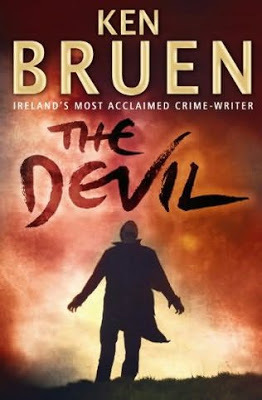
A suitably infernal cover for no. 8 in the Jack Taylor series. For the uninitiated, anti-hero Taylor, a hard-drinking, self-loathing mess of an Irish PI, finally meets his ultimate nemesis when his investigation following a crazed killing leads him into conflict with an enemy who may be the Dark One himself ...
16. THE ASHES OF LONDON - Andrew Taylor(HarperCollins, 2017)
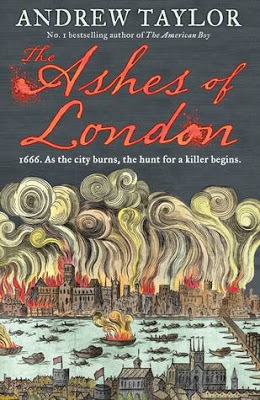
As a history buff, this is one of the best covers I’ve ever seen. For the very first time, Scotland Yard - in this case a propaganda office in the Palace of Whitehall - is called on to investigate a chilling ritual murder. The main problem though, is that it’s 1666, and London is burning to the ground. A classic mystery, set against a backdrop of sedition, sectarianism and simmering revolutionary fervour ...
17. MISSING - Sam Hawken(Serpent’s Tail, 2014)
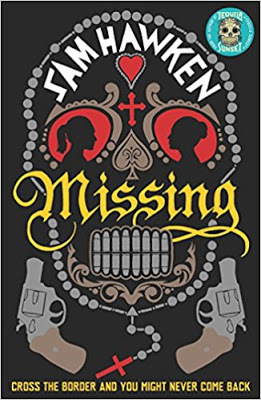
You want Satanic levels of evil, don’t read books about the Devil, check out the Mexican cartels. The voodoo-esque cover here, richly redolent of gang violence, pseudo-religion and nihilistic horror, makes a perfect jacket for this amazing effort by the author featured in today’s ‘Thrillers, Chillers’. A Texan searches for his wayward stepdaughters when they go missing over the border. Utterly grim ..
18. VILLAIN - Shuichi Yoshida
(Pantheon, 2010)
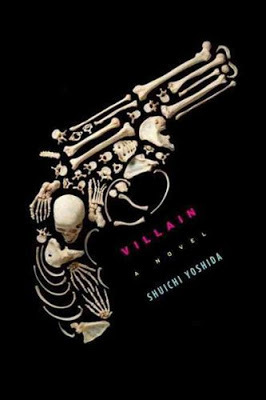
Great metaphorical image for a book that I, personally, would have had no idea how to illustrate. When a young saleswoman is murdered, an entire town comes under scrutiny - and is found lacking on almost every level. An Asian Noir by a very acclaimed Japanese writer, but at the same time, a ‘no prisoners’ slice of penetrating social commentary ...
19. THE HOLLOW MAN - John Dickson Carr (Hamish Hamilton, 1935)
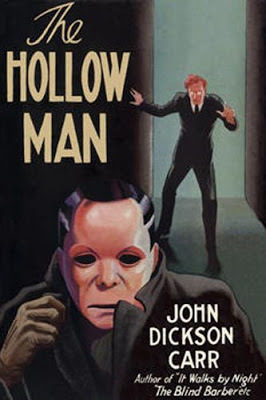
If this one doesn’t make you buy the book, we might as well all go home, but I shall try to encourge you anyway. Carr, known as one of the greatest suspense authors of his generation, presents us with a bamboozling conundrum, which, even now, is regarded as so clever a ‘locked room’ mystery that it is widely seen, even in the 21st century, as a textbook for crime writers ...
20. A DANCE AT THE SLAUGHTERHOUSE - Lawrence Block
(William Morrow, 1991)
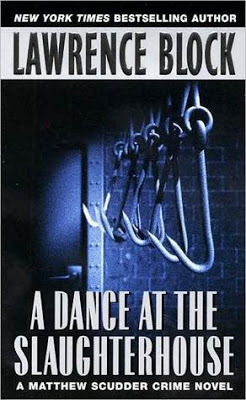
If this image makes you think that whatever the outcome of this novel, it ain’t going to be an easy ride ... well, you’ve guessed it. Another outing for Matt Scudder, Block’s tired but morally upright NYPD-turned-PI, who here investigates the murder of a depraved rich man’s wife, a case that takes him on a warts-and-all tour of the Big Apple’s sex-for-sale underground. Strong stomachs required ...
21. MURDER AS A FINE ART - David Morrell(Mulholland, 2013)
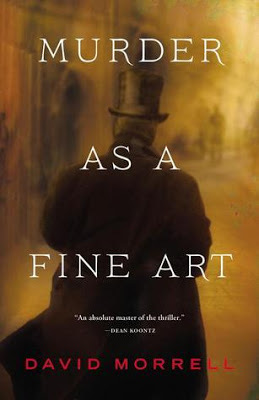
Top hats, gaslights and ghoulish slayings in Victorian London. That’s what you expect with a cover like this, and yes ... that’s exactly what you get. David Morrell takes us convincingly back to the mid-Dickensian era in this first Thomas de Quincey novel, evoking the horror of the true life Ratcliffe Highway Murders with a series of fictional copycat crimes decades later. Totally immersive mystery.
22. RUPTURE - Ragnar Jonasson(Orenda, 2017)
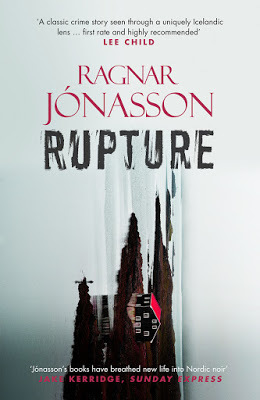
Another slice of Icelandic Noir from an author who is rapidly becoming the master of that form. Every box is ticked: a bleak world, a small, isolated community, a long-ago mystery which has never been resolved, a current crime spree echoing it, lots of unspoken secrets and a growing terrible threat that may render all of this redundant. It does exactly what it says on the tin ...
23. MURDERABILIA - Craig Robertson(Simon & Schuster, 2017)
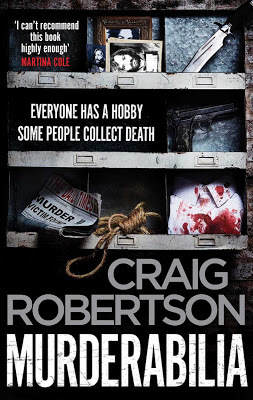
With his detective partner in bed, pregnant, Glasgow crime reporter Tony Winter (a Robertson regular) takes centre-stage when another horrible murder needs investigating. This time, though, the case touches on levels of darkness previously untapped, specifically the gruesome trade in crime memorabilia as perpetrated on the Deep Web. Yet again, the cover tells you all you need to know ...
24. GREEN RIVER RISING - Tim Willocks(Avon, 1994)
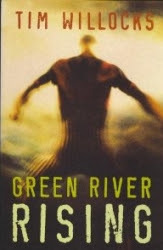
A fearful insider’s view of a terrifying prison riot, as engineered by a madman in one of the toughest jails Texas has to offer. Probably the most intense novel on this list, but very human too, the various maniacs given to us in full 3D rather than as evil cardboard cut-outs. (Not sure if this was the original hardback cover, or a later version. Perhaps some kind soul can enlighten me?) ...
25. RED HARVEST - Dashiell Hammett(Alfred Knopf, 1929)
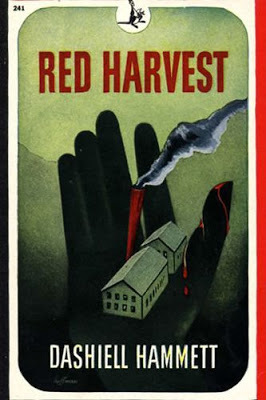
Hammett’s first crime novel, and still one of his best. The legendary ‘Continental Op’, a tough-as-teak private eye tackles the various goon squads who have taken charge of an industrial city on America’s West Coast. As hard-boiled as it gets, unstinting in the matters of murder, violence, drugs, alcohol, etc. But if this awsome period cover doesn’t draw you in, frankly, nothing will ...
*
THRILLERS, CHILLERS, SHOCKERS AND KILLERS
An ongoing series of reviews of dark fiction (crime, thriller and horror novels) – both old and new – that I have recently read and enjoyed. I’ll endeavour to keep the SPOILERS to a minimum; there will certainly be no given-away denouements or exposed twists-in-the-tail, but by the definition of the word ‘review’, I’m going to be talking about these books in more than just thumbnail detail, extolling the aspects that I particularly enjoyed … so I guess if you’d rather not know anything at all about these pieces of work in advance of reading them yourself, then these particular posts will not be your thing.
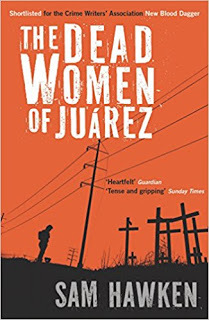 THE DEAD WOMEN OF JUAREZ
THE DEAD WOMEN OF JUAREZ by Sam Hawken (2012)
Ciudad Juárez is a Mexican border-town where something akin to a national disaster is being played out.
Since the early 1990s (in real life as well as in this powerful work of fiction), at least 5,000 young women, mostly prostitutes, students or assembly line employees in the maquiladoras – US-owned car-making plants where sweatshop conditions are the norm – have vanished. In many cases they have never been seen again, but a significant number have reappeared in shallow graves or on city dumps, murdered and displaying signs of extreme sexual torture.
Whether it’s the work of a serial killer, or multiple serial killers, or dope gangs, or sex tourists, or who knows what, it’s a hideous mystery which endures right to this day.
It’s difficult to understand how something like this can go on unchecked in the 21st century, but Juárez is a town with all kinds of problems, not least the cartels who fight each other daily up and down its bullet-scarred streets, the persistence of corruption in institutions like the police and local government, the prevalence of drugs and drug addicts, and the hordes of reckless American turistas who flood across the border every evening to drink and whore themselves senseless.
It is against this tragic but hellish backdrop that Texas author, Sam Hawken, tells his tale of two deeply-flawed men: Kelly Courter, an American boxer now long past his best, and Detective Rafael Sevilla, an alcoholic narcotics cop who is close to retirement after a career (and a lifetime!) during which he feels he’s achieved nothing.
Courter and Sevilla are as unlikely a pair of heroes as you could meet.
The former fled the States to evade a likely lengthy jail sentence, and now has a heroin dependency, which, though he’s only in his 30s, long ago ruined his boxing career. These days, just to be able to support himself (and buy smack!), Courter rents himself out as a human punchbag to unscrupulous backstreet boxing promoters like the verminous Ortiz – who put him in the ring against eager up-and-comers, where he suffers the unbridled hatred of the crowd and takes some bone-crunching beatings. The one light in his life is Paloma, his girlfriend, a fearless activist with Mujeres Sin Voces, a self-help organisation seeking justice for the legions of murdered women, and whose drugs-dealing brother, Estéban, he occasionally helps by providing a white face by which to lure nervous American customers.
It is through this connection that we first meet the honest but drink-enfeebled cop, Sevilla, who is constantly leaning on Courter to get him to give up his and Estéban’s supplier. Courter resists, of course, and there isn’t much Sevilla can do about that, or even is motivated to do, if he’s honest – because his life too has been irreparably damaged by the plague of ‘feminicide’, which, among so many others, has claimed both his daughter and his granddaughter.
As such, neither Courter nor Sevilla, nor even Estéban lead happy and fulfilled lives, but things get a whole lot worse when Paloma, who on several occasions has stood up to the menacing gangland figures constantly circling Mujeres Sin Voces, also disappears. If this isn’t enough, as neither Courter nor Estéban have adequate alibis – Courter was on yet another drugs binge at the time! – they are taken into custody as suspects by the monstrously violent Captain ‘La Bestia’ Garcia, who, while he’s pretty incompetent when it comes to collaring gangsters and sex-murderers, likes nothing better than to brutalise confessions out of the little fish who drop his way.
Even Sevilla, who by now has developed a reasonably amicable relationship with Courter, can do nothing to help. When he turns to Adriana Quintero, the almost impossibly well-groomed prosecutor attached to the Special Task Force for the Investigation of Crimes Against Women, and pleads Courter’s innocence, he is greeted with utter indifference; Quintero’s real job, it seems, is to make it look as if Juárez is being served by the law.
Sevilla realises that only one route is open to him. Somehow or other, he must do the unfeasible, and bring the real perpetrators of the Juárez ‘feminicides’ to justice …
The first thing that struck me about The Dead Women of Juárez , Sam Hawken’s debut novel, is that it isn’t your typical crime-thriller. I’ve seen it described variously as ‘hard-boiled’, as ‘a border noir’, as ‘a classic murder-mystery’, and while there are aspects of all those in there – hard-drinking detective, Sevilla, and battered boxer, Courter, wouldn’t be out of place in any Chandler or Mickey Spillane – the overwhelming catastrophe that is actually occurring in Juárez basically takes centre-stage.
And that’s the main point. Because this relentless spate of unsolved murders is a real thing, and because the real city in which the novel takes place is every bit as dusty and down-at-heel as Sam Hawken describes it here, it would seem indelicate, if not downright trite, to classify this novel as anything resembling pulp fiction. It’s a rattling good story – there’s no question about that, and Hawken’s lean, mean prose keeps it bouncing along at pace. But the whole narrative aches with a deep-felt sadness, which can only stem from the real life horrors of that woe-begotten burg.
And it’s quite clear that Hawken wrote his book fully mindful of this issue.
His approach is observational rather than judgemental. Whether it be the extreme inequality of wealth on display here (some folk living in ‘cartons’, while super-powered businessmen like Rafa Madrigal, and his vile son, Sebastian, own ranches and private golf courses), the rash crowds of American kids who flock across the border to party and get high, or the armies of dealers, hookers and hustlers who cater to them, he simply describes things the way they are, rather than calling down fire and brimstone on it. Even the ongoing murder spree is brought to us subtly, Hawken not sitting us down to lecture us, but gradually drawing it to our attention via the clusters of wooden crosses we see standing on wasteland now and then, or the flyblown ‘missing’ posters adorning streetlights and telegraph poles.
This, he shows us – without really needing to say it – is the tragedy of modern Mexico.
Poverty and crime are the norm. Murder is so common that people are no longer shocked; they simply live their lives around it, getting on any way they can. Even Mexico’s crime-lords and their roaming gangs of gunmen are regarded as an everyday occupational hazard.
But while that’s the way of normality in Ciudad Juárez, for the rest of us it’s seismically terrifying. You find yourself shuddering more with each page turned, appalled that such injustice and exploitation could ever exist in the modern world. The desolation of all the main characters’ lives is palpable. It extends to the lesser characters too: the scores of bereaved parents and siblings protesting futilely on barren street-corners; the dead-eyed workers trudging in for yet another long shift in hot, dirty factories; those people who live in cartons.
In all these respects, The Dead Women of Juárez is an unforgettable read. It is dispiriting and distressing – just when you think one awful thing too many has happened, another, even worse thing comes along. The violence and cruelty is more visceral and in-your-face than almost any reader could be comfortable with. However, none of this means that there isn’t going to be a reckoning of sorts. It certainly doesn’t mean that Rafael Sevilla, finally galvanised to take a long-overdue revenge on the enemies of his town, won’t get his act together.
To say more on that would be a spoiler, but The Dead Women of Juárez isn’t just a warts-and-all study of modern-day despair; it’s a multi-layered, fast-moving piece of docu-fiction, superbly written and while not exactly entertaining, ultimately very, very satisfying. Okay, it may not be true to call this book a typical crime-thriller, but that certainly does not mean that it doesn’t reach a very thrilling conclusion.
Another one I highly recommend, though with the caveat that it’s more an existentialist nightmare than a murder mystery, and that even in that brutal guise, it pulls absolutely no punches.
And now, as usual, I’m going to be bold enough to try and cast this one in advance of it ever coming to the movie or TV screen. I’m not sure whether it’s been optioned or not, but hey … this is only an exercise. Like anyone would listen to me, anyway. Here are my picks for the leads:
Detective Rafael Sevilla – Antonio BanderasKelly Courter – Wentworth Miller (older than in the book, but he doesn’t look it)Ortiz – Sergi LopezEsteban – Pablo CruzPaloma – Angelique BoyerCaptain ‘La Bestia’ Garcia – Alberto EstrellaAdriana Quintero – Blanca SotoRafa Madrigal – Miguel SandovalSebastian Madrigal – Gael Garcia Bernal
Published on September 10, 2017 08:31
August 11, 2017
Unveiling the next Lucy Clayburn enquiry
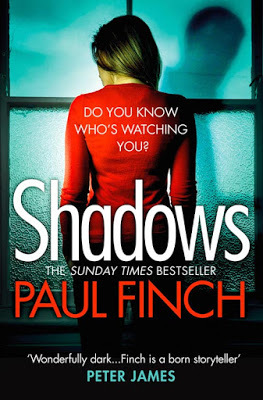 Okay, I know I’ve been promising his for a little while, but today I’m at last able to unveil the jacket for the next Lucy Clayburn novel, SHADOWS.
Okay, I know I’ve been promising his for a little while, but today I’m at last able to unveil the jacket for the next Lucy Clayburn novel, SHADOWS. So, here it is … enjoy (and feel free to tell me what you think).
We’ll be talking a bit more about the next Lucy book shortly (I’ll even let you in on seven things about her that you previously didn’t know). But as we’re focussing exclusively on girl-power this week, I’ll also be reviewing and discussing Tess Gerritsen’s remarkable occult/crime thriller, THE MEPHISTO CLUB, which pits two female sleuths against a group who are literally dedicated to doing evil. It’s a real hair-curler, but as always, you’ll find that review at the lower end of today’s post.
Meanwhile, as promised, Lucy is back on the crime-solving trail this autumn, so here’s that little bit extra I promised about the next adventure ...
In SHADOWS , PC Lucy Clayburn has finally earned herself a permanent position in the CID office of Greater Manchester Police’s notorious November Division (where just about every kind of social deprivation is still an issue, and where criminal activity is rampant).
Lucy, or DC Clayburn as she is now officially known, is already an 11-year veteran on the force, and she thinks she’s seen and done it all … until the arrival in town of a gang of armed robbers who hit their targets with maximum force and extreme savagery, always leaving trails of dead or horrifically wounded victims in their wake.
It’s a real shock to the police system, even in a rough neighbourhood like ‘the N’ - almost a throwback to the days of John Dillinger and Baby Face Nelson. But Lucy isn’t the only person on the case. As this new gang mainly seems to be preying on the interests of the underworld, in particular the Northwest’s premier crime syndicate, the Crew, infamous gangland trouble-shooter Frank McCracken is also charged with bringing them down. And you can be sure that his methods are going to be a lot rougher and readier than Lucy’s (even if the vying twosome do know each other better than either of them would like to admit).
Random violence
I first introduced Lucy Clayburn in the 2016 novel, STRANGERS , in which she went undercover as a Manchester prostitute in order to catch a deranged working girl who appeared to be butchering her male clients.
As well as sending her after a relentless serial killer, it brought her into closer contact with organised crime in the city than any person would be comfortable with.
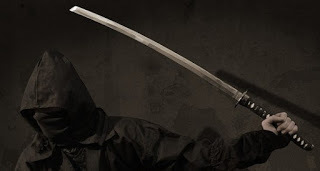 But in
SHADOWS
, she goes a whole lot deeper, pursuing a bunch of blaggers to whom human life means nothing, and plunging into a world of drugs, guns and random, testosterone-fuelled violence, where no-one – but no-one – is beyond the reach of a knife, a bullet, or even a sword!
But in
SHADOWS
, she goes a whole lot deeper, pursuing a bunch of blaggers to whom human life means nothing, and plunging into a world of drugs, guns and random, testosterone-fuelled violence, where no-one – but no-one – is beyond the reach of a knife, a bullet, or even a sword!But alas, I can’t say too much more about it. If you want to know what actually happens in SHADOWS , you’ve got to acquire the book – which will be published on October 19 this year.
However, also as promised earlier, here is one further item of interest for Lucy Clayburn fans ...
SEVEN THINGS ABOUT LUCY THAT YOU DIDN’T KNOW:
(These were all plotted before the first book was written, but didn’t make it into the final text. However, in due course, all will come to play their own part in the Lucy Clayburn canon).
1) At the start of STRANGERS , all Lucy thought she knew about her absent father was that he’d worked as a bus driver, and that he had departed the family before Lucy was even born because he found the idea of parental responsibility onerous. As a young child, Lucy was particularly affected by this, and at the age of seven she ran away from home and used her Christmas money to travel the bus routes of Greater Manchester for two days, looking for any driver whose facial features she might vaguely recognise. Lucy’s mother, Cora, was beside herself with worry, but the child was later recovered safe and well when, early one morning, a nurse coming off duty found her sleeping in a bus shelter in Rochdale on the other side of the city from her home-patch of Crowley. Afterwards, when Lucy saw how upset her mother had been, she solemnly promised herself that she would never go looking for her father again.
2) Those who’ve read STRANGERS will be aware that Lucy comes from an economically poor background but that her single mother’s brave and determined efforts ensured that she’d eventually become a model citizen. However, in her late teens, Lucy went through a typical ‘wild child’ phase, and for a brief time was girlfriend to Kyle Armstrong, a member of the Low Riders, Crowley’s resident Hell’s Angels chapter.
 Armstrong later rose to be president of the chapter, but when Lucy joined the police – perhaps inevitably – they went their separate ways, and not very amicably. However, Armstrong made an impression on Lucy; she still recalls how lean, mean and fanciable he was, and of course, though she may not admit this to herself, she owes Armstrong big-time for instilling in her a long-lasting street wisdom, not to mention her abiding love of motorbikes (for those not in the know, Lucy still rides a Ducti Monster M900 ‘muscle-bike’).
Armstrong later rose to be president of the chapter, but when Lucy joined the police – perhaps inevitably – they went their separate ways, and not very amicably. However, Armstrong made an impression on Lucy; she still recalls how lean, mean and fanciable he was, and of course, though she may not admit this to herself, she owes Armstrong big-time for instilling in her a long-lasting street wisdom, not to mention her abiding love of motorbikes (for those not in the know, Lucy still rides a Ducti Monster M900 ‘muscle-bike’).3) As a child and then as a teenager, Lucy had an extreme phobia of dogs. It all began when, as a toddler, she was playing in the backstreet behind her house when she was attacked and badly bitten by an out-of-control Doberman. For years afterwards, she had an unreasoning fear of canines. However, this was cured one Saturday night in the police, when she was required to arrest two hooligans who were fighting outside a kebab shop.
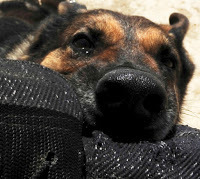 Lucy was alone at the time, and the moment she grabbed the guy doing most of the beating, the watching crowd turned on her, as did the other combatant. Lucy was about to get a severe kicking herself, when Shuck, a fearsome police dog was let loose further down the road. It tore into the mob and drove them every which way, basically saving her life. Later, she made friends with Shuck by throwing a tennis ball for him for two hours on the car park at the back of the police station, throwing off her phobia in the process.
Lucy was alone at the time, and the moment she grabbed the guy doing most of the beating, the watching crowd turned on her, as did the other combatant. Lucy was about to get a severe kicking herself, when Shuck, a fearsome police dog was let loose further down the road. It tore into the mob and drove them every which way, basically saving her life. Later, she made friends with Shuck by throwing a tennis ball for him for two hours on the car park at the back of the police station, throwing off her phobia in the process.4) Lucy first came to the notice of senior police officers when, early in her career, shortly after leaving the watchful eye of her tutor constable, she engaged in a car chase with a late-night driver who wouldn’t stop for her. Suspecting because of his erratic driving that he was drunk, she stayed on his tail until he abandoned his vehicle on wasteland close to the River Irwell. It was a December night, very cold and the river was half frozen. The fleeing driver attempted to swim across, got into trouble and screamed for help as he started to drown.
 Despite the pitch darkness and the icy cold, Lucy jumped into the river and managed to pull him ashore alive (he transpired to have been under the influence of drugs). Later on, she was severely reprimanded by her supervisors for taking an absurdly dangerous risk. However, when the Chief Constable of Greater Manchester heard about the escapade, she was awarded her first (of several) commendations.
Despite the pitch darkness and the icy cold, Lucy jumped into the river and managed to pull him ashore alive (he transpired to have been under the influence of drugs). Later on, she was severely reprimanded by her supervisors for taking an absurdly dangerous risk. However, when the Chief Constable of Greater Manchester heard about the escapade, she was awarded her first (of several) commendations. 5) Lucy suffered her first serious injury on duty when she was hit with a baseball bat by one of her own police colleagues. She was involved in public order training at the time, and participating in an exercise called ‘Violent Man’. A burly police PTI had donned body armour and a motorcycle helmet and, armed with a hickory slugger, was stationed inside a derelict house. Lucy and three other PCs had to enter and affect an arrest; the PTI, in the guise of a deranged suspect, had to do everything he could to resist them. Though Lucy and her crew were in full riot gear and armed with heavy Perspex shields, the house was filled with rubble. Lucy stumbled on entry, dropped her shield, and the PTI, who’d already taken a full swing at her with the bat, was unable to pull back. Lucy was hit in the throat, the impact of which broke her collar bone and caused her to swallow her tongue. Revived at the scene, she nevertheless had to spend two days in hospital and was off work for three weeks.
 6) Lucy once nearly arrested a famous rock star. In her mid-twenties, she was off-duty in a central Manchester nightclub when a rather dishy but very drunken guy began pestering her for a dance.
6) Lucy once nearly arrested a famous rock star. In her mid-twenties, she was off-duty in a central Manchester nightclub when a rather dishy but very drunken guy began pestering her for a dance.The guy wouldn’t take no for an answer; in fact he seemed startled that she would resist him. At length, Lucy lost her patience and gave him a flea in his ear. His response was to turn aggressive and, when he tried to force a kiss on her, she put him in an arm-lock and marched him to the nightclub door, where she intended to get the bouncers to summon police officers to take him into custody. Someone then quietly advised her that she was roughing up Tug Davis, founder member of The Mannequins, a big name Manchester band of the 1990s and one of the Britpop ‘big five’. Lucy still wasn’t inclined to let him go, even less so when a bossy woman identified herself as Tug’s PA and threatened legal action.
However, when a colleague pointed out to Lucy that she’d had a bit to drink herself and that she might be on shaky ground, she finally relented and all parties agreed to forget it so long as Tug “behaved himself in future”, which he sulkily promised to do.
7) Lucy once made the Crowley newspapers after taking an eccentric local woman seriously rather than dismissing her as a fruitcake. Annie Leary was regarded by the police as a batty old dear, whom no-one should pay any attention to, especially when she made repeated complaints that her terraced house was haunted by a goblin, who constantly stole her money and food. When Lucy was assigned to that beat, she took note of the fact that the house next door to Annie’s was empty, and launched a one-woman investigation, which led her to a hole in the connecting wall between the two attics. It turned out that a homeless child – a feral boy – was living up there, who regularly came down into Annie’s house at night to try and feed himself.
THRILLERS, CHILLERS, SHOCKERS AND KILLERS …
An ongoing series of reviews of dark fiction (crime, thriller and horror novels) – both old and new – that I have recently read and enjoyed. I’ll endeavour to keep the SPOILERS to a minimum; there will certainly be no given-away denouements or exposed twists-in-the-tail, but by the definition of the word ‘review’, I’m going to be talking about these books in more than just thumbnail detail, extolling the aspects that I particularly enjoyed … so I guess if you’d rather not know anything at all about these pieces of work in advance of reading them yourself, then these particular posts will not be your thing.
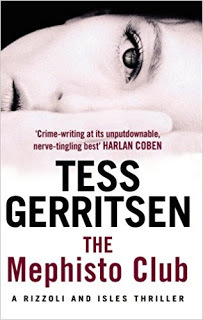 THE MEPHISTO CLUB
THE MEPHISTO CLUB
by Tess Gerritsen (2006)
As usual, on/off partners in crime-fighting, Detective Jane Rizzoli and medical examiner, Doctor Maura Isles, are having difficulties in their personal lives.
At the start of The Mephisto Club , Isles’s yearning for handsome Catholic priest, Father Daniel Brophy, remains unrequited, but as he is equally attracted to her, how long that status will last is anyone’s guess. Meanwhile Jane Rizzoli, an experienced homicide investigator with the Boston PD, has a happily-married life, but a car-wreck of a family, her brothers useless and her mom and dad increasingly quarrelsome with each other.
With all this going on, and in the depths of a bitterly cold Boston winter, it’s hardly the right time for the twosome to find themselves confronted by a particularly ghoulish ritual murder, the body horribly dismembered and the Latin word PECCAVI scrawled at the scene.
An apparent explanation suggests itself soon enough, the slaying seemingly linked to one of Isles’s former sparring partners, criminal psychologist, Dr Joyce O’Donnell, a woman with whom she has never seen eye-to-eye. It seems possible that the perp is one of O’Donnell’s more disturbed patients, either trying to spook her or leave her some kind of message. But O’Donnell can’t (or won’t) help examine this particular theory, and then more murders follow, with similar mutilations and similar cryptic characters inscribed on and around the corpses.
It seems that it isn’t just Joyce O’Donnell who’s the object of interest, but the whole of the mysterious Mephisto Club, of which she is only one member.
A group of scholarly individuals headed up by the wealthy ex-college professor, Anthony Sansone, and the bullish Englishwoman, Edwina Felway, the Mephisto Club – or ‘Mephisto Foundation’, to use their preferred title – dedicate themselves to a profound and scientific analysis of evil; not just in its obvious form, as in the violent psychosis displayed by damaged individuals, but also the religious and metaphysical elements of it, i.e. its devilish origins, as described in the earliest archaeological records.
To the ever-cynical Rizzoli, all of this feels like hokum, but she’s frustrated to find that, owing to their fantastical wealth, the Mephisto Club exert huge influence over the authorities, even the FBI, and when they insist on helping with the investigation, tacit permission is given.
They don’t exactly interfere, but Rizzoli soon feels that she’s lost her leadership role, and is particularly frustrated by Isles, who is gradually won over by them, especially by Sansone, a descendent of cruel Italian nobility, and yet a man whose good looks are striking, and whose urbane style and intellectual depths make him a real force to be reckoned with.
In a parallel thread, meanwhile, we follow the fortunes of one Lily Saul, a girl whose family, many years ago, had the misfortune to take into their care her abandoned cousin, Dominic. Dominic was a curious boy with peculiar interests, an unnerving manner and a strange knowledge of ‘forbidden’ things.
We don’t dwell too much on that first summer of young Dominic’s residence at the Saul home in rural New England, but instead flit forward in time to find Lily, now an adult (with no family left to call her own!), on the run in Rome, leading a hippie-like existence, moving from one temporary accommodation to the next, doing things she would never normally have dreamt of in order to make money, and constantly looking over her shoulder for fear that he – or should that be ‘it’ – won’t be far behind …
Tess Gerritsen’s blood-spattered crime thrillers have often been said to skate along the edge of the horror genre, and while that may not always be true, I don’t think it can be denied on this occasion. But that’s not because The Mephisto Club is a gore-fest. To start with, it’s not. Oh, there are gruesome murders a-plenty, and the author/doctor, as always, demonstrates her medical knowledge with some unstintingly detailed autopsy sequences, but the real horror in this novel – and the title itself is a bit of a give-away – actually comes to us from a more much traditional direction: its aura of Satanic evil.
The surprising implication in The Mephisto Club , namely that a truly malevolent force walks the Earth, an ancient power traceable right back to the Fall of Man, is not the kind of twist we’d expect in a routine crime thriller, but in this novel we get it full-on.
Lily’s flight to Rome serves to underline this almost in itself; Italy, the land of esoteric antiquity, Rome the capital of the Catholic Church.
And then there is the Mephisto Club itself.
For the uninitiated, Mephisto (better known as Mephistopheles) was an arch-demon, a close servant of Satan, who most famously claimed the soul of 15th century occultist, Faust. So once again in this novel we’re working on the basis that evil is not some intangible aspect of corrupted human nature, but a personalised entity, something with a form and a face, which actively seeks the destruction of our world.
The Club, itself, is equally reminiscent of the classic age of horror.
It’s an amusingly old-fashioned concept, consisting entirely of enigmatic scholars and wealthy intellectuals, who spend their time tracing the movements of the world’s most malign beings, attempting to track their ancestry back to mythological days when fallen angels known as the Watchers spawned monstrous offspring, the so-called Nephilim, who dedicated their existence to the death and misery of mankind. Their tireless research has uncovered all manner of eldritch information: references not just to the Watchers and the Nephilim, but to the Book of Enoch (which is real and in which many of these disturbing legends were first written down) and to Lillith – Adam’s first wife, a wanton temptress who walked the Earth long before Eve (and who modern-day feminists regard as the quintessential demonization of women by a patriarchal church).
With all this in mind, it’s very easy to picture the Mephisto Club in a Hammer Horror movie, perhaps with Peter Cushing chairing the meetings.
The big question is … does it work in the context of a crime thriller?
My view – and I’m aware that it’s not shared by all crime fans – is that it does.
Okay, I will admit to having one or two minor problems with it. I didn’t buy totally into the idea that the Mephisto Club, even through the combined expertise of its members, could wield such influence over government organisations like the FBI. I’m sure these secret societies exist, but I’d imagine more as hobbies for the rich and the bored, whom the police would simply treat as well-meaning amateurs. I also thought that one or two moments were a little bit rushed; for example, after effectively and atmospherically building up the circumstances of Lily’s flight to Rome, not to mention the fear she feels at every turn, and the desperate (ugly-desperate at one point!) measures she takes to protect herself there, this whole part of the book seems to end rather mundanely and abruptly, within a page or so in fact. Compare and contrast that to the protracted and ultimately irrelevant break-up of Rizzoli’s parents’ marriage, and you have a quite noticeable imbalance.
But hell, I’m not going to pretend that I didn’t thoroughly enjoy this novel.
Whether I’m reading crime or horror, I’m a sucker for ancient puzzles, and The Mephisto Club is riddled with them. From eerie Latin inscriptions to ritually mutilated corpses, from chalk symbols to assailants who move like shadows, this narrative is chocka with arcane symbolism and olde worlde weirdness. It’s also pretty damn thrilling: Rizzoli and Isles, two independent, modern-minded women, talented practitioners of their respective crafts and domineering forces in their personal lives, find themselves eyebrow-deep in a gory and distressing murder case for which no contemporary textbook could have prepared them.
For all these reasons, The Mephisto Club is a fast, riveting read. But then you have Tess Gerritsen’s skilled penmanship, as well – a great sense of time and place (Boston in mid-winter, brrr), fizzling dialogue, rapid-fire action, a range of extreme and even grotesque characters for us to get our teeth into, though none of them are OTT – and you’ve got everything you really need for an enjoyable thriller.
I can understand why certain crime fiction traditionalists found this one hard to take. The concept of evil as a sentient force, embodied by a single devilish being, or even a group of such beings, may on one hand seem naïve of the author, but on the other hand you’ve got to remember that this is fiction, and fun fiction at that. And it’s not as if the supernatural elements hit us on the nose. Like most good authors in this field, Gerritsen basically leaves it open at the end, leaves certain questions unanswered, and leaves her readers – this one at least – wanting more.
An intriguing thriller with an unusual, challenging and never less than uber-dark premise, The Mephisto Club ticked all of my boxes.
And now, the moment you’ve all been waiting for – when I cast this beast. Of course, in the case of Rizzoli and Isles, if their adventures were to be adapted in the correct order, The Mephisto Club would be the fourth in the series, but just suspend belief for a minute or two (which you’ll need to do anyway, if you want to get your head round the idea that someone like me will be picking the actors):
Det. Jane Rizzoli – Jaimie AlexanderDr. Maura Isles – Julia StilesLily Saul – Emma StoneAnthony Sansone – Mads MikkelsonDr. Joyce O’Donnell – Glenne HeadlyEdwina Felway – Emma Thompson
Published on August 11, 2017 04:04
August 6, 2017
Darker days: the 60s/70s maniac explosion
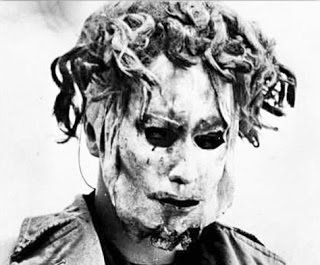 We’re lowering the tone to a dangerous level this week, conjuring up memories of a past so dark that many among us who were there at the time have likely blotted them out. We’re going to be recollecting the 1960s and 1970s, and exposing ourselves to some of Britain’s worst real-life criminals and the terrible atrocities they inflicted on us during that turbulent, rough-and-ready age.
We’re lowering the tone to a dangerous level this week, conjuring up memories of a past so dark that many among us who were there at the time have likely blotted them out. We’re going to be recollecting the 1960s and 1970s, and exposing ourselves to some of Britain’s worst real-life criminals and the terrible atrocities they inflicted on us during that turbulent, rough-and-ready age.
In the same spirit, I’ll today be reviewing and discussing BLOOD AXE, Leigh Russell’s unrelenting tale of a criminal gone mad on the streets of urban Britain, and the cop who investigates the case so hard that he sacrifices almost everything he has in the process. As usual, you’ll find that review and discussion towards the lower end of today’s blog.
 Before any of that, I can announce that next week we’ll officially be revealing the cover to my next Lucy Clayburn novel,
SHADOWS
, which hits the shelves on October 19 this year and puts our feisty female cop on the trail of a ruthless gang of armed robbers who always hit their targets with maximum brutality and bloodshed.
Before any of that, I can announce that next week we’ll officially be revealing the cover to my next Lucy Clayburn novel,
SHADOWS
, which hits the shelves on October 19 this year and puts our feisty female cop on the trail of a ruthless gang of armed robbers who always hit their targets with maximum brutality and bloodshed.In sync with today’s overarching theme of narcissistic violence in a world devoid of pity, Lucy soon learns that the most frightening thing about opponents this extreme is not their preparedness to kill, but the void where their humanity is supposed to be, the utter absence of any degree of human love or charity.
Which brings us smoothly onto today’s main feature. An article I’ve put together this last week or so, much of it from memory, on the subject of a strange, anarchic age which, by the time it arrived, had seen so many sacred cows cruelly slain that it was inevitable human victims would start to follow.
All you have to do, if you’re old enough, is throw your mind back 30/40 years, to …
DAYS OF INDELIBLE DARKNESS
If you grew up in the UK of the 1960s and 1970s, as I did, you experienced a world that would be completely unrecognisable to young people today.
Okay … we’ve all heard the usual criticisms about that long-ago (and much defamed) era. Namely, that as a nation we drank too much, smoked too much, ate the wrong things, that we were innately racist, and that, most unforgivably of all in modern eyes, our society as a whole was self-indulgently sexualised: our book covers had never been more lurid, girlie mags were not just confined to the top shelves, our cinemas showed nothing but porn, and blue comedians dominated our TV schedules – I even remember one amazing Saturday morning when the lovely Sally James presented the kids’ show, TISWAS, naked in a bubble bath!!!
Not all of us might consider that latter detail a problem, but there actually was a downside to living in that period. The counter-culture rebels of the mid-60s had ushered in an age of permissiveness, which for some opportunists quickly morphed into something much more unpleasant: a time of misogyny and exploitation. It brought us increased drugs problems too, and quite a bit more ‘angry young man’ violence – and not just on stage and screen; the 60s saw countless Bank Holidays disrupted by mods v rockers incidents, while in the 70s, winter weekends were repeatedly marred by widespread football hooliganism.
But it wasn’t all bad for us youngsters, especially if we liked the fictional scary stuff.
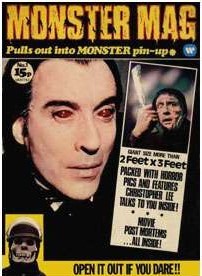 Unlike today, tales of horror and the supernatural were easily accessible through mid-evening network television shows like THRILLER, BEASTS and SUPERNATURAL, not to mention cheaply-priced paperbacks, which we could afford with our pocket-money and which would be sold to us by cheerful shop-ladies who’d never ask us our age (okay, I’ll admit it, you might have got smacked if your dad found you in possession of some gore-filled movie magazine like MONSTER MAG, or an issue of the uber-violent comic, ACTION, or maybe if he discovered a volume of the PAN BOOK OF HORROR STORIES next to your bed … but you got smacked an awful lot in those days anyway, so it seemed like a price worth paying).
Unlike today, tales of horror and the supernatural were easily accessible through mid-evening network television shows like THRILLER, BEASTS and SUPERNATURAL, not to mention cheaply-priced paperbacks, which we could afford with our pocket-money and which would be sold to us by cheerful shop-ladies who’d never ask us our age (okay, I’ll admit it, you might have got smacked if your dad found you in possession of some gore-filled movie magazine like MONSTER MAG, or an issue of the uber-violent comic, ACTION, or maybe if he discovered a volume of the PAN BOOK OF HORROR STORIES next to your bed … but you got smacked an awful lot in those days anyway, so it seemed like a price worth paying).No, it wasn’t too bad if you were a kid back then, so long as you were also a horror freak.
Unless, of course, you considered CRIME a problem … because that is the point at which 60s/70 horror stories stop being funny.
A new age of violence
It would be completely wrong to claim that violent and sexual crimes were inventions of the late 20th century. We all know that we can trace our gangsters, rapists and serial killers back to the dawn of civilisation. But in the 60s and 70s – or so it seemed to me – it was almost as if the entire criminal underworld had suddenly taken its gloves of. Maybe it was just that my generation were finally becoming old enough to pay attention to the news, but suddenly vicious murders appeared to be happening everywhere, often set against dismal urban backdrops, and perpetrated by offenders who were more ruthless, crazed and sadistic than any of those who had gone before them.
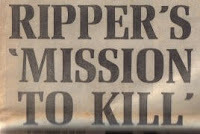 And they were dealt with starkly by the media, newspapers and TV bulletins delivering the full stories to us in the most unstinting fashion, sparing us no cruel or gruesome detail.
And they were dealt with starkly by the media, newspapers and TV bulletins delivering the full stories to us in the most unstinting fashion, sparing us no cruel or gruesome detail.And, on reflection … why wouldn’t they?

In an age when the body-counts on DR WHO often matched those on war films, at a time when Bonfire Night was preceded by safety warnings on early-evening TV displaying graphic images of burned children (check out the kid on the right ... who was able to stare at the sunset because he had no eyes!), in an era when it was all too easy for 12-year-olds to sneak in through the unalarmed back doors of local cinemas to catch movies like CLOCKWORK ORANGE, SOLDIER BLUE, STRAW DOGSand THE DEVILS (and again, only at the risk of getting a clip round the ear if caught), why would anyone think we youngsters couldn’t take it?
So … could we?, I hear you ask.
Yeah, course we could. If anything, it made us streetwise, woke us up to stranger-danger, and informed us in no uncertain terms that childhood was over.
And yet now, even having become a thriller writer in my adult years, I still have indelible and sometimes vaguely disturbing memories of the crime in that period: the photofits on the evening news (they never looked even remotely human, which made them all the scarier); the column-inches of darkly luscious prose describing the streets of fear in depressed towns where killers were on the loose; the newsreels showing search-lines moving morosely across desolate wastelands; and then, when these maniacs were finally caught, the grainy footage of their humped and handcuffed forms with blankets thrown over them as they were led by harassed-looking coppers through the baying mobs gathered outside police stations or courts.
Death by hanging was abolished for murder in Britain in 1965, but adults at the time remembered it well enough and many regretted its loss, an opinion that was often expressed loudly when these crime sprees were in progress.
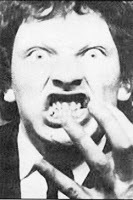
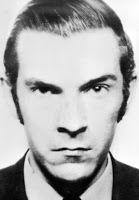 And almost invariably, the faces of the guilty, when they finally appeared in the press, looked as if they belonged on the gallows (check out mass killers Graham Young, left, and Patrick Mackay, right). I don’t think there was ever an era in British history when criminals looked as much the part as they did in the 1960s and 1970s.
And almost invariably, the faces of the guilty, when they finally appeared in the press, looked as if they belonged on the gallows (check out mass killers Graham Young, left, and Patrick Mackay, right). I don’t think there was ever an era in British history when criminals looked as much the part as they did in the 1960s and 1970s.But enough of my inane rambling.
To really try and capture the atmosphere of that sleazy time, and the edginess of those streets we all romped through with the backsides hanging out of our jeans, only scattering back home when darkness fell (or not, depending on how fearless we thought we were!), the toughness of the cops (who had very hard hands, trust me!), and the desperate, pre-DNA war they waged against a new age of unspeakable deviancy, here, in no particular order, I’ve selected my 15 Most Shudder-Inducing Memories of 60s and 70s Crime:
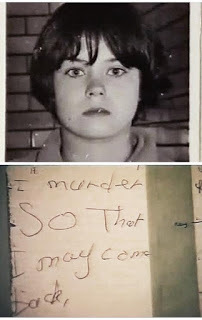 Mary Bell
Mary BellIn an era when children were still held to be innately innocent, the crimes of Mary Bell completely stunned a British society which, by 1968, really thought it had seen it all.
An unknown assailant making random fatal attacks on young children is a crime investigator’s worst nightmare, but when the killer is also a child, it becomes the stuff of nightmares.
Mary Bell, the daughter of a Newcastle prostitute, was only 10 in May 1968, when she lured a neighbouring boy who was only four years old, into a derelict house and strangled him. A short time later, she vandalised a local nursery and left sinister messages claiming responsibility for the murder (above left). The following July, this time with an accomplice, she attacked and strangled another neighbouring child, a little boy who was only three years old – in this latter case, Bell is believed to have returned to the scene of the crime afterwards, to inscribe a letter M on the victim’s body with a pair of scissors, and to mutilate his genitals.
Thanks to the unbridled horror of the case, even though she was only convicted on two counts of manslaughter (on the grounds that she was mentally ill), she was ordered to be detained indefinitely. However, she was released around 1980, and ever since then has lived anonymously under the protection of the courts.
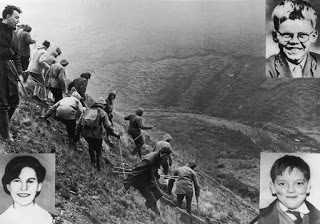 The Moors Murders
The Moors MurdersOne of the most distressing cases of all time, the Moors Murders occurred between 1963 and 1965 on the outskirts of Manchester, and are often seen as a watershed in the history of UK crime.
Ian Brady, a Glaswegian-born ex-juvenile delinquent, and Myra Hindley, a clerk at the Gorton company where he found work, murdered five children, two girls and three boys, aged between 10 and 17. Four of the victims were sexually murdered, at least one of their torturous deaths photographed and tape-recorded, and the corpses buried on lonely Saddleworth Moor.
Brady and Hindley’s reign of horror ended when they committed their fifth murder in front of an unwilling accomplice, who the next day told all. The devilish twosome were convicted in 1966, missing the death penalty by months only, but receiving full life sentences. Even then, the victims’ families’ pain wasn’t over, the narcissistic Hindley fighting hard to acquit herself.
The fact that a woman had participated in these acts, using her femininity to lure the victims, horrified the world. Little wonder the phrase ‘wicked beyond belief’ was coined in reference to the duo. Few cared when Hindley died in prison in 2002; even fewer cared that Brady lingered on until 2017.
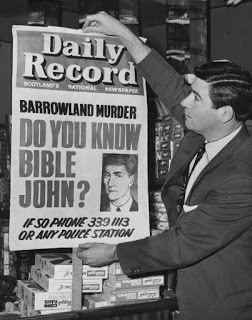 Bible John
Bible JohnOne of those true crime cases which ought to be the script for a horror movie.
A handsome man, clean-cut and well-groomed, introduces himself to young women at a famous old nightclub in the heart of town, using polite language and quoting the Bible to indicate that he is of God-fearing stock. And then, the next morning, those same young women are found in ruined buildings, raped, beaten and strangled with their own stockings.
To complete the terrifying picture, the culprit is never apprehended.
These ghastly events really took place in Glasgow in 1968 and 1969, centred around the Barrowland Ballroom. The murderer, who claimed three victims, was given the nickname ‘Bible John’, and quickly attained urban mythical status.
Despite the biggest police investigation in Scottish history, he was never captured. However, the story doesn’t end there. Speculation has now linked serial killer, Peter Tobin, with the case. Tobin, who was convicted of three murders in the 2000s, is known to have moved from Glasgow to England in 1969, when the Bible John murders stopped. Nothing has been proved, but the similarities between photos of him then, at age 23, and identikits of Bible John, are positively eerie.
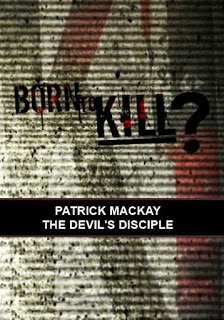 Patrick Mackay
Patrick MackayDartford-based Patrick Mackay learned nothing from his drunken, violent father except how to bully the weak.
When his father died in 1962, 10-year-old Patrick duly took on the role of chief-abuser of his mother and sisters. As he progressed into his teens, he threw his net wider, beating other children, stealing, torturing animals and serving time in juvenile detention. When he entered adulthood in the early 1970s, he moved to London, where he developed such a fascination with Nazism that he nicknamed himself Franklin Bolvolt 1st and started collecting SS memorabilia. It was also around this time when the hulking Mackay is believed to have commenced a series of brutal home-invasion murders, primarily targeting senior citizens.
Mackay was finally captured in 1975, when one of the victims, an elderly Roman Catholic priest, who he hacked to death with an axe, was remembered as being someone he’d had altercations with previously. Mackay bragged that he’d murdered 11 OAPs (including a tramp, who he claimed to have thrown from a railway bridge), was actually suspected of at least 12 such murders, but was only convicted of manslaughter through diminished responsibility. Nevertheless, he received a full-life sentence, which he is still serving.
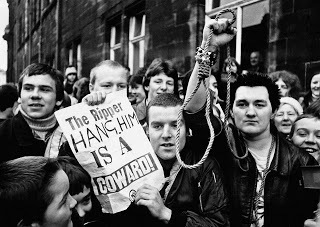 The Yorkshire Ripper
The Yorkshire RipperBingley-born lorry driver, Peter Sutcliffe, aka the ‘Yorkshire Ripper’, started his reign of terror in 1969, when he assaulted a Bradford prostitute with a stone loaded in a sock. Other attacks followed in 1975, Sutcliffe approaching lone women at night, striking them with blunt instruments and stabbing them, though in the first four cases his victims survived, albeit severely injured.
The deaths began that October, when, armed with a hammer and sharpened screwdriver, and having refined his modus operandi – he now struck from behind, fracturing the skull first and then repeatedly puncturing the dazed victim’s body! – he struck down Leeds woman, Wilma McCann. From here, the brutality escalated, at least 12 more women dying in cities across Yorkshire, and even over the Pennines in Manchester.
He was arrested in 1981, when two uniformed officers became suspicious about the false plates on his car. After a case that had panicked the public, which was misdirected by a chilling but hoax taped confession, and which saw the West Yorkshire police severely criticised, the trial was understandably a sensation, Sutcliffe claiming that God had charged him to kill prostitutes, but ultimately failing to avoid a full-life prison sentence.
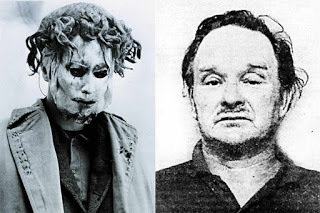 The Beast of Jersey
The Beast of JerseyIn 1960, the holiday idyll of Jersey, in the Channel Islands, was plunged into a living nightmare, when a nocturnal assailant clad in spiked wristlets and wearing a rubber horror mask, began breaking into lone houses, and raping and sodomising the women and children he found there.
In the ensuing terror, false accusations flew thick and fast, and in one instance an innocent French fisherman was hounded off the island, even though police suspicion of him proved to be unfounded.
The Beast’s ferocious rampage continued until 1971, when uniformed officers pursued a car running a red light, and collared Edward Paisnel, a formerly respected islander who’d previously been seen as a pillar of the community. Despite Paisnel’s denials, the evidence was strong: part of the horror costume was found in his car, and later examination of his cottage uncovered a black magic altar in an outbuilding, where rumour held that he’d been sacrificing animals to Satan.
Sentenced to 30 years in prison, he attempted to return to Jersey on his release, but such was the hostility of locals, that he left again, dying on the Isle of Wight in 1994. Stories connecting him with historic child abuse at the Haut de la Garenne children’s home are thought to be wide of the mark.
 The Cambridge Rapist
The Cambridge RapistPeter Samuel Cook was a prolific burglar, an expert house-breaker, who in October 1974 switched to rape when he encountered a young woman in a student’s hostel in Cambridge, and violently overpowered her.
Between then and the following spring, he repeatedly broke into student accommodation in the city which he’d identified as housing single female occupants.
His attacks were appallingly brutal, but were made more terrifying by his method: he used weapons and wore a chilling costume which included a slit-eyed, zipper-mouthed leather mask with the word ‘Rapist’ inscribed across the forehead.
In fact, so much did Cook come to enjoy the monstrous persona he’d created for himself that he began to take risks. For instance, if a proposed break-in failed, he would write messages on the windows of his intended victims’ bedrooms, such as: ‘Sleep tight – the Rapist’. This caused even greater fear in the city, but left the police with evidence of his handwriting.
He made some efforts to protect himself, such as attaching false hair and a beard inside his mask, but ultimately Cook was captured fleeing the scene of his last crime on a bicycle. His life term was fulfilled when he died in prison in 2004.
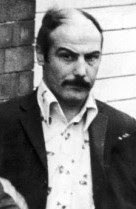 Trevor Hardy
Trevor HardyOne of Britain’s lesser-known serial killers, Trevor Hardy, aka ‘the Beast of Manchester,’ had the potential to rock the country in the same way the Yorkshire Ripper would a couple of years later, but the police were onto him quickly and, though the enquiry was widespread in the city, it was kept relatively low-key.
That said, Hardy, a Manchester native well known for his violent temper (and for his ability to brutalise men, let alone women), still claimed three lives – and in horrible fashion. Between 1974 and 1976, he murdered three teenage girls whom he stalked late at night, battering, strangling and sexually assaulting them, and on two occasions, stripping and mutilating the corpses afterwards.
Though he took pains to preserve his liberty – arranging fake alibis with acquaintances and even filing his teeth down so that bite marks on the bodies could not be connected to him – Hardy displayed many of the signatures of traditional predatory sex killers, which ultimately would provide damning evidence in court: he collected gruesome trophies from the victims, and even gave one to a girlfriend as a love token. Imprisoned under a full-life tariff, he died in jail in 2012.
Suspicion that he may have committed other murders has never been successfully pursued.
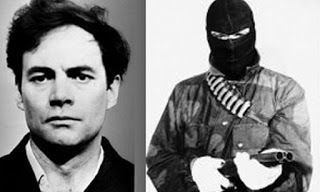 The Black Panther
The Black PantherDonald Neilson was a small businessman from Bradford who most people in the mid-70s wouldn’t have looked at twice, let alone imagined was capable of instigating one of the most terrifying crime-waves in British history.
Because Neilson was also the ‘Black Panther’, a polific burglar and armed robber, who always came masked and wielding a loaded shotgun, and who showed no compunction about murder.
He allegedly turned to crime when his business failed, but if so, he seemed to have no qualms about it. In 1974 alone, he shot and killed four men during burglaries or post office robberies. The crimes occurred as far apart as the West Midlands and Lancashire, the whole country soon living in fear of a merciless offender who attacked with commando precision (Neilson was an ex-soldier).
However, his worst atrocity came in 1975, when he kidnapped 17-year-old heiress, Lesley Whittle, and imprisoned her on a platform deep in a drainage shaft with a wire noose around her neck. Whether she was pushed or fell from the platform through exhaustion, Whittle didn’t survive the ordeal.
Captured later that year by two bobbies, who recognised him from a photo-fit, Neilson went to jail as one of the UK’s most hated criminals, dying there in 2011.
 John Childs
John ChildsIt’s tempting to assume that of all the mass murderer ‘types’ currently hiding in the world’s shadows, the contract killers, while undoubtedly among the most dangerous because of their proficiency, are probably the easiest to understand, as their motive – getting rich – is a common one.
While they might be totally ruthless, the general assumption is that they don’t do what they do simply because they enjoy it. But try telling that to the victims of John Childs, a professional bank robber and London-based hitman who between 1974 and 1978, murdered six people in various ghastly ways, shooting one of them three times, transfixing another with a sword and after hacking a third with an axe and bludgeoning him with a pipe, finishing him off with a garrote.
To make matters worse, not all the victims were gangland figures, indeed one of them was a 10-year-old child who just happened to be in company with his father when the killer struck.
The final horror in the John Childs story is the manner of his disposal of the corpses, all of which, incredibly, were dismembered and then cremated in the fireplace of his sordid East End flat (imagine the foulness of that). Childs is still alive, but serving a full-life jail term.
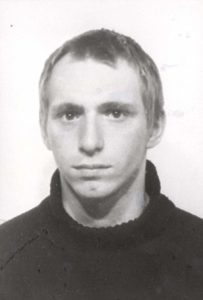 Bruce Lee
Bruce LeeOriginally named Peter Dinsdale – he chose his new name, himself, in homage to his kung-fu fighting hero – Lee had a hellish upbringing. Born in a tough part of Manchester, the epileptic, partially paralysed son of a prostitute, he was mocked, bullied and achieved nothing at school.
He was also a pyromanic, who knew when it was time to light a fire because his ‘fingers tingled’.
Naturally, his favourite targets were occupied premises, like houses and rest homes for the elderly, though the fatal conflagrations only began in 1973, when he was 13 and living in Hull. In total, he lit nine fatal house-fires between then and 1980, burning to death 11 elderly men in one attack, and a young mother and her three sons in another. In total, 26 people died at the arsonist’s hands.
His method wasn’t especially clever, the flames often struck after he poured paraffin through letterboxes and the like (on one occasion he poured it over a victim who was sleeping in an armchair!), which means he was lucky that no criminal action was initially suspected.
Even after he was arrested and confessed, the charge of mass-manslaughter seems generous given that some of his victims were people he had grudges against. In the end, Lee was confined to a mental hospital, with the chilling statement: ‘Fire is my master’.
 The Cannock Chase Murders
The Cannock Chase MurdersIn the late 60s, with the shock of the Moors Murders reverberating around the UK, a new child-murderer was already on the prowl.
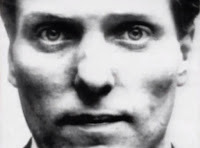 To all intents and purposes, Raymond Leslie Morris was not your typical sex-offender (if such a thing exists).
To all intents and purposes, Raymond Leslie Morris was not your typical sex-offender (if such a thing exists).A handsome, brighter-than-average family man, he had a good job and lived in a suburban corner of Walsall. But he had a secret dark side; he habitually made unacceptable sexual demands of the women in his life, and had an alarming predilection for very young girls.
Between 1965 and 1967, he coaxed three of them – nine, six and five – into his car while they were en route to school, and then assaulted and suffocated them. Their bodies were afterwards abandoned on open land at Cannock Chase, kick-starting a massive police investigation, which saw a facial composite used for the first time ever in a British police enquiry (apparently closely matching the killer’s actual looks).
Traced in 1968 after an unsuccessful fourth abduction, Morris was finally convicted of one murder (but still believed responsible for the other two), and sentenced to life without parole. A fourth child-murder has often been attributed to him, but was never proved. Morris died in prison in 2014.
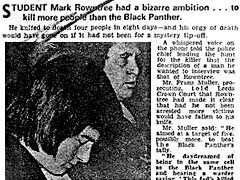 Mark Rowntree
Mark RowntreeAs if the West Yorkshire police weren’t having enough trouble in the mid/late 1970s coping with the crimes of the Yorkshire Ripper, a second serial killer was also trawling the same patch at the same time.
In fact, some of the murders committed by paranoid schizophrenic Mark Rowntree were, for a brief period at least, considered to have been committed by the Ripper himself, and at the very least were a distraction to the enquiry.
Rowntree’s specific hunting ground was Bingley, and between 1975 and 1976 he committed four savage but random murders. In two of them, he forced entry to private premises, stabbing to death the occupants, a woman alone and a woman and her three-year-old son, and in another fatally attacking a teenage boy waiting at a bus stop.
When finally apprehended, after people who knew him recognised a description that had been circulated by the police, Rowntree appeared to be resigned to his fate, but expressed regret that he'd only claimed four lives – he had hoped to emulate his idol, the Black Panther, whose total was five.
On conviction, he was confined in Rampton Hospital, and is now one of the longest-serving psychiatric patients in any of Britain’s high-security asylums.
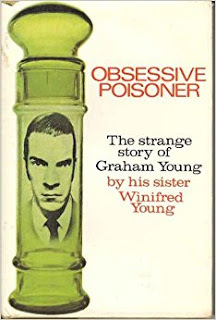 Graham Young
Graham YoungEver since his childhood, North Londoner Graham Young had been fascinated by dangerous chemicals, and as part of this obsession, spent many of those years testing poisons on his family.
At first no-one suspected anything, assuming that the Youngs were simply unlucky with stomach viruses. However, when Graham’s stepmother died in 1962, an investigation uncovered belladonna, and the culprit was sent to Broadmoor Secure Hospital. Nine years later, he was pronounced cured and released, even though he had spent his time inside refining his skill to the point where he could extract cyanide from laurel leaves, and even used this method to kill fellow inmate, John Berridge.
It was now 1971, and Graham found work at the John Hadland Laboratories in Hertfordshire, where he promptly began administering thallium via the canteen tea-urn. At least 70 of his fellow-workers became seriously ill, two of them dying. When his home was searched, the police found various toxic substances and a detailed log in which Young kept records of the doses he’d dealt and his feelings about whether those stricken deserved to live or die.
In 1972, ‘the Teacup Poisoner’, as the press dubbed him, went to prison for life, dying in his cell in 1990.
 The Monster Butler
The Monster ButlerIn the case of Archibald Hall, the butler really did do it, and more than once.
In a story that sounds as if it comes from a ‘village green’ murder mystery, Glasgow-born Archie Hall, a career criminal, who during his early years in the 1960s specialised in petty theft, had always fancied himself the debonair type, and so in the 1970s found richer pickings by hiring himself to the landed gentry as a butler.
His first murder occurred in 1977, when he shot and killed a rival villain who was endangering his position on the Highland estate where he was working. He moved south, attempting to escape his past, but violence seemed to follow him. Later that year, with the assistance of his on/off lover, Mary Coggle, he beat and suffocated his elderly employers, the Scott-Elliotts, in order to rob them. Later that day, in a row over the loot, he murdered Coggle the same way.
He killed again the following Christmas, this time his own brother, Donald, who was becoming suspicious of his new-found wealth. However, Hall attracted attention while trying to dispose of Donald’s body and was arrested in early 1978.
He died in 2002 at age 78, the oldest prisoner in the UK to still be serving a full-life sentence.
THRILLERS, CHILLERS, SHOCKERS AND KILLERS …
An ongoing series of reviews of dark fiction (crime, thriller and horror novels) – both old and new – that I have recently read and enjoyed. I’ll endeavour to keep the SPOILERS to a minimum; there will certainly be no given-away denouements or exposed twists-in-the-tail, but by the definition of the word ‘review’, I’m going to be talking about these books in more than just thumbnail detail, extolling the aspects that I particularly enjoyed … so I guess if you’d rather not know anything at all about these pieces of work in advance of reading them yourself, then these particular posts will not be your thing.
 BLOOD AXE
BLOOD AXE
by Leigh Russell (2015)
It all starts very unthreateningly, when a replica Viking battle-axe is stolen during a semi-comic re-enactment of a Dark Ages battle in the grounds of Clifford’s Tower in the grand old city of York. It’s not the kind of thing that would normally require the deductive skills of an experienced copper like DI Ian Peterson, and in truth, he treats the whole thing light-heartedly.
Peterson is a relatively recent arrival in York, having relocated from Kent to obtain his much sought-for promotion, but while he himself is intrigued by the ancient city, and determined to try and enjoy its many olde worlde treasures, his wife Beverly isn’t quite as sold. She feels a long way from home, she misses her family and friends, and although she and Peterson have been together for quite a while now, she is increasingly uninterested in his job and shows progressively less concern for the responsibilities it demands of him. At present, the duo are living an uneasy kind of truce, though to be fair, this isn’t helped by Peterson’s workaholic nature. Even when there is relatively little for him to investigate, he manages to spend many, many hours at the office, dotting every i and crossing every t.
So, imagine the domestic strife that will ensue when a series of horrific murders suddenly commences. And by horrific, I mean horrific.
Yes, York, that handsome, atmospheric town in the scenic Yorkshire wolds, famous for its history, its archaeology, its excellent shopping, and its fine, old-fashioned English cuisine, is suddenly the hub of a bloody murder spree, wherein the victims – who’ve apparently been chosen indiscriminately – are literally axed to death.
Peterson, acting under the orders of the fearsome DCI Eileen Bullock, is immediately assigned to the case, and tackles it in his usual workmanlike way, aided and abetted by his trusty sidekick, Ted Birling, but impeded a little bit by the impulsive and somewhat overconfident Naomi. The problem though, is not Peterson’s hit-and-miss colleagues, but the killer, who despite his ferocity, comes and goes like a ghost, leaving scarcely a clue and not pursuing any pattern that even hints at his motivation.
In this regard, we readers are one or two steps ahead of Peterson, because we at least have the ‘pleasure’ of witnessing these graphic crimes, on each occasion slipping into the mind of a complete lunatic, who prowls the city’s byways after dark acting out an insane Viking fantasy in which murder and pillage are the only items of interest and where every stranger on the street is fair game. And no, just in case you’ve got a weak stomach, we are not spared the actual destruction that inevitably follows: the swinging of the mighty axe, the sundering of skulls, the lopping of limbs.
This is grim and grisly stuff, which unsurprisingly leads to a frenzy in the once-happy city, increasing Peterson’s workload to the point where it almost breaks him. Even though he makes the connection to the stolen axe at the beginning, and works with helpful staff at the Jorvik Centre, like Ralph Grey and Sophie James, to establish that he’s following a latter-day Norseman, there are so few real leads that – if for no other reason than to keep his spirits up – he consults with former boss and ace detective in her own right, DI Geraldine Steel.
Many crime fans will recognise this name, Steel having been Peterson’s mentor during a former series of books, in which she was the star of the show and he her humble sergeant. However, this is only really a guest-appearance. Blood Axe is very firmly a DI Peterson investigation, and one he’s soon under intolerable pressure to wrap up, not just to save further innocent bodies from the Viking axe – the severed corpses don’t half stack up in this one! – but also to save his own job, and maybe even his marriage, because it’s anyone’s guess how long the self-centred Beverly is going to tolerate the continued absence of her husband in what, at times, seems like a completely futile quest …
One of the most refreshing aspects of the DI Ian Peterson novels is the nature of the hero. Yes, these are solid police procedurals, but Peterson is quite different from the norm. He’s not moody, he’s not a drinker, he’s not damaged in some mysterious, indefinable way which no doubt will all come out eventually. In truth, he’s an everyman, a copper’s copper, one of those methodical, hardworking detectives who most likely account for the majority of real-life CID officers in the UK, and are almost routinely classified as ‘married to the job’.
In Peterson’s case, this hasn’t entirely been to his advantage. For example, he doesn’t have much time for romance or even a social life. So, while he’s sharp-eyed and deeply analytical, his people skills are not the best; he’s awkward in his dealings with the public, he handles suspects and witnesses brusquely, he’s not much fun at parties, and most discomfortingly of all for the reader, he has no clue that his marriage is going downhill fast, even though it’s happening right under his nose.
His wife, Bev, is being neglected on an epic scale. That said, she’s a none-too-sympathetic character in my eyes; she surely knew what she was getting into when she married a copper, and it can hardly have escaped her notice that an axe-murderer is prowling York, and that her husband is charged with capturing him – though this unreasonableness on Bev’s part does serve the useful purpose of making our harassed hero even more vulnerable and appealing.
The story itself runs convincingly and at pace, Peterson and his team working their way with much frustration through a complex web of misleading information, making repeated false starts, heading down blind alleys and the like, while confronted by a range of ‘persons of interest’ and falling out among themselves as to which of these is the most viable – and all of this amid the chaos of bereaved and very credibly distraught relatives, and of course a growing media panic.
It’s all quite effective and believable, the lovely city of York in virtual lockdown by the end of the book, its tourism-based economy seriously imperilled.
And it’s easy to see how that could happen. Any kind of serial killer is a genuine nightmare, not just for the police but for the general population of whichever area is being terrorised, but an axe-murderer who seemingly picks his targets at random has got to be the most awful creature of all. With real-life cases of this sort – the Mad Axeman of New Orleans and the Cleveland Torso Murderer – you only need to look at the newspaper reports of the time to see what a devastating effect they had on local communities, and how people literally would not leave their homes day or night, keeping doors and windows closed and locked despite stifling summer heat.
In the case of York, a great setting for all kinds of reasons, not least its quaintness, and which is rarely the stamping ground of maniacs even in crime fiction, it is all the more portentous – because this scenic old city wasn’t always quaint. In the Dark Ages, when York was called Jorvik, it was the Viking capital of Northumbria, and the city is alive even today with memories of that wild, barbarous breed, who saw war, conquest and the ruthless killing of their foes as the surest way to reach Valhalla. In fact, the 10th century Viking warlord, Eric Bloodaxe – and he wasn’t given that name because of his meek and retiring nature – ruled twice from York as King of Northumbria.
Leigh Russell plays this card very nicely indeed, not delving too deeply into Viking culture or mythology – after all, this is the Viking world as perceived by someone who’s mentally ill – though during those brief interludes when we’re on the road with the killer, we wield our axe with pride, view the local population as sheep waiting to be sheared, and enjoy the violence of our attacks as much, if not more so, than we do the acquisition of our victims’ wealth.
The book first caught my eye because of this unusual premise. In truth, I wasn’t initially sure that it would work – bringing Northman-style violence to a modern UK city – but the moment I got into it, I lost all qualms. This is heady stuff, very scary in parts and also pretty gory. But it makes for a damn good, and I have to say, quite easy and straightforward read. It also ends on a big, unexpected twist, so it comes highly recommended for all fans of murder mysteries and police procedurals.
I’ve heard some gossip that the investigations of Geraldine Steel and Ian Peterson have been optioned for TV development, which, if it comes to fruition, will be good news indeed. However, as always, I’m going to try and get there first by nominating my own cast should Blood Axemake it to the screen. Here we go:
DI Ian Peterson – Andrew LincolnDI Geraldine Steel – Kate BeckinsdaleBeverley Peterson – Kelly MacdonaldRalph Grey – Brian F O’ByrneSophie James – Jennie Jacques
Imagery: The Moors Murders search pic comes from the Evening Standard; the Bible John pic comes from Media Scotland; the Patrick Mackay screen-grab comes from the Twofour Productions documentary series, Born to Kill; the Ripper crowd image comes from the Huddersfield Daily Examiner; the Black Panther pic comes from the Birmingham Mail.
Published on August 06, 2017 08:22
July 17, 2017
At last, the reading season is finally here
 Okay, summer is finally turning glorious, and for me that usually means two things, often both at the same time: travelling and reading.
Okay, summer is finally turning glorious, and for me that usually means two things, often both at the same time: travelling and reading.
I mean, don’t get me wrong … I read all the time, but for some reason, whenever I’m on my holidays (or vacation, as they call it Stateside), getting my head into a good book seems to come a lot more easily.
Maybe I’m more relaxed then, I don’t know – but when I’m settled in the sunshine, I can literally motor through novels (14 last August!). For which reason, I thought today might be an opportunity to showcase my planned reads for this summer.
I mentioned 14, so, maybe somewhat ambitiously, I should list the 14 novels coming up next on my reading list, though in one of those cases, I’ve already jumped the gun.
SIEGE, by that master of the explosive action-thriller, Simon Kernick, was supposed to be on the to-read list with all the others, but as I’ve already gone and read it, I’m today going to review and discuss that one instead.
As usual, you’ll find it at the lower end of today’s column.
 But before we get to that, a quick word about one of my own books, which I hope a few folk might be interested in choosing for their own pile of summer reads.
But before we get to that, a quick word about one of my own books, which I hope a few folk might be interested in choosing for their own pile of summer reads. STRANGERS , my first outing for DC Lucy Clayburn, hit the bookshelves in September last year and is still selling well, I’m glad to say. But just in case you missed it the first time round, here’s a quick reminder that the Kindle version – which you can get HERE – is 99p for the duration of this summer period.
Anyway, back to the books I myself want to read and will be doing very soon. Here they are, in no particular order. I make no apologies for the fact that some of them are not exactly new releases. I discover books and authors all the time, and never have any hesitation picking something up from the past if I like the look of it. You’ll also notice that this list doesn’t just consist of crime, thriller and/or horror fiction. Okay, most of it is, but I like to think I have a reasonably diverse taste, and lots of different boxes which need ticking come the summertime.
But enough of the prelims, let’s go …
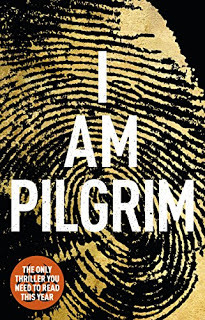 I AM PILGRIM
I AM PILGRIM
To thoroughly satisfy my cravings for a big, international conspiracy thriller, I’m opting first for Terry Hayes’ I AM PILGRIM . Okay, I know I should have read this modern classic already by now, but what can I say? ... I’m a busy guy. Anyway, what better way to kick off the summer reading season?
Here’s the official blurb:
A young woman murdered in a run-down Manhattan hotel.
A father publicly beheaded in the blistering sun of Saudi Arabia.
A man’s eyes stolen from his living body as he leaves a secret Syrian research laboratory.
Smouldering human remains on a mountainside in the Hindu Kush.
A plot to commit an appalling crime against humanity.
One thread that binds them all.
One man to take the journey.
Pilgrim.
 A HEAD FULL OF GHOSTS
A HEAD FULL OF GHOSTS
Horror takes many forms these days, and there are always a number of different categories that I find I need to check out. First up, I’m usually in need of at least one psychological horror fix per year, and this year I’m going for another book I should have read by now. It’s Paul Tremblay’s intriguing-sounding 2015 title, A HEAD FULL OF GHOSTS .
Here’s the official blurb:
The lives of the Barretts, a suburban New England family, are torn apart when fourteen-year-old Marjorie begins to display signs of acute schizophrenia. To her parents’ despair, the doctors are unable to halt Marjorie’s descent into madness. As their stable home devolves into a house of horrors, they reluctantly turn to a local Catholic priest for help, and soon find themselves the unwitting stars of The Possession, a hit reality television show.
Fifteen years later, a bestselling writer interviews Marjorie’s younger sister, Merry. As she recalls the terrifying events that took place when she was just eight years old, long buried secrets and painful memories begin to surface – and a mind-bending tale of psychological horror is unleashed.
 THE DEEP
THE DEEP
Oceanic horror is another subgenre for which I must seek at least one annual fix, and it’s usually at around this time of year with a holiday abroad beckoning. One of my other favourite past-times when I’m in a hot climate is sea-swimming, and you know, there’s surely no better way to enjoy the chill of deep blue water beneath your feet than when you’re also thinking about the latest book of sea-horror that you’ve read. For this one, I’ve opted for Michaelbrent Collings’s much lauded novel of 2015, THE DEEP .
Here’s the official blurb:
A woman searching for a sister lost at sea.
A man bent on finding lost treasure.
A mother who has lost all hope.
A maniac who believes all life exists for his pleasure.
The man who would keep them all safe.
Together, they will all seek below the waves for treasures long buried, and riches beyond belief.
But those treasures hide something. Something ancient, something dark.
A creature that exists only to feed on those that would enter its realm.
A creature … of THE DEEP.
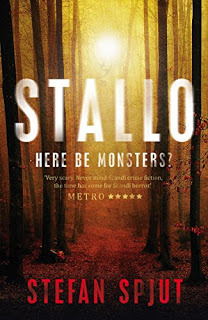 STALLO
STALLO
On the subject of horror, you can’t beat a good creature feature. Oh yes, I like a monster or two, and this next choice has come highly recommended. If you like your Scandi-noir, but fancy taking it even further into the realms of darkness, check out Sefan Spjut’s STALLO .
Here’s the official blurb:
In the late 1970s, a young boy disappears from a summer cabin in the Swedish woods. His mother claims that he was abducted by a giant. The boy is never found.
Twenty-five years later, an old woman claims that a creature has been standing outside her house, observing her and her five-year-old grandson for hours.
When Susso – who’s dedicated her life to the search for creatures whose existences have not been proved – hears of this, and sees a possible link between the two incidents, she takes the road on a terrifying adventure into the unknown …
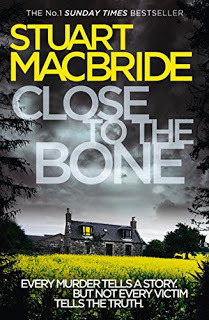 CLOSE TO THE BONE
CLOSE TO THE BONE
Crime thrillers that are dark, dirty and dingy are pretty much home territory for me, so you might think I’d get jaded on the matter, but not a bit of it. No reading list of mine would be complete without at least one piece of Brit-grit to get my teeth into. For that vibe, I’m going to one of the genre’s total bosses, Stuart MacBride, and his 2013 hit, CLOSE TO THE BONE .
Here’s the official blurb:
Sticks and stones may break your bones …
The first body is chained to a stake: strangled and stabbed, with a burning tyre round its neck. Is this a gangland execution or something much darker?
Someone’s leaving little knots of bones on DI Logan McRae’s doorstep, but he’s got bigger concerns. Rival drug gangs are fighting over product and territory; two teenage lovers are missing; someone’s crippling Asian immigrants; and Logan’s been lumbered with an ambitious new Detective Sergeant and gained the unwelcome attention of the new local crime boss.
When another body turns up, the similarities between these murders and the plot of a bestselling novel seem like more than coincidence. And perhaps those little knots of bones are more important than they look …
 THE FORCE
THE FORCE
I absolutely adore frank, tough-talking cop stuff; hard-hitting police stories that are as much about the worn-out personnel as the vicious villains they encounter, and in which no-one is any better than they need to be. This year, there was only one choice on that front, Don Winslow’s epic 2017-release, THE FORCE .
Here’s the official blurb:
Detective Sergeant Denny Malone leads an elite unit to fight gangs, drugs and guns in New York. For eighteen years, he’s been on the front lines, doing whatever it takes to survive in a city built by ambition and corruption, and where no-one is clean.
What only a few know is that Denny Malone himself is dirty; he and his partners have stolen millions of dollars in drugs and cash. Now he’s caught in a trap and being squeezed by the Feds. He must walk a thin line of betrayal, while the city teeters on the brink of a racial conflagration that could destroy them all.
Don Winslow’s latest novel is a haunting story of greed and violence, inequality and race, and a searing portrait of a city on the edge of an abyss. Full of shocking twists, this is a morally complex and riveting dissection of the controversial issues confronting society today.
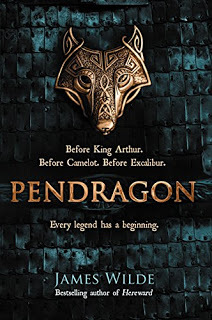 PENDRAGON
PENDRAGON
The historical-actioner is a genre I don’t delve into enough, but every so often I come across titles that I know I simply MUST push to the top of my reading list. This summer, there are two in particular that I aim to sample. They come to us almost from the opposite ends of history, but both of them promise battles and bloodshed galore, and really, if you’re still a lad at heart, what more could you ask.
The first of these is the brand new one from James Wilde (aka Mark Chadbourn), PENDRAGON .
Here’s the official blurb:
Winter AD 367, and in a frozen forest beyond Hadrian’s Wall, six scouts of the Roman army have been brutally murdered.
Their mutilated bodies were discovered by an elite unit led by Lucanus. Also called the Wolf, he knows the far north to be a foreign land, a wild place ruled by barbarians, inhabited by daemons and witches – a place where the old gods live on. It is not somewhere he would willingly go and to him this ritual slaughter reeks of something altogether more dangerous.
But when the child of a friend is taken captive, Lucanus feels honour-bound to journey beyond the wall and bring the boy back home. He is not alone. For this is a quest that will span an empire – from the pagan monument of Stonehenge to the kingdoms of Gaul and the eternal city of Rome itself – a search that will embroil a soldier and a thief, a cut-throat and a courtesan, a druid and even the great Emperor Valentinian. And what is revealed will reverberate down the centuries …
From the best-selling author of Hereward, comes an epic new historical adventure of betrayal and bloodshed set during the bleakest of times – a time when civilisation itself was foundering, when the world faced a dark age and was in need of a hero.
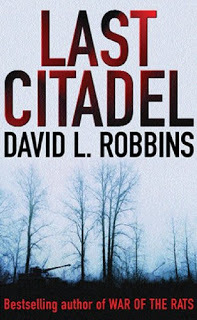 LAST CITADEL
LAST CITADEL
The second of my chosen historical reads is likely to take an even grimmer tone, and if anything, is set at a point in history when civilisation was even more likely to collapse in flames. It’s David L. Robbins’ masterly 2004 WW2 novel, LAST CITADEL .
Here’s the official blurb:
One nation taking a desperate gamble of war.
Another fighting for survival.
Two armies locked in a bloody cataclysm that will decide history …
Spring 1943. In the west, Germany strengthens its choke-hold on France. To the south, an Allied invasion looms imminent. But the greatest threat to Hitler’s dream of a Thousand Year Reich lies east, where his forces are pitted in a death match with a Russian enemy willing to pay any price to defend the motherland. Hitler rolls the dice, hurling his best SS forces and his fearsome new weapon, the Mark VI Tiger tank, in a last-ditch summer offensive, codenamed Citadel.
The Red Army around Kursk is a sprawling array of infantry, armour, fighter planes, and bombers. Among them is an intrepid group of women flying antiquated biplanes; they swoop over the Germans in the dark, earning their nickname, ‘Night Witches’. On the ground, Private Dimitri Berko gallops his tank, the Red Army’s lithe little T-34, like a Cossack steed. In the turret above Dimitri rides his son, Valya, a Communist sergeant who issues his father orders while the war widens the gulf between them. In the skies, Dimitri’s daughter, Katya, flies with the Night Witches, until she joins a ferocious band of partisans in the forests around Kursk. Like Russia itself, the Berko family is suffering the fury and devastation of history’s most titanic tank battle, while fighting to preserve what is sacred – their land, their lives, and each other – as Hitler flings against them his most potent armed force.
Inexorable and devastating, a company of Mark VI Tiger tanks is commanded by one extraordinary SS officer, a Spaniard known as la Daga, the Dagger. He’d suffered a terrible wound at the hands of the Russians: now he has returned with a cold fury to exact his revenge. And above it all, one quiet man makes his own plan to bring Citadel crashing down and reshape the fate of the world.
A remarkable story of men and arms, loyalty and betrayal, Last Citadel propels us into the claustrophobic confines of a tank in combat, into the tension of guerrilla tactics, and across the smoking charnel of one of history’s greatest battlefields. Panoramic, authentic, and unforgettable, it reverberates long after the last cannon sounds.
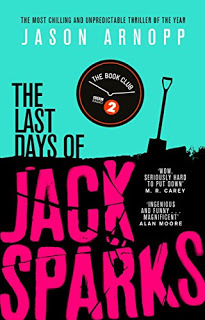 THE LAST DAYS OF JACK SPARKS
THE LAST DAYS OF JACK SPARKS
I’ve always been a sucker for demonic/occult horror. It’s a well-trodden path in literary terms, of course, but there is never any shortage of new material. So, to tick this particular box, I’m opting for Jason Arnopp’s THE LAST DAYS OF JACK SPARKS , which came out last year.
Here’s the official blurb:
Jack Sparks died while writing this book.
It was no secret that journalist Jack Sparks had been researching the occult for his new book. No stranger to controversy, he had already triggered a furious Twitter storm by mocking an exorcism he witnessed.
Then there was THAT video: forty seconds of chilling footage that Jack repeatedly claimed was not of his making, yet was posted from his own YouTube account.
Nobody knew what happened to Jack in the days that followed – until now.
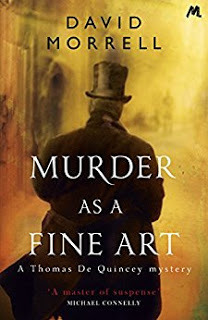 MURDER AS A FINE ART
MURDER AS A FINE ART
One field that often straddles both the thriller and horror genres is the Victorian murder mystery – you only need to think cloaked, top-hatted forms gliding through gas-it fog, and we’re there, aren’t we? – and though once again, it’s not a literary field I delve into regularly, I certainly couldn’t resist David Morrell’s 2013 novel, MURDER AS A FINE ART .
Here’s the official blurb:
The Ratcliffe Highway murders of 1811 were the most notorious mass killings of their day. Never fully explained, they brought London and all of England to the verge of panic.
Forty-three years later, the equally notorious ‘opium-eater’ Thomas de Quincey returns to London. Along with his 'Confessions', he is known for a scandalous essay about the killings: ‘On Murder Considered as One of the Fine Arts’.
Days after his arrival, a family is killed in the same horrific way as the earlier murders. It seems someone is using the essay as an inspiration – and a blueprint. And De Quincey himself is the obvious suspect. Aided by his daughter, Emily, and two determined Scotland Yard detectives, he must uncover the truth before more blood is shed … and London itself falls prey to attack.
In Murder as a Fine Art, gas-lit London becomes a battleground between a literary star and a demented murderer - whose lives are linked by secrets long buried, but never forgotten.
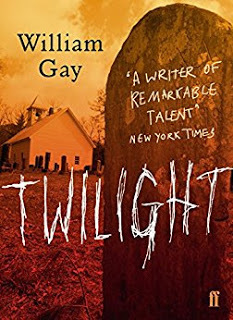 TWILIGHT
TWILIGHT
Another subgenre that straddles several of my interests at once is that of the Rural Noir/Southern Gothic (whatever you want to call it). Often poetic, invariably dark, frequently grotesque, I find myself needing to hit at least one of these normally exquisitely-written novels each year. This year, it’s William Gay’s remarkable 2007 TWILIGHT (not to be confused in any way with all that teen vampire-romance stuff).
Here’s the official blurb:
Suspecting that something is amiss with their father’s burial, teenager Kenneth Tyler and his sister Corrie venture to his gravesite and make a horrific discovery: their father, a whiskey bootlegger, was not actually buried in the casket they bought for him. Worse, they learn that the undertaker, Fenton Breece, has been grotesquely manipulating the town’s dead.
Armed with incriminating photographs, Tyler becomes obsessed with bringing the perverse undertaker to justice. But first he must outrun Granville Sutter, a local strongman hired by Fenton to destroy the evidence. What follows is an adventure through the Harrikin, an eerie backwoods filled with tangled roads, rusted machinery and eccentric squatters – old men, witches, and families among them – who both shield and imperil Tyler as he runs for safety.
Coupling his characteristically poetic and haunting prose with a tightly controlled close narrative, William Gay rewrites the rules of the Gothic fairy tale while exploring the classic Southern themes of good and evil.
 THE STARS MY DESTINATION
THE STARS MY DESTINATION
One area I dip into occasionally (less often than I should perhaps, though more than I used to thanks my never being less than inspired by what I find), is classic-era science fiction. It’s a vast range of titles, of course, so I can only pick from the memories I have of those my late father (a sci-fi buff on an epic scale) personally recommended to me. This summer, it’s Alfred Bester’s big hit of 1956, THE STARS MY DESTINATION (which would make it by far the oldest novel I’ve read and reviewed for this blog).
Here’s the official blurb:
Gully Foyle, Mechanic's Mate 3rd Class.EDUCATION: none
SKILLS: none
MERITS: none
RECOMMENDATIONS: none
That's the official verdict on Gully Foyle, unskilled space crewman.
But right now, he is the only survivor on his drifting, wrecked spaceship, and when another space vessel - the Vorga - ignores his distress flares and sails by, Gully becomes obsessed with revenge. He endures 170 days alone in deep space before finding refuge on the Sargasso Asteroid and returning to Earth to track down the crew and owners of the Vorga. But, as he works out his murderous grudge, Gully Foyle also uncovers a secret of momentous proportions ...
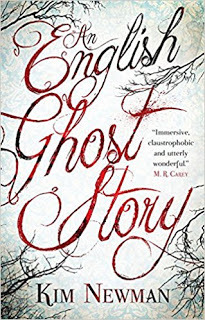 AN ENGLISH GHOST STORY
AN ENGLISH GHOST STORY
Call me old-fashioned, but I’ve always had a soft spot for MR James-style ghost stories … yes, those pleasing supernatural terrors that were aired over brandy and cigars in wood-panelled drawing rooms, usually with the Christmas snow falling outside. I’ve written plenty and I’ve read plenty, though it’s difficult to get this kind of stuff at novel length. Perhaps it was inevitable, therefore, that another choice this year was Kim Newman’s 2015 update on the genre, AN ENGLISH GHOST STORY (and no, it won’t bother me that I’ll be reading it in the Mediterranean sunshine).
Here’s the official blurb:
The Naremores, a dysfunctional British nuclear family, seek to solve their problems and start a new life away from the city in the sleepy Somerset countryside. At first their perfect new home seems to embrace them, its endless charms creating a rare peace and harmony within the family. But as they grow closer, the house begins to turn on them, and seems to know just how to hurt them the most – threatening to destroy them from the inside out.
*
THRILLERS, CHILLERS, SHOCKERS AND KILLERS …
An ongoing series of reviews of dark fiction (crime, thriller and horror novels) – both old and new – that I have recently read and enjoyed. I’ll endeavour to keep the SPOILERS to a minimum; there will certainly be no given-away denouements or exposed twists-in-the-tail, but by the definition of the word ‘review’, I’m going to be talking about these books in more than just thumbnail detail, extolling the aspects that I particularly enjoyed … so I guess if you’d rather not know anything at all about these pieces of work in advance of reading them yourself, then these particular posts will not be your thing.
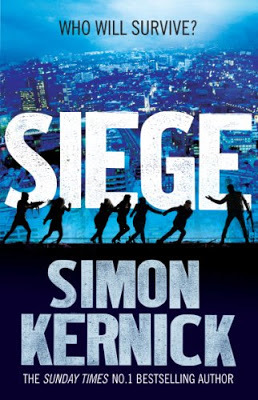 SIEGE
SIEGE by Simon Kernick (2012)
London is a city well-versed in dealing with terrorism, but it’s a sheer impossibility to throw steel around all of its major landmarks. So, when an organised and proficient terrorist outfit launches a military-style attack on the ornate Stanhope Hotel, on Park Lane, the metropolis is taken completely by surprise.
Already preoccupied by a series of diversionary bomb attacks, the authorities are not even there to intervene when a man known only as Fox, an embittered former British soldier and combat veteran, leads a heavily-armed group in a disciplined assault, which captures most of the hotel’s staff and guests almost immediately, closes the building off with booby-traps and explosives, and starts laying down impossible political demands.
A lot of people die quickly, in many cases killed merely to make a point. It’s plain from the outset that these terrorists are playing for keeps, and pretty soon almost the entirety of the Metropolitan Police, not to mention a specialist SAS rescue squad, have got them surrounded.
A colossal siege then follows, a wide range of hostages awaiting its outcome fearfully.
Among these, Polish hotel manager, Elena Serenko, is the strongest, a diplomatic but authoritative figure, who never once loses her cool in the midst of the crisis, and becomes their unofficial spokesperson. Martin Dalston is there too, a forlorn character who has come to the hotel to die; recently diagnosed with inoperable cancer, he intended to commit suicide that evening, but now realises that he doesn’t just want to live, he wants to live and help those around him.
And then there is Scope … in his first outing (Simon Kernick has since written at least one more book following his exploits). Another disenfranchised ex-squaddie, Scope came to the Stanhope looking for vengeance regarding matters unconnected to this affair, but soon got caught up in the mayhem. He manages to lie low in one of the upstairs rooms, and is not corralled by the terrorists, but you sense almost from the beginning that he’s going to become their John McClane, their fly in the ointment, their ultimate pain in the ass.
Outside the hotel, meanwhile, it’s equally tense. The police are under the control of the normally efficient Deputy Assistant Commissioner Arley Dale, though her position is far from straightforward. Unbeknown to everyone else, Dale’s own family were kidnapped that morning by the same terrorists, and she is now under orders to assist the gang by providing misinformation to the military and sending the inevitable SAS assault team to its destruction. Naturally, she doesn’t want to do this, but what choice does she have? Things are further complicated for her when news arrives that a senior MI6 officer, possessing vital information, is among the captives, and by Detective Chief Inspector John Cheney of the Counter Terrorist Command, a cool but inscrutable figure (and, inconveniently, a former boyfriend of hers) who constantly hovers in the background.
The strongest card Dale can play is Riz Mohammed, a London cop of Middle Eastern origin and an expert negotiator. He makes many gallant attempts to talk the terrorists ‘down’, but gains little. This is partly because their motives are far from clear. Though two Arabic figures have now emerged from the murderous band to take charge - their overall leader, Wolf, and his fanatical female sidekick, Cat - the rest of the team, like Fox, are westerners at odds with the British establishment, and though they are brutal and violent, we soon get the feeling they are less interested in the Islamist cause than they are the fabulous pay-out they’ve been promised if everything goes to plan.
It’s a hellish scenario, the authorities all but paralysed, the armed-to-the-teeth madmen killing at every opportunity, but Arley Dale doesn’t just sit there and accept her fate. Again in secret, she enlists a disgraced former-detective, Tina Boyd (another of Kernick’s very cool recurring characters) and puts her on the case. Boyd, a loose cannon at the best of times, doesn’t understand why she’s been trusted with such a job, until Dale, who expects to go to prison anyway, says that she must do whatever’s necessary to recover her missing family – there are no rules.
Scope meanwhile, who initially takes time off to protect an ailing American tourist and her young son, finally decides that he too must take the gloves off. These vicious, arrogant killers are not going to have it all their own way …
Well, this is an absolute corker.
It’s also vintage Simon Kernick, surely one of the UK’s best thriller-writers when it comes to high-level conspiracies, espionage and terrorism.
Make no mistake, this is a big, big story, involving a monstrous and complex crime which has the potential not just to snuff out multiple lives, but to endanger national security as well, and yet as always, the author handles every part of it with astonishing attention to detail, delivering the entire catastrophe in completely authentic and convincing fashion. He deals with the emergency services response in the same way, not putting a foot wrong as he pulls the police and military together, co-ordinating their various assets, including their technical resources (which in Siege are absolutely up-to-the-minute) in the most believable style. It’s almost as if he has personally memorised the section of the Major Incident Manual concerning mass terrorist attacks on London.
As I say, vintage Kernick.
And yet … all this stuff is no more, really, than the backdrop.
The most interesting thrillers are always about people, focussing on their conflicting personalities and relationships no matter what degree of chaos is unfolding around them. And Kernick doesn’t skimp on this. In fact, he gives us an ensemble cast, throwing all kinds of individuals into this maelstrom of gunfire and explosions.
At first, I wondered if this was going to prove to be a mistake; there are so many living, breathing individuals in Siege that I worried it might fall victim to what I call ‘Towering Inferno Syndrome’: in other words, the author gives us a bit of everyone, but not enough of anyone. But no, Simon Kernick is too much of an expert in his field to make that kind of error. Once we’ve met the cast, we quickly close in on the key players, two of the most exciting being Scope and Tina Boyd.
Kernick certainly loves his antiheroes.
Yes, his work is often filled with straight bats like Arley Dale, and procedures and protocols hot from the Scotland Yard press. But quite often – and it’s certainly the case here – things are resolved by the smart thinking and raw courage of wayward individuals who, usually through misfortune, find themselves at the sharp end with minimal backup.
Don’t get me wrong. Earlier in this review, I alluded to Die Hard . And yes, there is more than a hint of that in Siege . But the action here, though fast and tough, is not quite so OTT. There are bombs, machine-gun battles and knife fights galore. But in this book, when people get shot and wounded, they are severely incapacitated at the very least. When they get put down by a heavy punch, they don’t get up quickly. Scope is not a man of iron. He is handy and experienced, but his main strength derives from his dogged nature and moral compass, which he engages regardless of the fine print. Likewise, Tina Boyd. She has had it rough; despite often doing the right thing in the past, she’s been on the wrong end of some politically correct but nevertheless harsh decisions – she is another who’s always prepared to risk it for the right result, and who isn’t just able to take a beating, but who can (and will) dish one out, herself, if necessary.
In balance to all this, the non-violent characters in the book – Elena Serenko and Martin Dalston – are intriguing creations, nicely representing ordinary people at their best (and so often, of course, it is ordinary people who must navigate these terrible situations). They may not believe in have-a-go-heroism, but they’ll still do everything in their power to make things easier for those around them.
On top of all that, despite its massive canvas and huge rotation of characters, the novel is done slickly and quickly, the narrative bouncing from scene to scene at breakneck pace, allowing the reader almost no room to breathe – and yet still finding time to surprise us with curveballs. That’s another of Simon Kernick’s strengths. You never know the whole story; there is nearly always something shocking held in reserve, and Siege is no exception to that rule.
A terrific action-thriller, completely credible, totally enthralling and sadly, in our turbulent current age, more relevant now even than when it was first published.
It’s a bold man who’d try, at a whim, to cast a novel like this should it ever be adapted for the screen, but ‘boldness’ is my middle name. So, as usual, here I go (just for laughs, of course):
DAC Arley Dale – Naomi WattsScope – Robert James-CollierElena Serenko – Izabella MikoFox – Clive StandenTina Boyd – Gemma ArtertonWolf – Naveen AndrewsCat – Shiva NegarDCI John Cheney – Ray StevensonMartin Dalston – Hugh GrantRiz Mohammed – Cas Anvar
Published on July 17, 2017 09:00



